Travel and Tourism Research Project
VerifiedAdded on 2023/06/11
|42
|8882
|368
AI Summary
The discourse of the study identifies the different perspectives of relations for interest in dark tourism in Highgate Cemetery, London. The study will be able to identify the main factors/motivators for individuals visiting places associated to dark tourism. The significant responses of the individuals have been considered both in general perspectives and Highgate Cemetery.
Contribute Materials
Your contribution can guide someone’s learning journey. Share your
documents today.
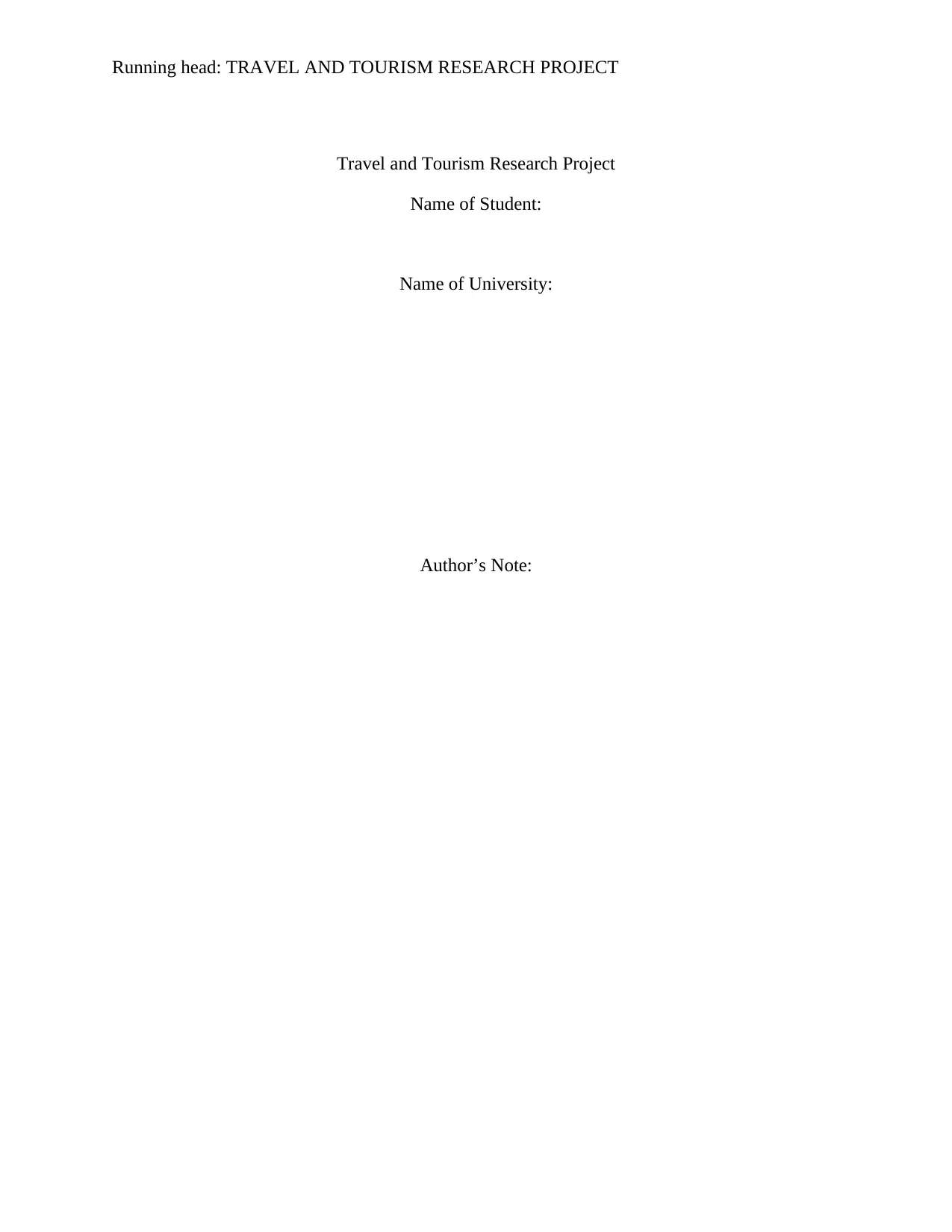
Running head: TRAVEL AND TOURISM RESEARCH PROJECT
Travel and Tourism Research Project
Name of Student:
Name of University:
Author’s Note:
Travel and Tourism Research Project
Name of Student:
Name of University:
Author’s Note:
Secure Best Marks with AI Grader
Need help grading? Try our AI Grader for instant feedback on your assignments.
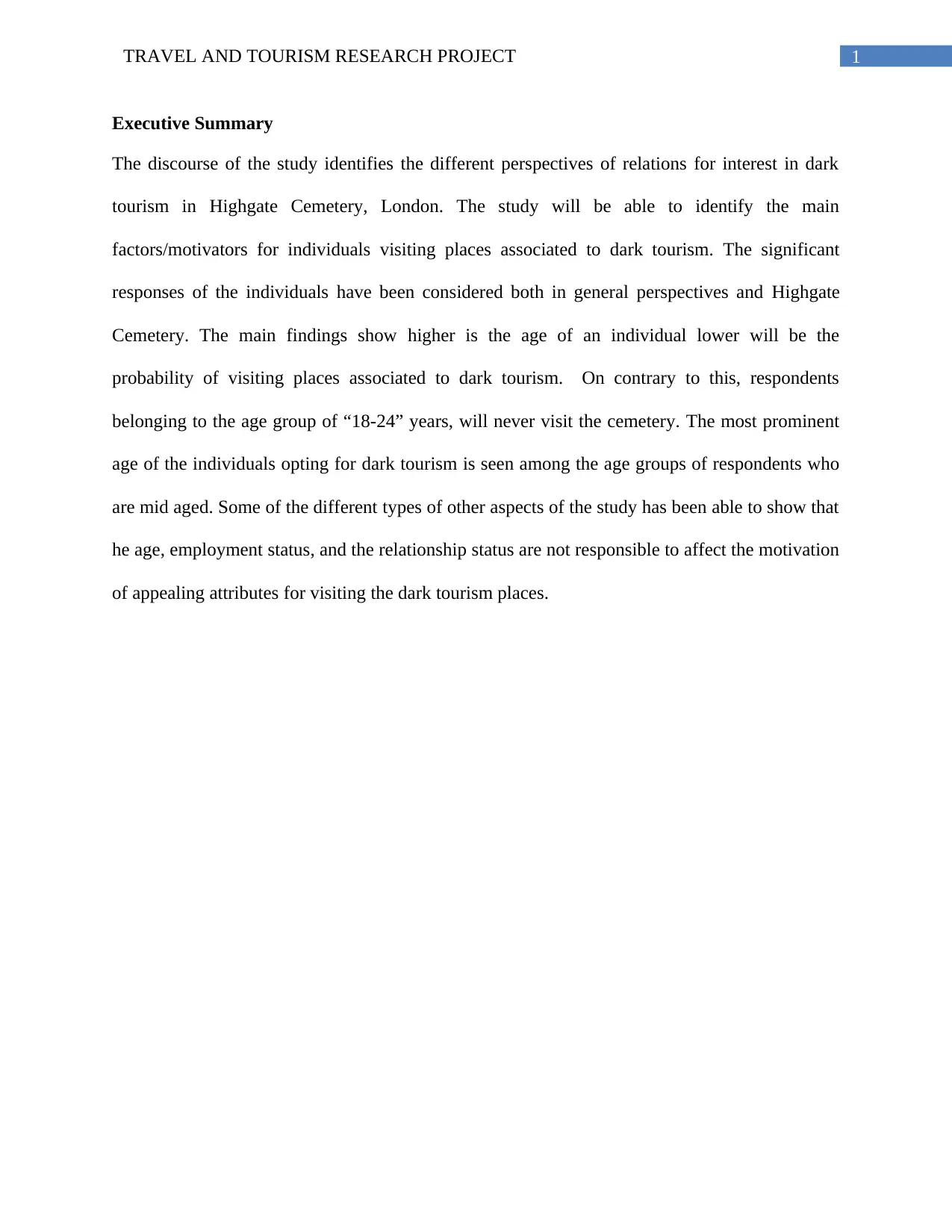
1TRAVEL AND TOURISM RESEARCH PROJECT
Executive Summary
The discourse of the study identifies the different perspectives of relations for interest in dark
tourism in Highgate Cemetery, London. The study will be able to identify the main
factors/motivators for individuals visiting places associated to dark tourism. The significant
responses of the individuals have been considered both in general perspectives and Highgate
Cemetery. The main findings show higher is the age of an individual lower will be the
probability of visiting places associated to dark tourism. On contrary to this, respondents
belonging to the age group of “18-24” years, will never visit the cemetery. The most prominent
age of the individuals opting for dark tourism is seen among the age groups of respondents who
are mid aged. Some of the different types of other aspects of the study has been able to show that
he age, employment status, and the relationship status are not responsible to affect the motivation
of appealing attributes for visiting the dark tourism places.
Executive Summary
The discourse of the study identifies the different perspectives of relations for interest in dark
tourism in Highgate Cemetery, London. The study will be able to identify the main
factors/motivators for individuals visiting places associated to dark tourism. The significant
responses of the individuals have been considered both in general perspectives and Highgate
Cemetery. The main findings show higher is the age of an individual lower will be the
probability of visiting places associated to dark tourism. On contrary to this, respondents
belonging to the age group of “18-24” years, will never visit the cemetery. The most prominent
age of the individuals opting for dark tourism is seen among the age groups of respondents who
are mid aged. Some of the different types of other aspects of the study has been able to show that
he age, employment status, and the relationship status are not responsible to affect the motivation
of appealing attributes for visiting the dark tourism places.
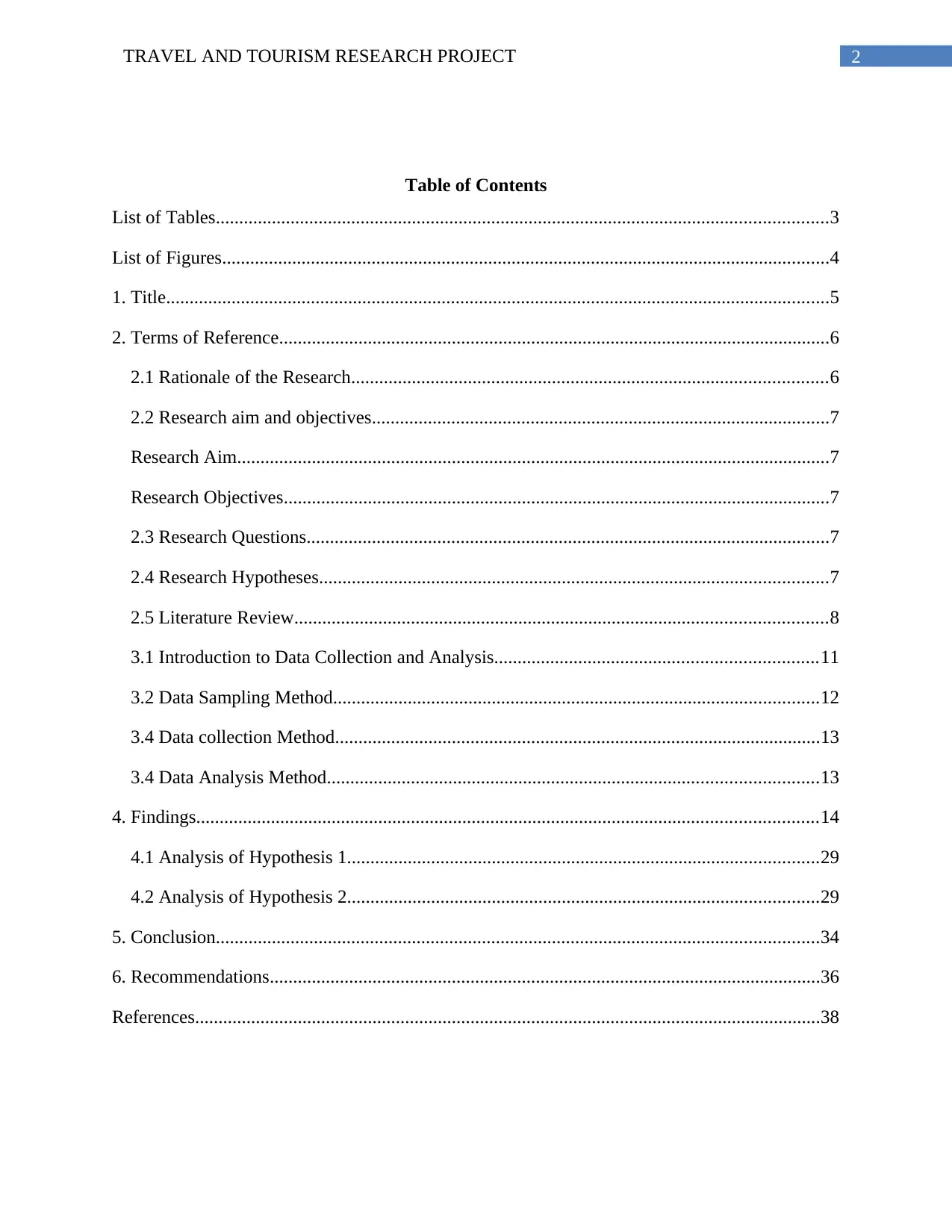
2TRAVEL AND TOURISM RESEARCH PROJECT
Table of Contents
List of Tables...................................................................................................................................3
List of Figures..................................................................................................................................4
1. Title..............................................................................................................................................5
2. Terms of Reference......................................................................................................................6
2.1 Rationale of the Research......................................................................................................6
2.2 Research aim and objectives..................................................................................................7
Research Aim...............................................................................................................................7
Research Objectives.....................................................................................................................7
2.3 Research Questions................................................................................................................7
2.4 Research Hypotheses.............................................................................................................7
2.5 Literature Review..................................................................................................................8
3.1 Introduction to Data Collection and Analysis.....................................................................11
3.2 Data Sampling Method........................................................................................................12
3.4 Data collection Method........................................................................................................13
3.4 Data Analysis Method.........................................................................................................13
4. Findings.....................................................................................................................................14
4.1 Analysis of Hypothesis 1.....................................................................................................29
4.2 Analysis of Hypothesis 2.....................................................................................................29
5. Conclusion.................................................................................................................................34
6. Recommendations......................................................................................................................36
References......................................................................................................................................38
Table of Contents
List of Tables...................................................................................................................................3
List of Figures..................................................................................................................................4
1. Title..............................................................................................................................................5
2. Terms of Reference......................................................................................................................6
2.1 Rationale of the Research......................................................................................................6
2.2 Research aim and objectives..................................................................................................7
Research Aim...............................................................................................................................7
Research Objectives.....................................................................................................................7
2.3 Research Questions................................................................................................................7
2.4 Research Hypotheses.............................................................................................................7
2.5 Literature Review..................................................................................................................8
3.1 Introduction to Data Collection and Analysis.....................................................................11
3.2 Data Sampling Method........................................................................................................12
3.4 Data collection Method........................................................................................................13
3.4 Data Analysis Method.........................................................................................................13
4. Findings.....................................................................................................................................14
4.1 Analysis of Hypothesis 1.....................................................................................................29
4.2 Analysis of Hypothesis 2.....................................................................................................29
5. Conclusion.................................................................................................................................34
6. Recommendations......................................................................................................................36
References......................................................................................................................................38
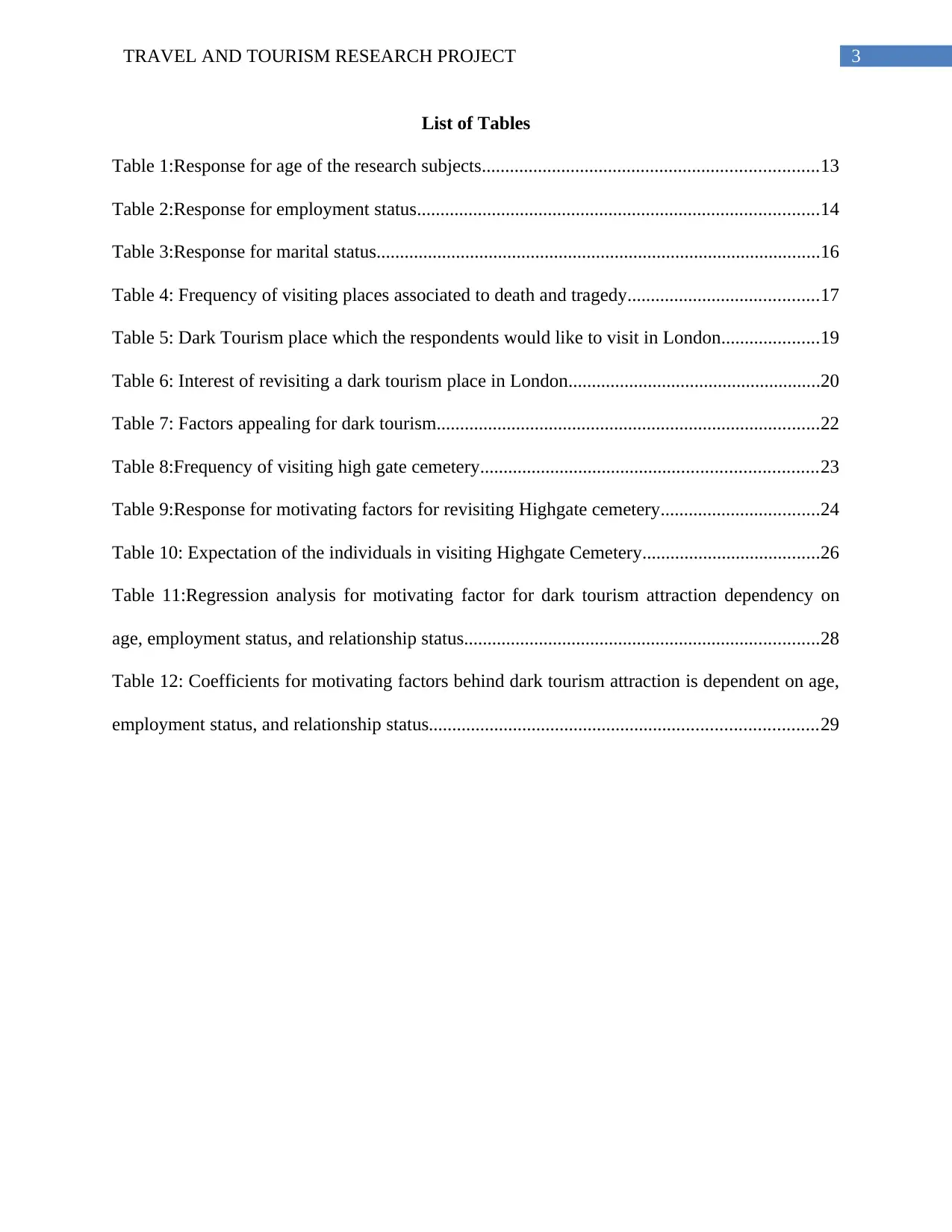
3TRAVEL AND TOURISM RESEARCH PROJECT
List of Tables
Table 1:Response for age of the research subjects........................................................................13
Table 2:Response for employment status......................................................................................14
Table 3:Response for marital status...............................................................................................16
Table 4: Frequency of visiting places associated to death and tragedy.........................................17
Table 5: Dark Tourism place which the respondents would like to visit in London.....................19
Table 6: Interest of revisiting a dark tourism place in London......................................................20
Table 7: Factors appealing for dark tourism..................................................................................22
Table 8:Frequency of visiting high gate cemetery........................................................................23
Table 9:Response for motivating factors for revisiting Highgate cemetery..................................24
Table 10: Expectation of the individuals in visiting Highgate Cemetery......................................26
Table 11:Regression analysis for motivating factor for dark tourism attraction dependency on
age, employment status, and relationship status............................................................................28
Table 12: Coefficients for motivating factors behind dark tourism attraction is dependent on age,
employment status, and relationship status...................................................................................29
List of Tables
Table 1:Response for age of the research subjects........................................................................13
Table 2:Response for employment status......................................................................................14
Table 3:Response for marital status...............................................................................................16
Table 4: Frequency of visiting places associated to death and tragedy.........................................17
Table 5: Dark Tourism place which the respondents would like to visit in London.....................19
Table 6: Interest of revisiting a dark tourism place in London......................................................20
Table 7: Factors appealing for dark tourism..................................................................................22
Table 8:Frequency of visiting high gate cemetery........................................................................23
Table 9:Response for motivating factors for revisiting Highgate cemetery..................................24
Table 10: Expectation of the individuals in visiting Highgate Cemetery......................................26
Table 11:Regression analysis for motivating factor for dark tourism attraction dependency on
age, employment status, and relationship status............................................................................28
Table 12: Coefficients for motivating factors behind dark tourism attraction is dependent on age,
employment status, and relationship status...................................................................................29
Secure Best Marks with AI Grader
Need help grading? Try our AI Grader for instant feedback on your assignments.
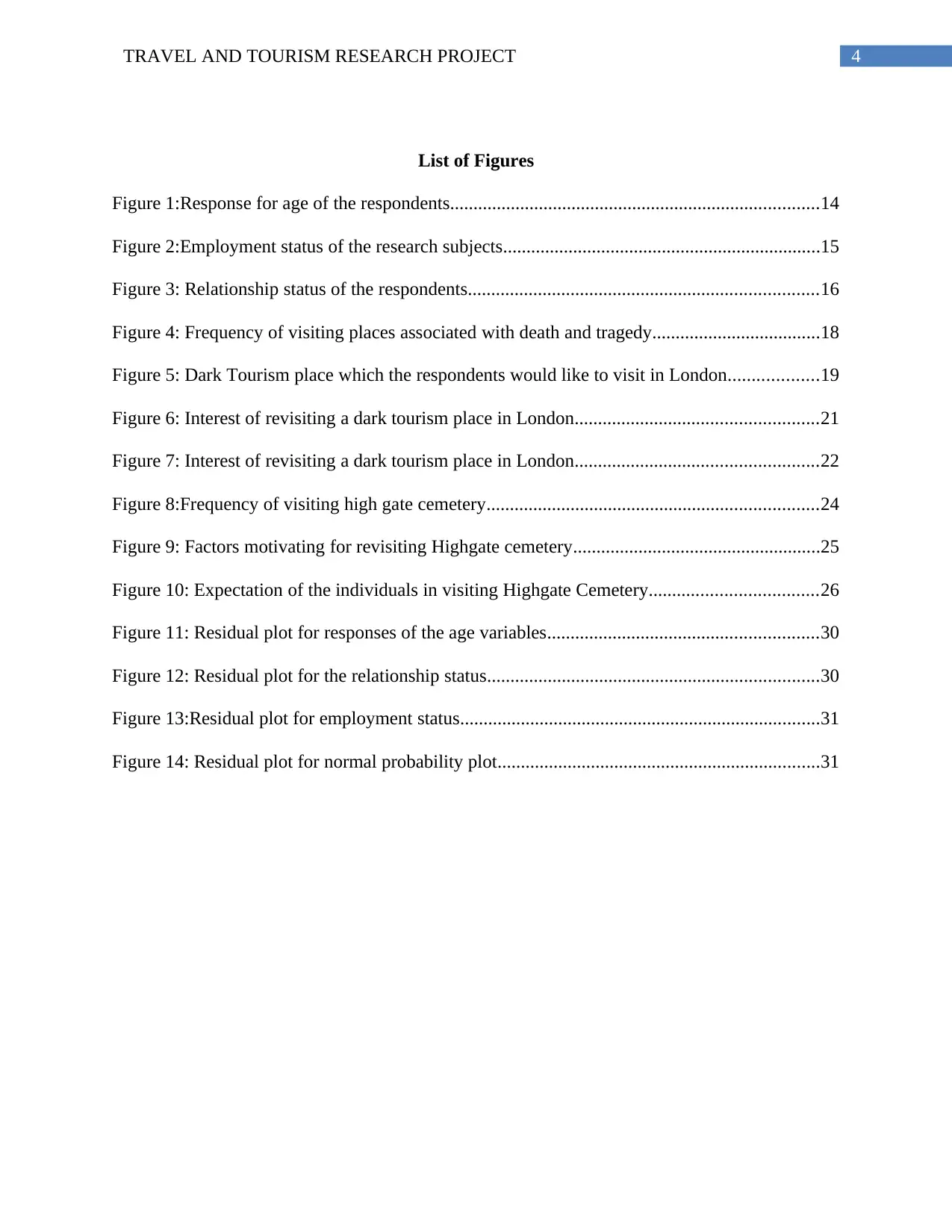
4TRAVEL AND TOURISM RESEARCH PROJECT
List of Figures
Figure 1:Response for age of the respondents...............................................................................14
Figure 2:Employment status of the research subjects....................................................................15
Figure 3: Relationship status of the respondents...........................................................................16
Figure 4: Frequency of visiting places associated with death and tragedy....................................18
Figure 5: Dark Tourism place which the respondents would like to visit in London...................19
Figure 6: Interest of revisiting a dark tourism place in London....................................................21
Figure 7: Interest of revisiting a dark tourism place in London....................................................22
Figure 8:Frequency of visiting high gate cemetery.......................................................................24
Figure 9: Factors motivating for revisiting Highgate cemetery.....................................................25
Figure 10: Expectation of the individuals in visiting Highgate Cemetery....................................26
Figure 11: Residual plot for responses of the age variables..........................................................30
Figure 12: Residual plot for the relationship status.......................................................................30
Figure 13:Residual plot for employment status.............................................................................31
Figure 14: Residual plot for normal probability plot.....................................................................31
List of Figures
Figure 1:Response for age of the respondents...............................................................................14
Figure 2:Employment status of the research subjects....................................................................15
Figure 3: Relationship status of the respondents...........................................................................16
Figure 4: Frequency of visiting places associated with death and tragedy....................................18
Figure 5: Dark Tourism place which the respondents would like to visit in London...................19
Figure 6: Interest of revisiting a dark tourism place in London....................................................21
Figure 7: Interest of revisiting a dark tourism place in London....................................................22
Figure 8:Frequency of visiting high gate cemetery.......................................................................24
Figure 9: Factors motivating for revisiting Highgate cemetery.....................................................25
Figure 10: Expectation of the individuals in visiting Highgate Cemetery....................................26
Figure 11: Residual plot for responses of the age variables..........................................................30
Figure 12: Residual plot for the relationship status.......................................................................30
Figure 13:Residual plot for employment status.............................................................................31
Figure 14: Residual plot for normal probability plot.....................................................................31
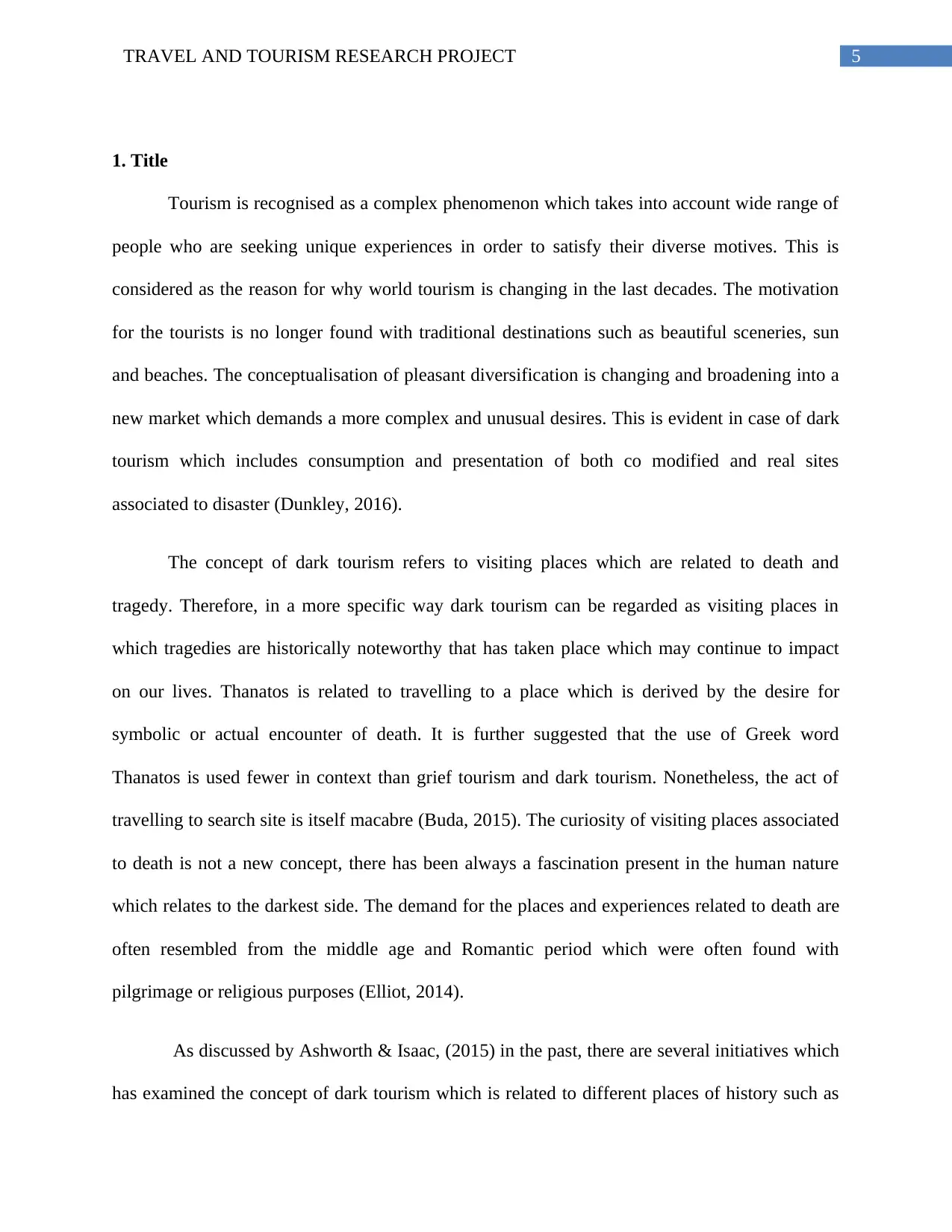
5TRAVEL AND TOURISM RESEARCH PROJECT
1. Title
Tourism is recognised as a complex phenomenon which takes into account wide range of
people who are seeking unique experiences in order to satisfy their diverse motives. This is
considered as the reason for why world tourism is changing in the last decades. The motivation
for the tourists is no longer found with traditional destinations such as beautiful sceneries, sun
and beaches. The conceptualisation of pleasant diversification is changing and broadening into a
new market which demands a more complex and unusual desires. This is evident in case of dark
tourism which includes consumption and presentation of both co modified and real sites
associated to disaster (Dunkley, 2016).
The concept of dark tourism refers to visiting places which are related to death and
tragedy. Therefore, in a more specific way dark tourism can be regarded as visiting places in
which tragedies are historically noteworthy that has taken place which may continue to impact
on our lives. Thanatos is related to travelling to a place which is derived by the desire for
symbolic or actual encounter of death. It is further suggested that the use of Greek word
Thanatos is used fewer in context than grief tourism and dark tourism. Nonetheless, the act of
travelling to search site is itself macabre (Buda, 2015). The curiosity of visiting places associated
to death is not a new concept, there has been always a fascination present in the human nature
which relates to the darkest side. The demand for the places and experiences related to death are
often resembled from the middle age and Romantic period which were often found with
pilgrimage or religious purposes (Elliot, 2014).
As discussed by Ashworth & Isaac, (2015) in the past, there are several initiatives which
has examined the concept of dark tourism which is related to different places of history such as
1. Title
Tourism is recognised as a complex phenomenon which takes into account wide range of
people who are seeking unique experiences in order to satisfy their diverse motives. This is
considered as the reason for why world tourism is changing in the last decades. The motivation
for the tourists is no longer found with traditional destinations such as beautiful sceneries, sun
and beaches. The conceptualisation of pleasant diversification is changing and broadening into a
new market which demands a more complex and unusual desires. This is evident in case of dark
tourism which includes consumption and presentation of both co modified and real sites
associated to disaster (Dunkley, 2016).
The concept of dark tourism refers to visiting places which are related to death and
tragedy. Therefore, in a more specific way dark tourism can be regarded as visiting places in
which tragedies are historically noteworthy that has taken place which may continue to impact
on our lives. Thanatos is related to travelling to a place which is derived by the desire for
symbolic or actual encounter of death. It is further suggested that the use of Greek word
Thanatos is used fewer in context than grief tourism and dark tourism. Nonetheless, the act of
travelling to search site is itself macabre (Buda, 2015). The curiosity of visiting places associated
to death is not a new concept, there has been always a fascination present in the human nature
which relates to the darkest side. The demand for the places and experiences related to death are
often resembled from the middle age and Romantic period which were often found with
pilgrimage or religious purposes (Elliot, 2014).
As discussed by Ashworth & Isaac, (2015) in the past, there are several initiatives which
has examined the concept of dark tourism which is related to different places of history such as
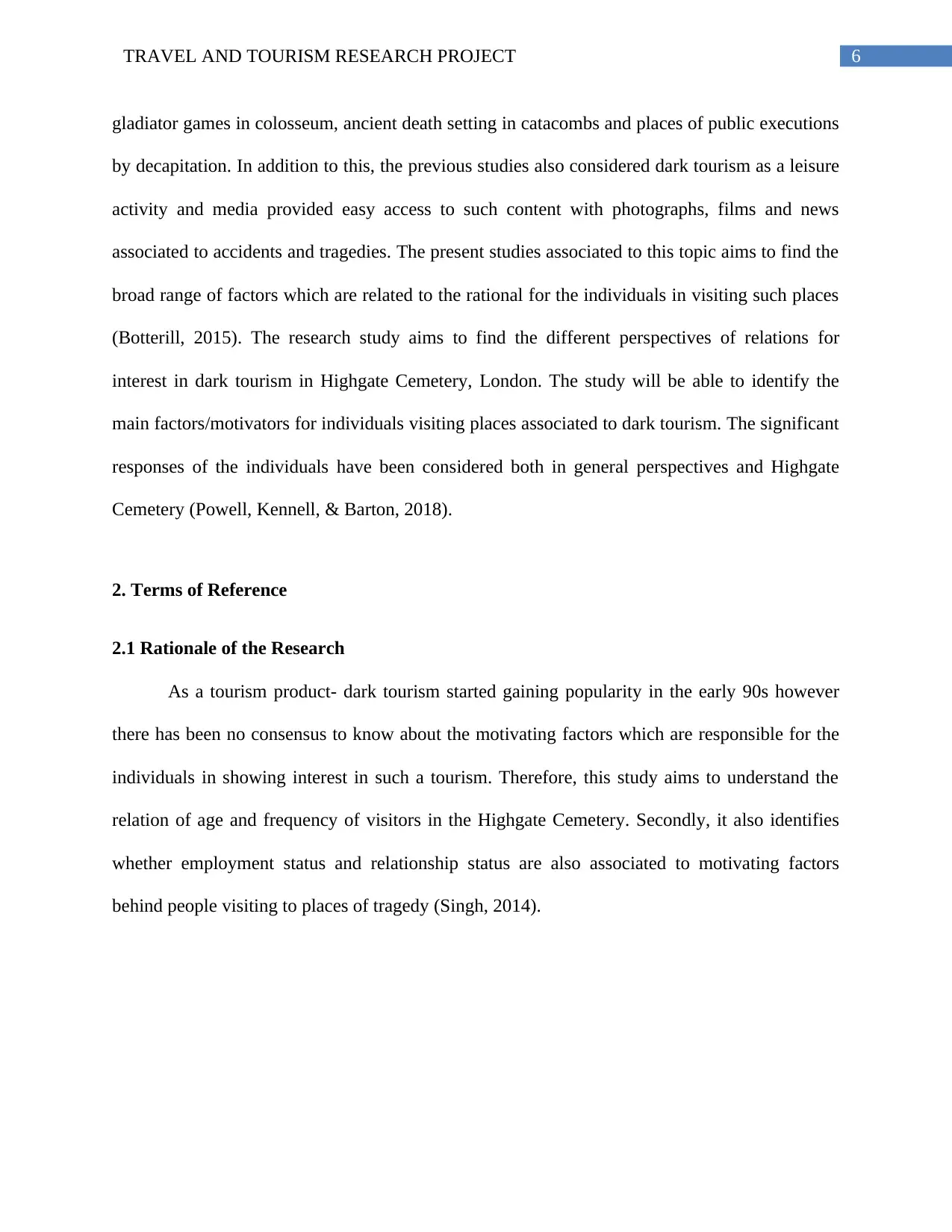
6TRAVEL AND TOURISM RESEARCH PROJECT
gladiator games in colosseum, ancient death setting in catacombs and places of public executions
by decapitation. In addition to this, the previous studies also considered dark tourism as a leisure
activity and media provided easy access to such content with photographs, films and news
associated to accidents and tragedies. The present studies associated to this topic aims to find the
broad range of factors which are related to the rational for the individuals in visiting such places
(Botterill, 2015). The research study aims to find the different perspectives of relations for
interest in dark tourism in Highgate Cemetery, London. The study will be able to identify the
main factors/motivators for individuals visiting places associated to dark tourism. The significant
responses of the individuals have been considered both in general perspectives and Highgate
Cemetery (Powell, Kennell, & Barton, 2018).
2. Terms of Reference
2.1 Rationale of the Research
As a tourism product- dark tourism started gaining popularity in the early 90s however
there has been no consensus to know about the motivating factors which are responsible for the
individuals in showing interest in such a tourism. Therefore, this study aims to understand the
relation of age and frequency of visitors in the Highgate Cemetery. Secondly, it also identifies
whether employment status and relationship status are also associated to motivating factors
behind people visiting to places of tragedy (Singh, 2014).
gladiator games in colosseum, ancient death setting in catacombs and places of public executions
by decapitation. In addition to this, the previous studies also considered dark tourism as a leisure
activity and media provided easy access to such content with photographs, films and news
associated to accidents and tragedies. The present studies associated to this topic aims to find the
broad range of factors which are related to the rational for the individuals in visiting such places
(Botterill, 2015). The research study aims to find the different perspectives of relations for
interest in dark tourism in Highgate Cemetery, London. The study will be able to identify the
main factors/motivators for individuals visiting places associated to dark tourism. The significant
responses of the individuals have been considered both in general perspectives and Highgate
Cemetery (Powell, Kennell, & Barton, 2018).
2. Terms of Reference
2.1 Rationale of the Research
As a tourism product- dark tourism started gaining popularity in the early 90s however
there has been no consensus to know about the motivating factors which are responsible for the
individuals in showing interest in such a tourism. Therefore, this study aims to understand the
relation of age and frequency of visitors in the Highgate Cemetery. Secondly, it also identifies
whether employment status and relationship status are also associated to motivating factors
behind people visiting to places of tragedy (Singh, 2014).
Paraphrase This Document
Need a fresh take? Get an instant paraphrase of this document with our AI Paraphraser
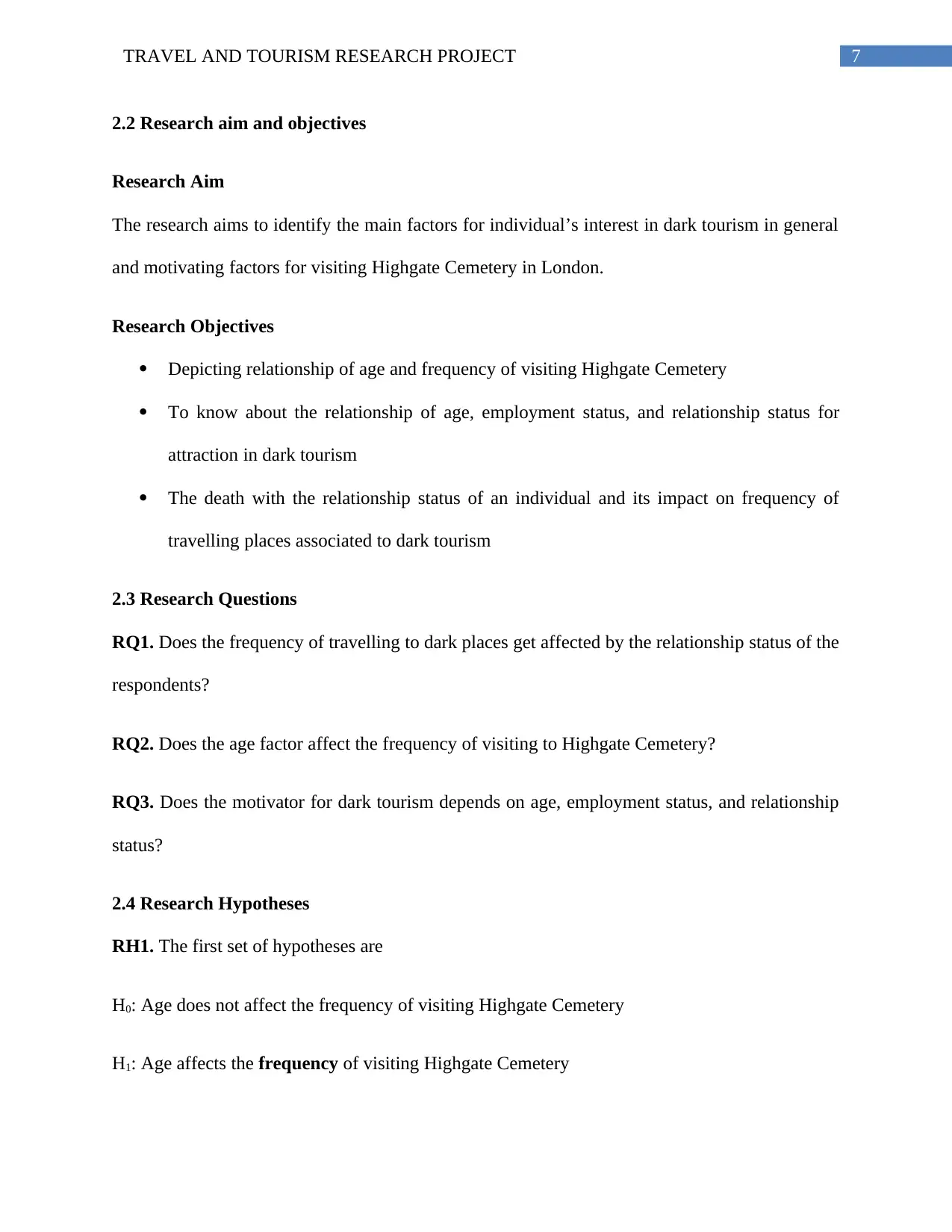
7TRAVEL AND TOURISM RESEARCH PROJECT
2.2 Research aim and objectives
Research Aim
The research aims to identify the main factors for individual’s interest in dark tourism in general
and motivating factors for visiting Highgate Cemetery in London.
Research Objectives
Depicting relationship of age and frequency of visiting Highgate Cemetery
To know about the relationship of age, employment status, and relationship status for
attraction in dark tourism
The death with the relationship status of an individual and its impact on frequency of
travelling places associated to dark tourism
2.3 Research Questions
RQ1. Does the frequency of travelling to dark places get affected by the relationship status of the
respondents?
RQ2. Does the age factor affect the frequency of visiting to Highgate Cemetery?
RQ3. Does the motivator for dark tourism depends on age, employment status, and relationship
status?
2.4 Research Hypotheses
RH1. The first set of hypotheses are
H0: Age does not affect the frequency of visiting Highgate Cemetery
H1: Age affects the frequency of visiting Highgate Cemetery
2.2 Research aim and objectives
Research Aim
The research aims to identify the main factors for individual’s interest in dark tourism in general
and motivating factors for visiting Highgate Cemetery in London.
Research Objectives
Depicting relationship of age and frequency of visiting Highgate Cemetery
To know about the relationship of age, employment status, and relationship status for
attraction in dark tourism
The death with the relationship status of an individual and its impact on frequency of
travelling places associated to dark tourism
2.3 Research Questions
RQ1. Does the frequency of travelling to dark places get affected by the relationship status of the
respondents?
RQ2. Does the age factor affect the frequency of visiting to Highgate Cemetery?
RQ3. Does the motivator for dark tourism depends on age, employment status, and relationship
status?
2.4 Research Hypotheses
RH1. The first set of hypotheses are
H0: Age does not affect the frequency of visiting Highgate Cemetery
H1: Age affects the frequency of visiting Highgate Cemetery
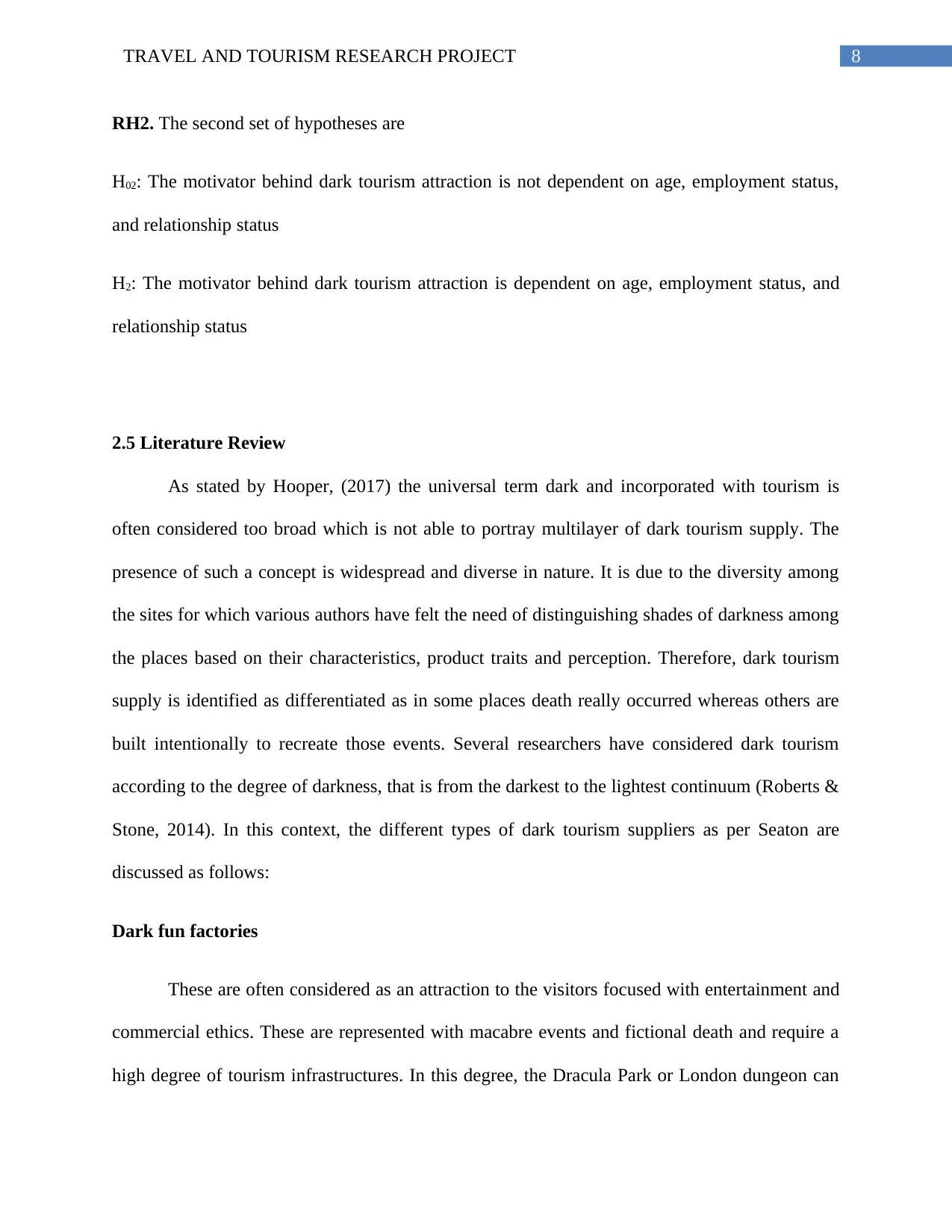
8TRAVEL AND TOURISM RESEARCH PROJECT
RH2. The second set of hypotheses are
H02: The motivator behind dark tourism attraction is not dependent on age, employment status,
and relationship status
H2: The motivator behind dark tourism attraction is dependent on age, employment status, and
relationship status
2.5 Literature Review
As stated by Hooper, (2017) the universal term dark and incorporated with tourism is
often considered too broad which is not able to portray multilayer of dark tourism supply. The
presence of such a concept is widespread and diverse in nature. It is due to the diversity among
the sites for which various authors have felt the need of distinguishing shades of darkness among
the places based on their characteristics, product traits and perception. Therefore, dark tourism
supply is identified as differentiated as in some places death really occurred whereas others are
built intentionally to recreate those events. Several researchers have considered dark tourism
according to the degree of darkness, that is from the darkest to the lightest continuum (Roberts &
Stone, 2014). In this context, the different types of dark tourism suppliers as per Seaton are
discussed as follows:
Dark fun factories
These are often considered as an attraction to the visitors focused with entertainment and
commercial ethics. These are represented with macabre events and fictional death and require a
high degree of tourism infrastructures. In this degree, the Dracula Park or London dungeon can
RH2. The second set of hypotheses are
H02: The motivator behind dark tourism attraction is not dependent on age, employment status,
and relationship status
H2: The motivator behind dark tourism attraction is dependent on age, employment status, and
relationship status
2.5 Literature Review
As stated by Hooper, (2017) the universal term dark and incorporated with tourism is
often considered too broad which is not able to portray multilayer of dark tourism supply. The
presence of such a concept is widespread and diverse in nature. It is due to the diversity among
the sites for which various authors have felt the need of distinguishing shades of darkness among
the places based on their characteristics, product traits and perception. Therefore, dark tourism
supply is identified as differentiated as in some places death really occurred whereas others are
built intentionally to recreate those events. Several researchers have considered dark tourism
according to the degree of darkness, that is from the darkest to the lightest continuum (Roberts &
Stone, 2014). In this context, the different types of dark tourism suppliers as per Seaton are
discussed as follows:
Dark fun factories
These are often considered as an attraction to the visitors focused with entertainment and
commercial ethics. These are represented with macabre events and fictional death and require a
high degree of tourism infrastructures. In this degree, the Dracula Park or London dungeon can
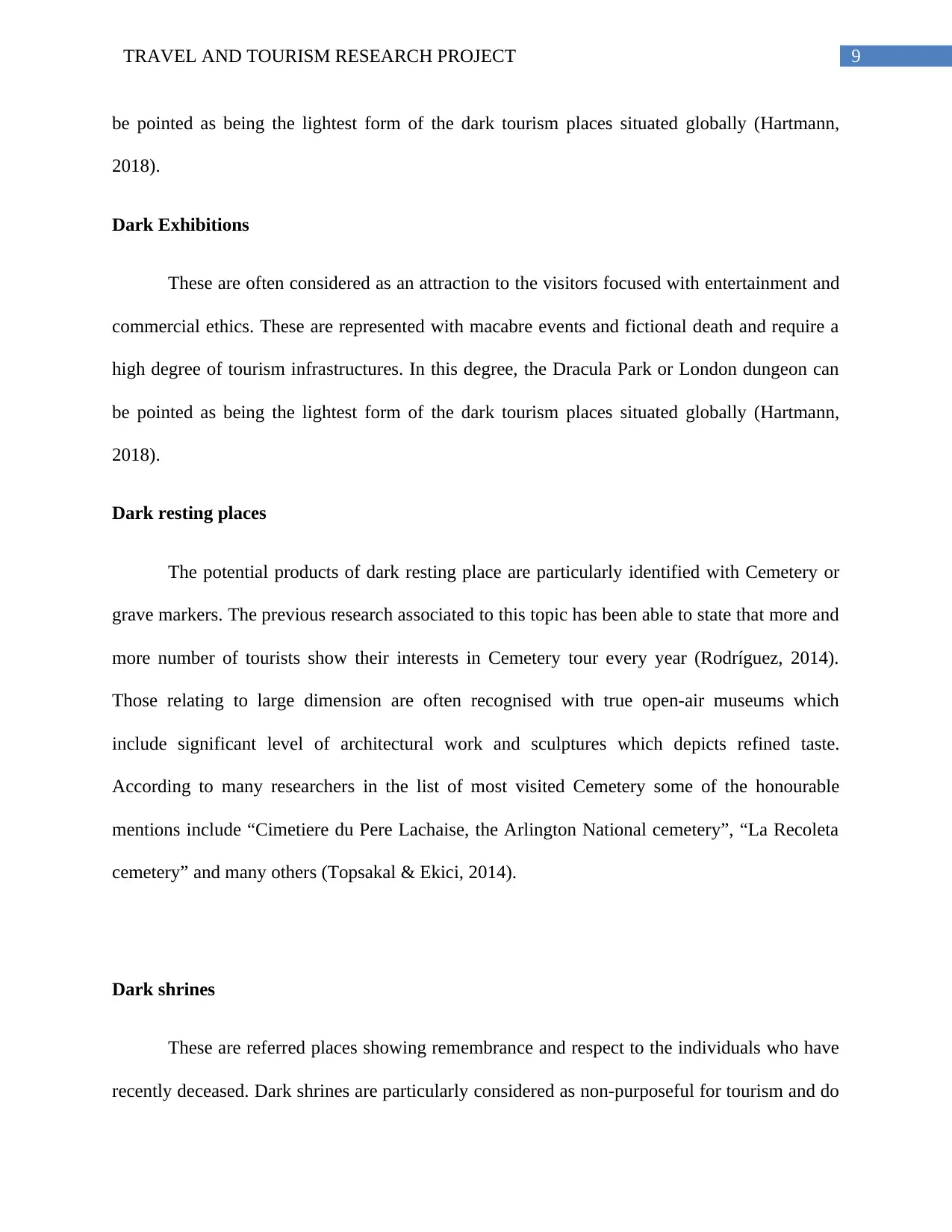
9TRAVEL AND TOURISM RESEARCH PROJECT
be pointed as being the lightest form of the dark tourism places situated globally (Hartmann,
2018).
Dark Exhibitions
These are often considered as an attraction to the visitors focused with entertainment and
commercial ethics. These are represented with macabre events and fictional death and require a
high degree of tourism infrastructures. In this degree, the Dracula Park or London dungeon can
be pointed as being the lightest form of the dark tourism places situated globally (Hartmann,
2018).
Dark resting places
The potential products of dark resting place are particularly identified with Cemetery or
grave markers. The previous research associated to this topic has been able to state that more and
more number of tourists show their interests in Cemetery tour every year (Rodríguez, 2014).
Those relating to large dimension are often recognised with true open-air museums which
include significant level of architectural work and sculptures which depicts refined taste.
According to many researchers in the list of most visited Cemetery some of the honourable
mentions include “Cimetiere du Pere Lachaise, the Arlington National cemetery”, “La Recoleta
cemetery” and many others (Topsakal & Ekici, 2014).
Dark shrines
These are referred places showing remembrance and respect to the individuals who have
recently deceased. Dark shrines are particularly considered as non-purposeful for tourism and do
be pointed as being the lightest form of the dark tourism places situated globally (Hartmann,
2018).
Dark Exhibitions
These are often considered as an attraction to the visitors focused with entertainment and
commercial ethics. These are represented with macabre events and fictional death and require a
high degree of tourism infrastructures. In this degree, the Dracula Park or London dungeon can
be pointed as being the lightest form of the dark tourism places situated globally (Hartmann,
2018).
Dark resting places
The potential products of dark resting place are particularly identified with Cemetery or
grave markers. The previous research associated to this topic has been able to state that more and
more number of tourists show their interests in Cemetery tour every year (Rodríguez, 2014).
Those relating to large dimension are often recognised with true open-air museums which
include significant level of architectural work and sculptures which depicts refined taste.
According to many researchers in the list of most visited Cemetery some of the honourable
mentions include “Cimetiere du Pere Lachaise, the Arlington National cemetery”, “La Recoleta
cemetery” and many others (Topsakal & Ekici, 2014).
Dark shrines
These are referred places showing remembrance and respect to the individuals who have
recently deceased. Dark shrines are particularly considered as non-purposeful for tourism and do
Secure Best Marks with AI Grader
Need help grading? Try our AI Grader for instant feedback on your assignments.
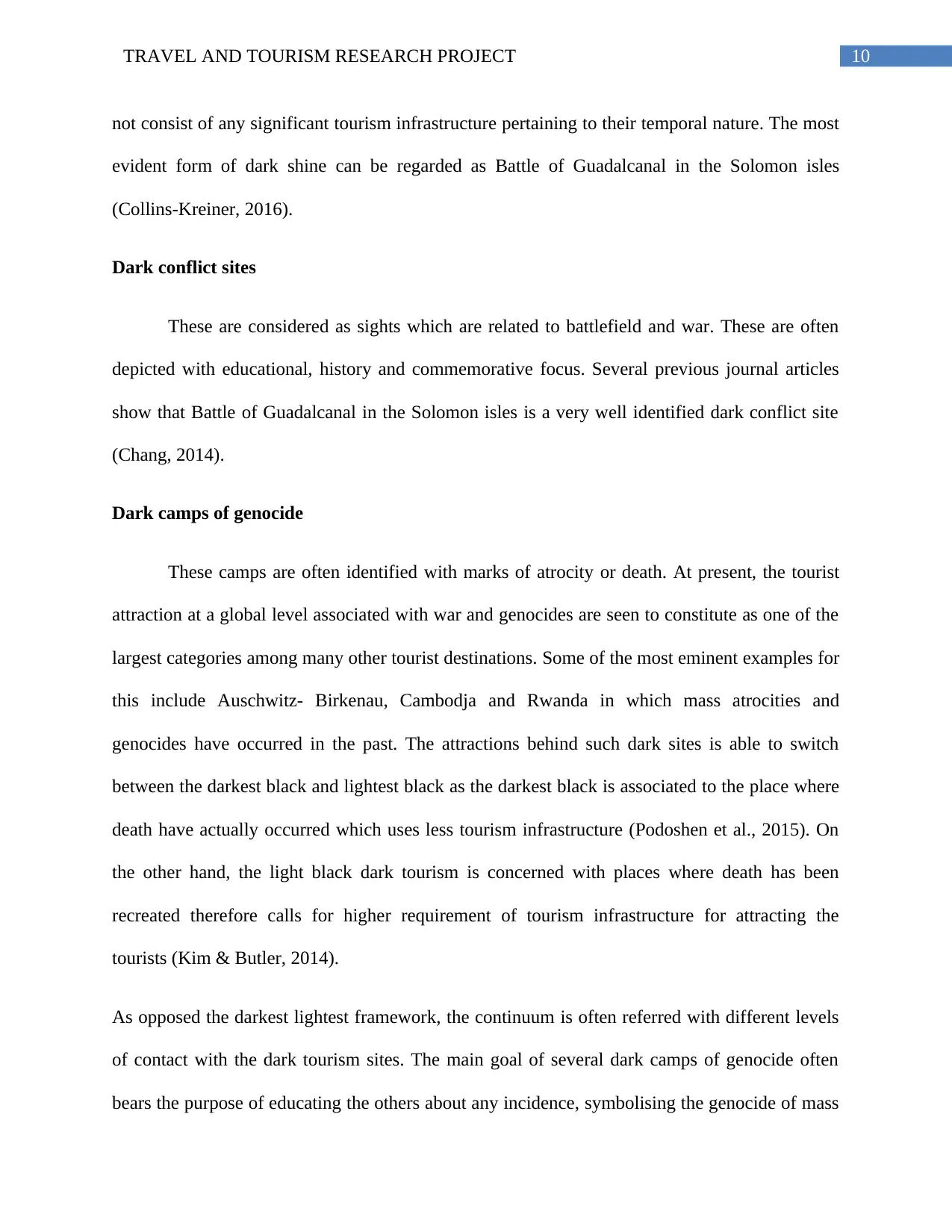
10TRAVEL AND TOURISM RESEARCH PROJECT
not consist of any significant tourism infrastructure pertaining to their temporal nature. The most
evident form of dark shine can be regarded as Battle of Guadalcanal in the Solomon isles
(Collins-Kreiner, 2016).
Dark conflict sites
These are considered as sights which are related to battlefield and war. These are often
depicted with educational, history and commemorative focus. Several previous journal articles
show that Battle of Guadalcanal in the Solomon isles is a very well identified dark conflict site
(Chang, 2014).
Dark camps of genocide
These camps are often identified with marks of atrocity or death. At present, the tourist
attraction at a global level associated with war and genocides are seen to constitute as one of the
largest categories among many other tourist destinations. Some of the most eminent examples for
this include Auschwitz- Birkenau, Cambodja and Rwanda in which mass atrocities and
genocides have occurred in the past. The attractions behind such dark sites is able to switch
between the darkest black and lightest black as the darkest black is associated to the place where
death have actually occurred which uses less tourism infrastructure (Podoshen et al., 2015). On
the other hand, the light black dark tourism is concerned with places where death has been
recreated therefore calls for higher requirement of tourism infrastructure for attracting the
tourists (Kim & Butler, 2014).
As opposed the darkest lightest framework, the continuum is often referred with different levels
of contact with the dark tourism sites. The main goal of several dark camps of genocide often
bears the purpose of educating the others about any incidence, symbolising the genocide of mass
not consist of any significant tourism infrastructure pertaining to their temporal nature. The most
evident form of dark shine can be regarded as Battle of Guadalcanal in the Solomon isles
(Collins-Kreiner, 2016).
Dark conflict sites
These are considered as sights which are related to battlefield and war. These are often
depicted with educational, history and commemorative focus. Several previous journal articles
show that Battle of Guadalcanal in the Solomon isles is a very well identified dark conflict site
(Chang, 2014).
Dark camps of genocide
These camps are often identified with marks of atrocity or death. At present, the tourist
attraction at a global level associated with war and genocides are seen to constitute as one of the
largest categories among many other tourist destinations. Some of the most eminent examples for
this include Auschwitz- Birkenau, Cambodja and Rwanda in which mass atrocities and
genocides have occurred in the past. The attractions behind such dark sites is able to switch
between the darkest black and lightest black as the darkest black is associated to the place where
death have actually occurred which uses less tourism infrastructure (Podoshen et al., 2015). On
the other hand, the light black dark tourism is concerned with places where death has been
recreated therefore calls for higher requirement of tourism infrastructure for attracting the
tourists (Kim & Butler, 2014).
As opposed the darkest lightest framework, the continuum is often referred with different levels
of contact with the dark tourism sites. The main goal of several dark camps of genocide often
bears the purpose of educating the others about any incidence, symbolising the genocide of mass
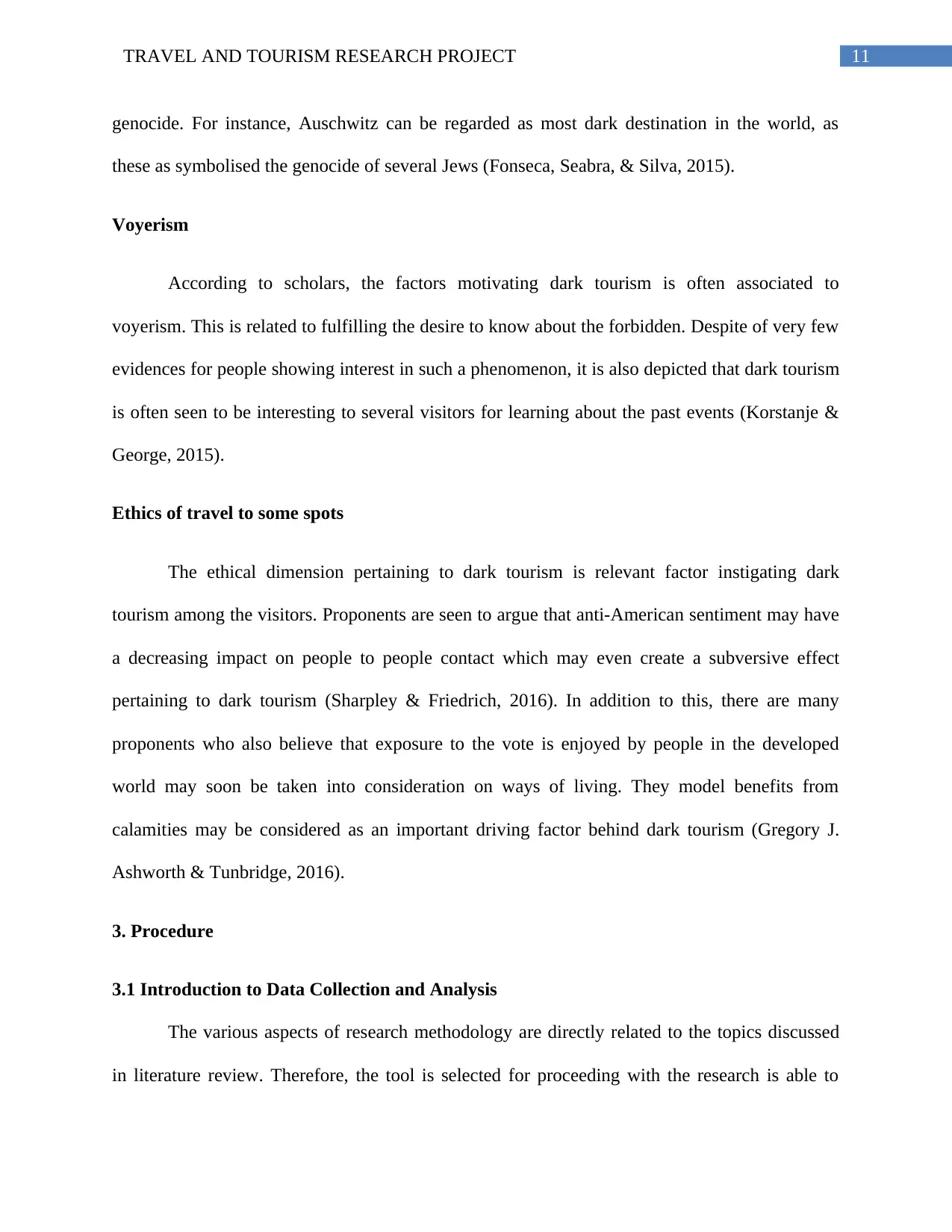
11TRAVEL AND TOURISM RESEARCH PROJECT
genocide. For instance, Auschwitz can be regarded as most dark destination in the world, as
these as symbolised the genocide of several Jews (Fonseca, Seabra, & Silva, 2015).
Voyerism
According to scholars, the factors motivating dark tourism is often associated to
voyerism. This is related to fulfilling the desire to know about the forbidden. Despite of very few
evidences for people showing interest in such a phenomenon, it is also depicted that dark tourism
is often seen to be interesting to several visitors for learning about the past events (Korstanje &
George, 2015).
Ethics of travel to some spots
The ethical dimension pertaining to dark tourism is relevant factor instigating dark
tourism among the visitors. Proponents are seen to argue that anti-American sentiment may have
a decreasing impact on people to people contact which may even create a subversive effect
pertaining to dark tourism (Sharpley & Friedrich, 2016). In addition to this, there are many
proponents who also believe that exposure to the vote is enjoyed by people in the developed
world may soon be taken into consideration on ways of living. They model benefits from
calamities may be considered as an important driving factor behind dark tourism (Gregory J.
Ashworth & Tunbridge, 2016).
3. Procedure
3.1 Introduction to Data Collection and Analysis
The various aspects of research methodology are directly related to the topics discussed
in literature review. Therefore, the tool is selected for proceeding with the research is able to
genocide. For instance, Auschwitz can be regarded as most dark destination in the world, as
these as symbolised the genocide of several Jews (Fonseca, Seabra, & Silva, 2015).
Voyerism
According to scholars, the factors motivating dark tourism is often associated to
voyerism. This is related to fulfilling the desire to know about the forbidden. Despite of very few
evidences for people showing interest in such a phenomenon, it is also depicted that dark tourism
is often seen to be interesting to several visitors for learning about the past events (Korstanje &
George, 2015).
Ethics of travel to some spots
The ethical dimension pertaining to dark tourism is relevant factor instigating dark
tourism among the visitors. Proponents are seen to argue that anti-American sentiment may have
a decreasing impact on people to people contact which may even create a subversive effect
pertaining to dark tourism (Sharpley & Friedrich, 2016). In addition to this, there are many
proponents who also believe that exposure to the vote is enjoyed by people in the developed
world may soon be taken into consideration on ways of living. They model benefits from
calamities may be considered as an important driving factor behind dark tourism (Gregory J.
Ashworth & Tunbridge, 2016).
3. Procedure
3.1 Introduction to Data Collection and Analysis
The various aspects of research methodology are directly related to the topics discussed
in literature review. Therefore, the tool is selected for proceeding with the research is able to
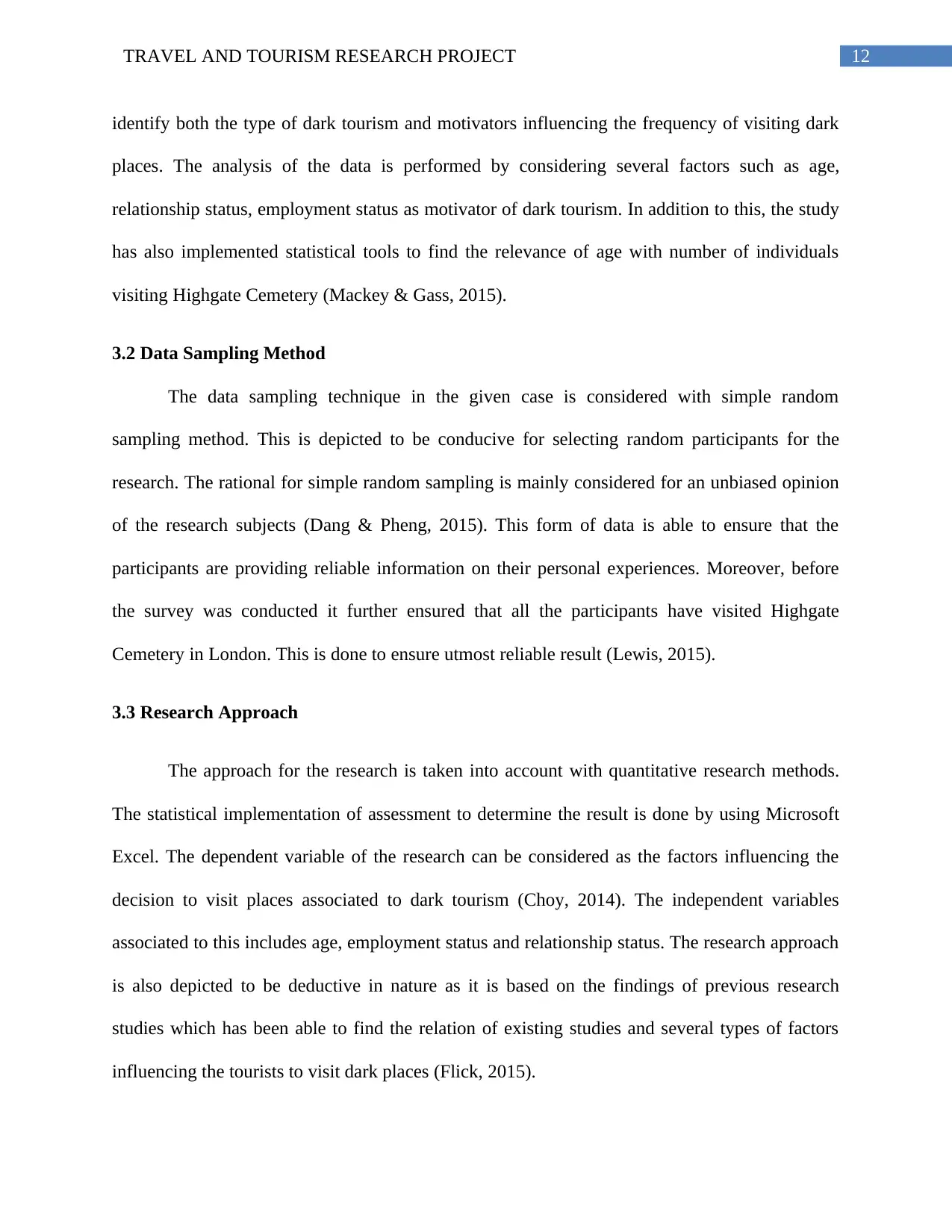
12TRAVEL AND TOURISM RESEARCH PROJECT
identify both the type of dark tourism and motivators influencing the frequency of visiting dark
places. The analysis of the data is performed by considering several factors such as age,
relationship status, employment status as motivator of dark tourism. In addition to this, the study
has also implemented statistical tools to find the relevance of age with number of individuals
visiting Highgate Cemetery (Mackey & Gass, 2015).
3.2 Data Sampling Method
The data sampling technique in the given case is considered with simple random
sampling method. This is depicted to be conducive for selecting random participants for the
research. The rational for simple random sampling is mainly considered for an unbiased opinion
of the research subjects (Dang & Pheng, 2015). This form of data is able to ensure that the
participants are providing reliable information on their personal experiences. Moreover, before
the survey was conducted it further ensured that all the participants have visited Highgate
Cemetery in London. This is done to ensure utmost reliable result (Lewis, 2015).
3.3 Research Approach
The approach for the research is taken into account with quantitative research methods.
The statistical implementation of assessment to determine the result is done by using Microsoft
Excel. The dependent variable of the research can be considered as the factors influencing the
decision to visit places associated to dark tourism (Choy, 2014). The independent variables
associated to this includes age, employment status and relationship status. The research approach
is also depicted to be deductive in nature as it is based on the findings of previous research
studies which has been able to find the relation of existing studies and several types of factors
influencing the tourists to visit dark places (Flick, 2015).
identify both the type of dark tourism and motivators influencing the frequency of visiting dark
places. The analysis of the data is performed by considering several factors such as age,
relationship status, employment status as motivator of dark tourism. In addition to this, the study
has also implemented statistical tools to find the relevance of age with number of individuals
visiting Highgate Cemetery (Mackey & Gass, 2015).
3.2 Data Sampling Method
The data sampling technique in the given case is considered with simple random
sampling method. This is depicted to be conducive for selecting random participants for the
research. The rational for simple random sampling is mainly considered for an unbiased opinion
of the research subjects (Dang & Pheng, 2015). This form of data is able to ensure that the
participants are providing reliable information on their personal experiences. Moreover, before
the survey was conducted it further ensured that all the participants have visited Highgate
Cemetery in London. This is done to ensure utmost reliable result (Lewis, 2015).
3.3 Research Approach
The approach for the research is taken into account with quantitative research methods.
The statistical implementation of assessment to determine the result is done by using Microsoft
Excel. The dependent variable of the research can be considered as the factors influencing the
decision to visit places associated to dark tourism (Choy, 2014). The independent variables
associated to this includes age, employment status and relationship status. The research approach
is also depicted to be deductive in nature as it is based on the findings of previous research
studies which has been able to find the relation of existing studies and several types of factors
influencing the tourists to visit dark places (Flick, 2015).
Paraphrase This Document
Need a fresh take? Get an instant paraphrase of this document with our AI Paraphraser
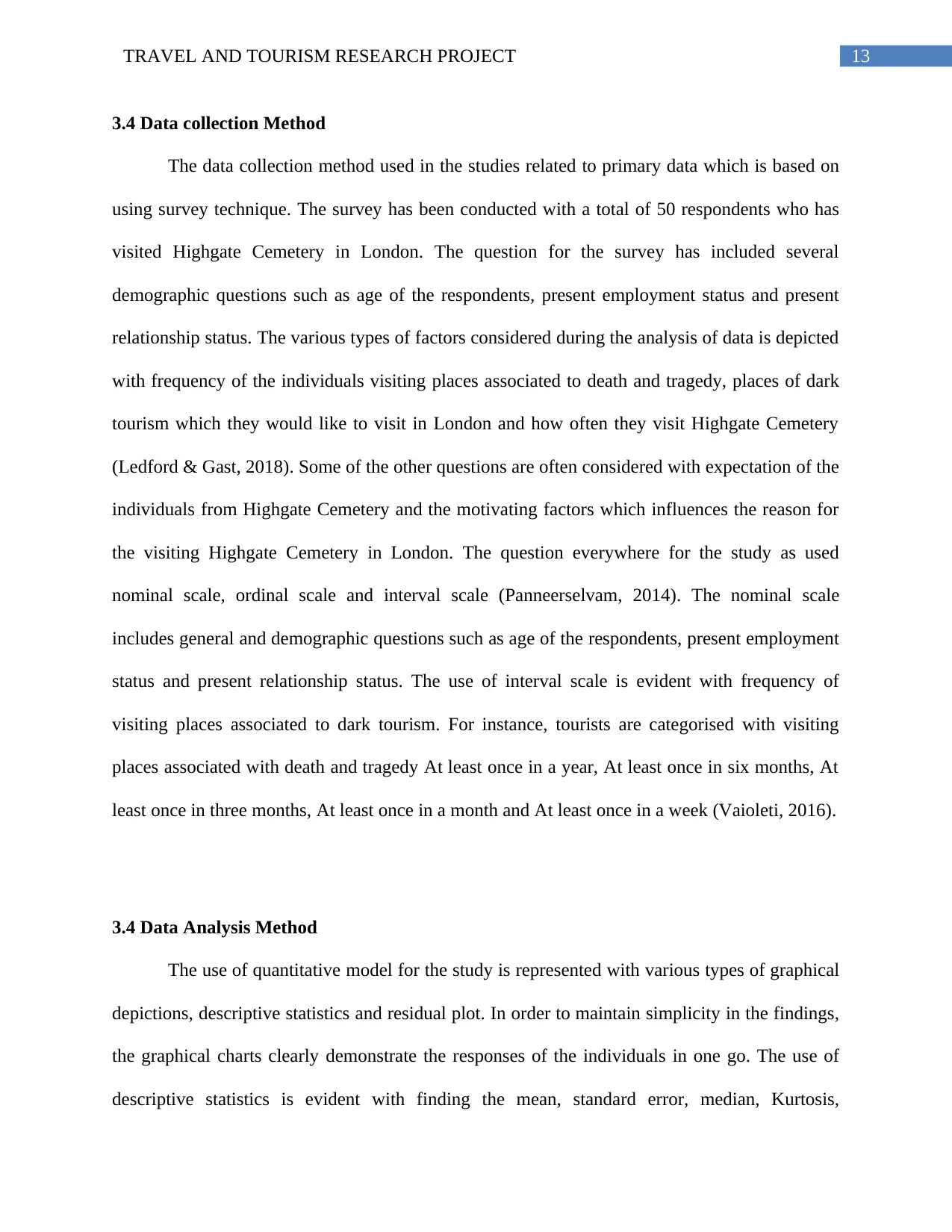
13TRAVEL AND TOURISM RESEARCH PROJECT
3.4 Data collection Method
The data collection method used in the studies related to primary data which is based on
using survey technique. The survey has been conducted with a total of 50 respondents who has
visited Highgate Cemetery in London. The question for the survey has included several
demographic questions such as age of the respondents, present employment status and present
relationship status. The various types of factors considered during the analysis of data is depicted
with frequency of the individuals visiting places associated to death and tragedy, places of dark
tourism which they would like to visit in London and how often they visit Highgate Cemetery
(Ledford & Gast, 2018). Some of the other questions are often considered with expectation of the
individuals from Highgate Cemetery and the motivating factors which influences the reason for
the visiting Highgate Cemetery in London. The question everywhere for the study as used
nominal scale, ordinal scale and interval scale (Panneerselvam, 2014). The nominal scale
includes general and demographic questions such as age of the respondents, present employment
status and present relationship status. The use of interval scale is evident with frequency of
visiting places associated to dark tourism. For instance, tourists are categorised with visiting
places associated with death and tragedy At least once in a year, At least once in six months, At
least once in three months, At least once in a month and At least once in a week (Vaioleti, 2016).
3.4 Data Analysis Method
The use of quantitative model for the study is represented with various types of graphical
depictions, descriptive statistics and residual plot. In order to maintain simplicity in the findings,
the graphical charts clearly demonstrate the responses of the individuals in one go. The use of
descriptive statistics is evident with finding the mean, standard error, median, Kurtosis,
3.4 Data collection Method
The data collection method used in the studies related to primary data which is based on
using survey technique. The survey has been conducted with a total of 50 respondents who has
visited Highgate Cemetery in London. The question for the survey has included several
demographic questions such as age of the respondents, present employment status and present
relationship status. The various types of factors considered during the analysis of data is depicted
with frequency of the individuals visiting places associated to death and tragedy, places of dark
tourism which they would like to visit in London and how often they visit Highgate Cemetery
(Ledford & Gast, 2018). Some of the other questions are often considered with expectation of the
individuals from Highgate Cemetery and the motivating factors which influences the reason for
the visiting Highgate Cemetery in London. The question everywhere for the study as used
nominal scale, ordinal scale and interval scale (Panneerselvam, 2014). The nominal scale
includes general and demographic questions such as age of the respondents, present employment
status and present relationship status. The use of interval scale is evident with frequency of
visiting places associated to dark tourism. For instance, tourists are categorised with visiting
places associated with death and tragedy At least once in a year, At least once in six months, At
least once in three months, At least once in a month and At least once in a week (Vaioleti, 2016).
3.4 Data Analysis Method
The use of quantitative model for the study is represented with various types of graphical
depictions, descriptive statistics and residual plot. In order to maintain simplicity in the findings,
the graphical charts clearly demonstrate the responses of the individuals in one go. The use of
descriptive statistics is evident with finding the mean, standard error, median, Kurtosis,
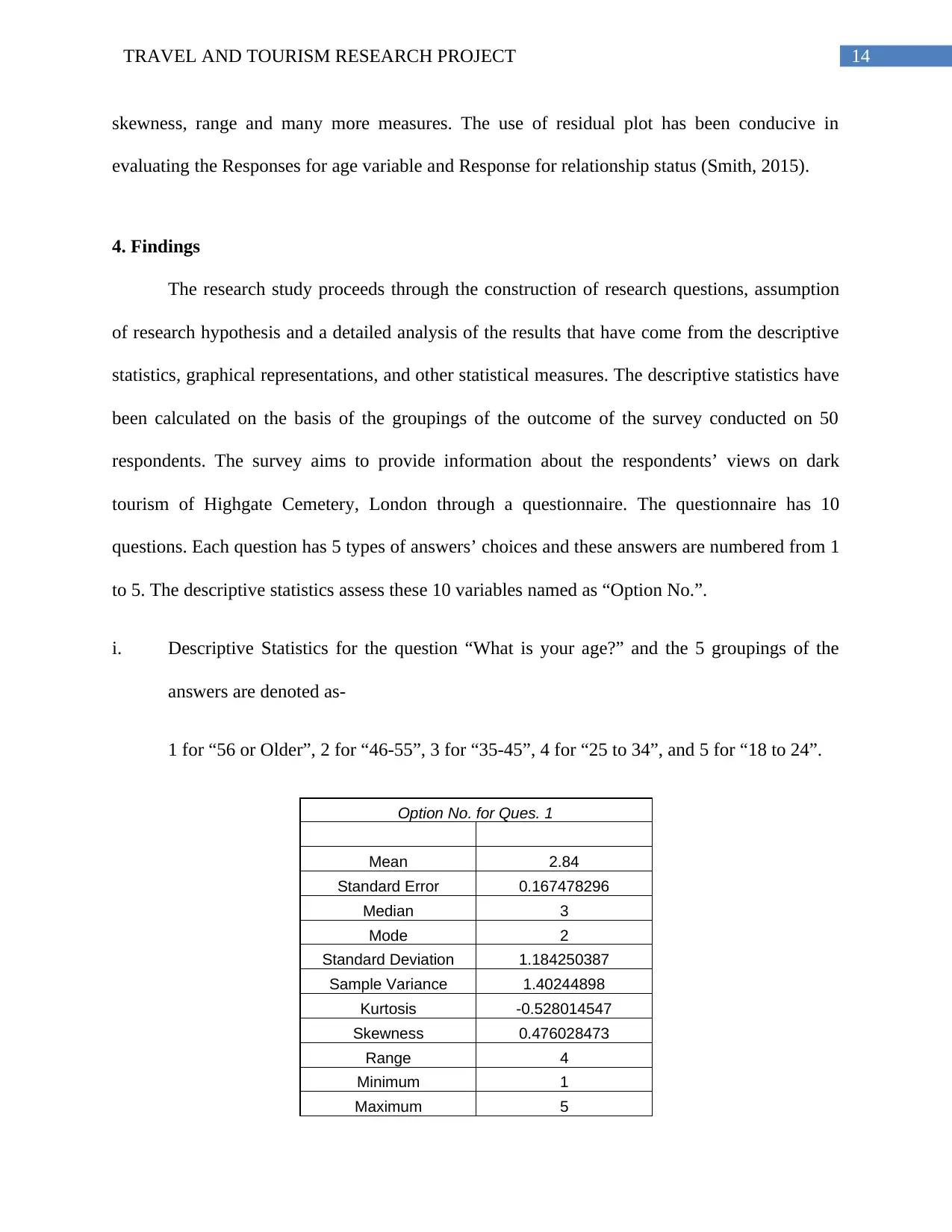
14TRAVEL AND TOURISM RESEARCH PROJECT
skewness, range and many more measures. The use of residual plot has been conducive in
evaluating the Responses for age variable and Response for relationship status (Smith, 2015).
4. Findings
The research study proceeds through the construction of research questions, assumption
of research hypothesis and a detailed analysis of the results that have come from the descriptive
statistics, graphical representations, and other statistical measures. The descriptive statistics have
been calculated on the basis of the groupings of the outcome of the survey conducted on 50
respondents. The survey aims to provide information about the respondents’ views on dark
tourism of Highgate Cemetery, London through a questionnaire. The questionnaire has 10
questions. Each question has 5 types of answers’ choices and these answers are numbered from 1
to 5. The descriptive statistics assess these 10 variables named as “Option No.”.
i. Descriptive Statistics for the question “What is your age?” and the 5 groupings of the
answers are denoted as-
1 for “56 or Older”, 2 for “46-55”, 3 for “35-45”, 4 for “25 to 34”, and 5 for “18 to 24”.
Option No. for Ques. 1
Mean 2.84
Standard Error 0.167478296
Median 3
Mode 2
Standard Deviation 1.184250387
Sample Variance 1.40244898
Kurtosis -0.528014547
Skewness 0.476028473
Range 4
Minimum 1
Maximum 5
skewness, range and many more measures. The use of residual plot has been conducive in
evaluating the Responses for age variable and Response for relationship status (Smith, 2015).
4. Findings
The research study proceeds through the construction of research questions, assumption
of research hypothesis and a detailed analysis of the results that have come from the descriptive
statistics, graphical representations, and other statistical measures. The descriptive statistics have
been calculated on the basis of the groupings of the outcome of the survey conducted on 50
respondents. The survey aims to provide information about the respondents’ views on dark
tourism of Highgate Cemetery, London through a questionnaire. The questionnaire has 10
questions. Each question has 5 types of answers’ choices and these answers are numbered from 1
to 5. The descriptive statistics assess these 10 variables named as “Option No.”.
i. Descriptive Statistics for the question “What is your age?” and the 5 groupings of the
answers are denoted as-
1 for “56 or Older”, 2 for “46-55”, 3 for “35-45”, 4 for “25 to 34”, and 5 for “18 to 24”.
Option No. for Ques. 1
Mean 2.84
Standard Error 0.167478296
Median 3
Mode 2
Standard Deviation 1.184250387
Sample Variance 1.40244898
Kurtosis -0.528014547
Skewness 0.476028473
Range 4
Minimum 1
Maximum 5
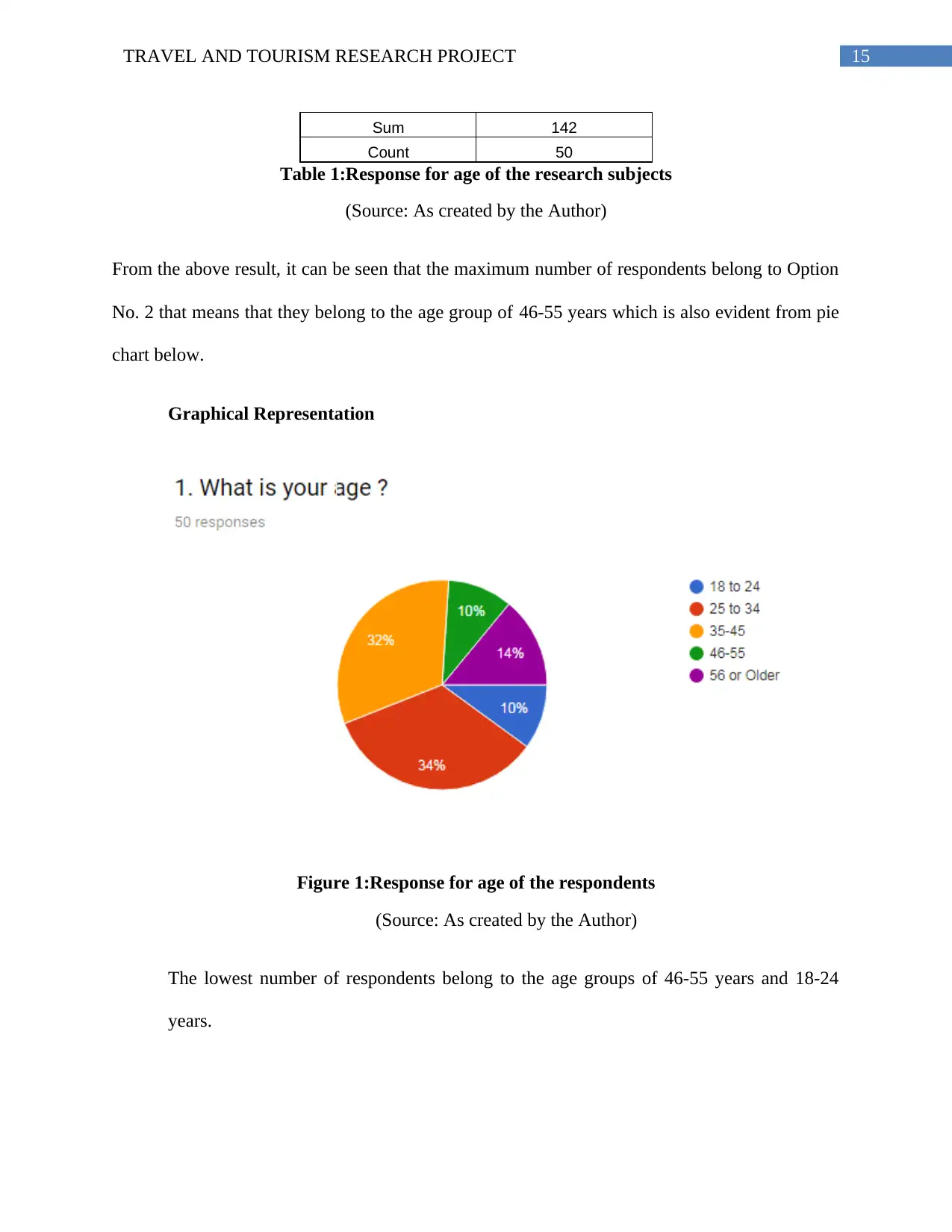
15TRAVEL AND TOURISM RESEARCH PROJECT
Sum 142
Count 50
Table 1:Response for age of the research subjects
(Source: As created by the Author)
From the above result, it can be seen that the maximum number of respondents belong to Option
No. 2 that means that they belong to the age group of 46-55 years which is also evident from pie
chart below.
Graphical Representation
Figure 1:Response for age of the respondents
(Source: As created by the Author)
The lowest number of respondents belong to the age groups of 46-55 years and 18-24
years.
Sum 142
Count 50
Table 1:Response for age of the research subjects
(Source: As created by the Author)
From the above result, it can be seen that the maximum number of respondents belong to Option
No. 2 that means that they belong to the age group of 46-55 years which is also evident from pie
chart below.
Graphical Representation
Figure 1:Response for age of the respondents
(Source: As created by the Author)
The lowest number of respondents belong to the age groups of 46-55 years and 18-24
years.
Secure Best Marks with AI Grader
Need help grading? Try our AI Grader for instant feedback on your assignments.
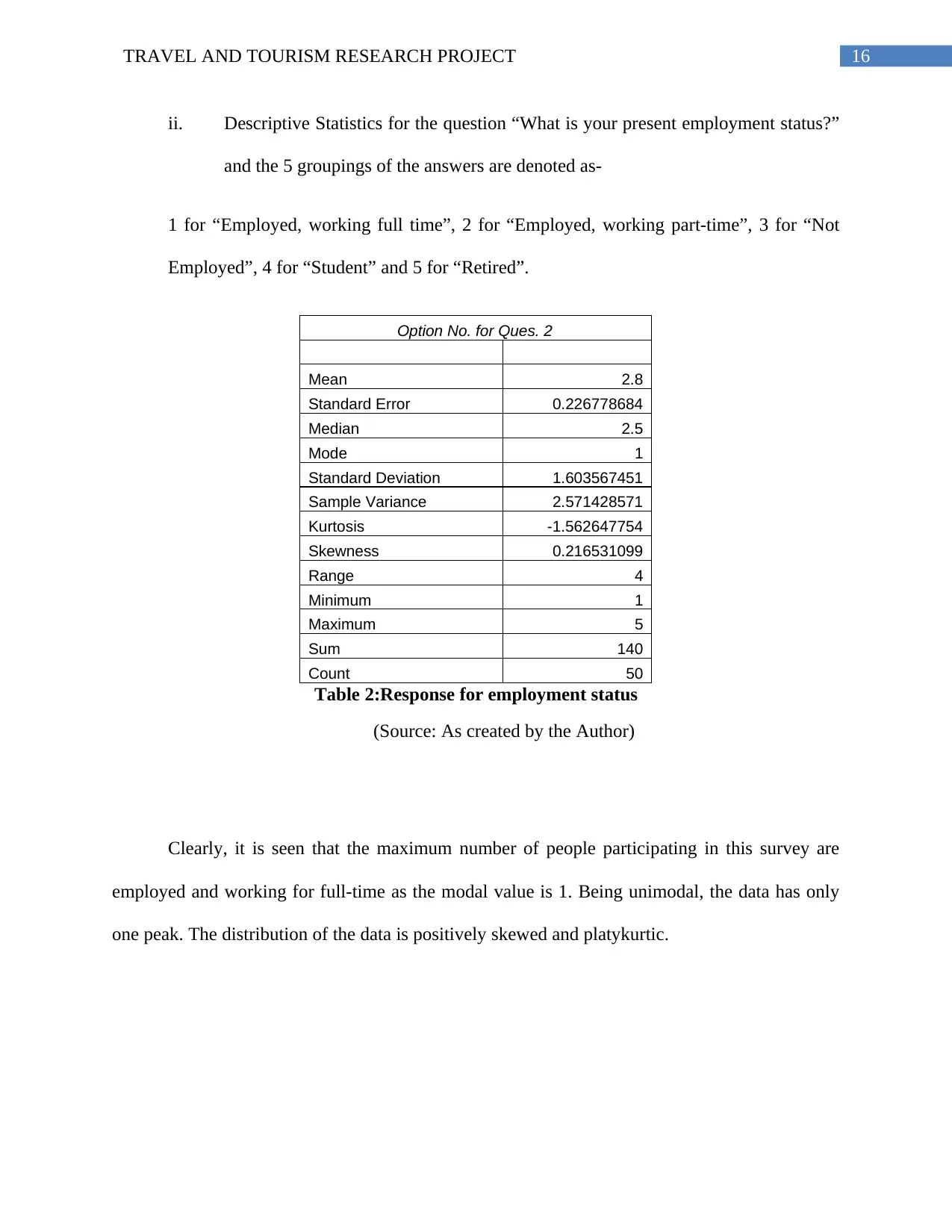
16TRAVEL AND TOURISM RESEARCH PROJECT
ii. Descriptive Statistics for the question “What is your present employment status?”
and the 5 groupings of the answers are denoted as-
1 for “Employed, working full time”, 2 for “Employed, working part-time”, 3 for “Not
Employed”, 4 for “Student” and 5 for “Retired”.
Option No. for Ques. 2
Mean 2.8
Standard Error 0.226778684
Median 2.5
Mode 1
Standard Deviation 1.603567451
Sample Variance 2.571428571
Kurtosis -1.562647754
Skewness 0.216531099
Range 4
Minimum 1
Maximum 5
Sum 140
Count 50
Table 2:Response for employment status
(Source: As created by the Author)
Clearly, it is seen that the maximum number of people participating in this survey are
employed and working for full-time as the modal value is 1. Being unimodal, the data has only
one peak. The distribution of the data is positively skewed and platykurtic.
ii. Descriptive Statistics for the question “What is your present employment status?”
and the 5 groupings of the answers are denoted as-
1 for “Employed, working full time”, 2 for “Employed, working part-time”, 3 for “Not
Employed”, 4 for “Student” and 5 for “Retired”.
Option No. for Ques. 2
Mean 2.8
Standard Error 0.226778684
Median 2.5
Mode 1
Standard Deviation 1.603567451
Sample Variance 2.571428571
Kurtosis -1.562647754
Skewness 0.216531099
Range 4
Minimum 1
Maximum 5
Sum 140
Count 50
Table 2:Response for employment status
(Source: As created by the Author)
Clearly, it is seen that the maximum number of people participating in this survey are
employed and working for full-time as the modal value is 1. Being unimodal, the data has only
one peak. The distribution of the data is positively skewed and platykurtic.
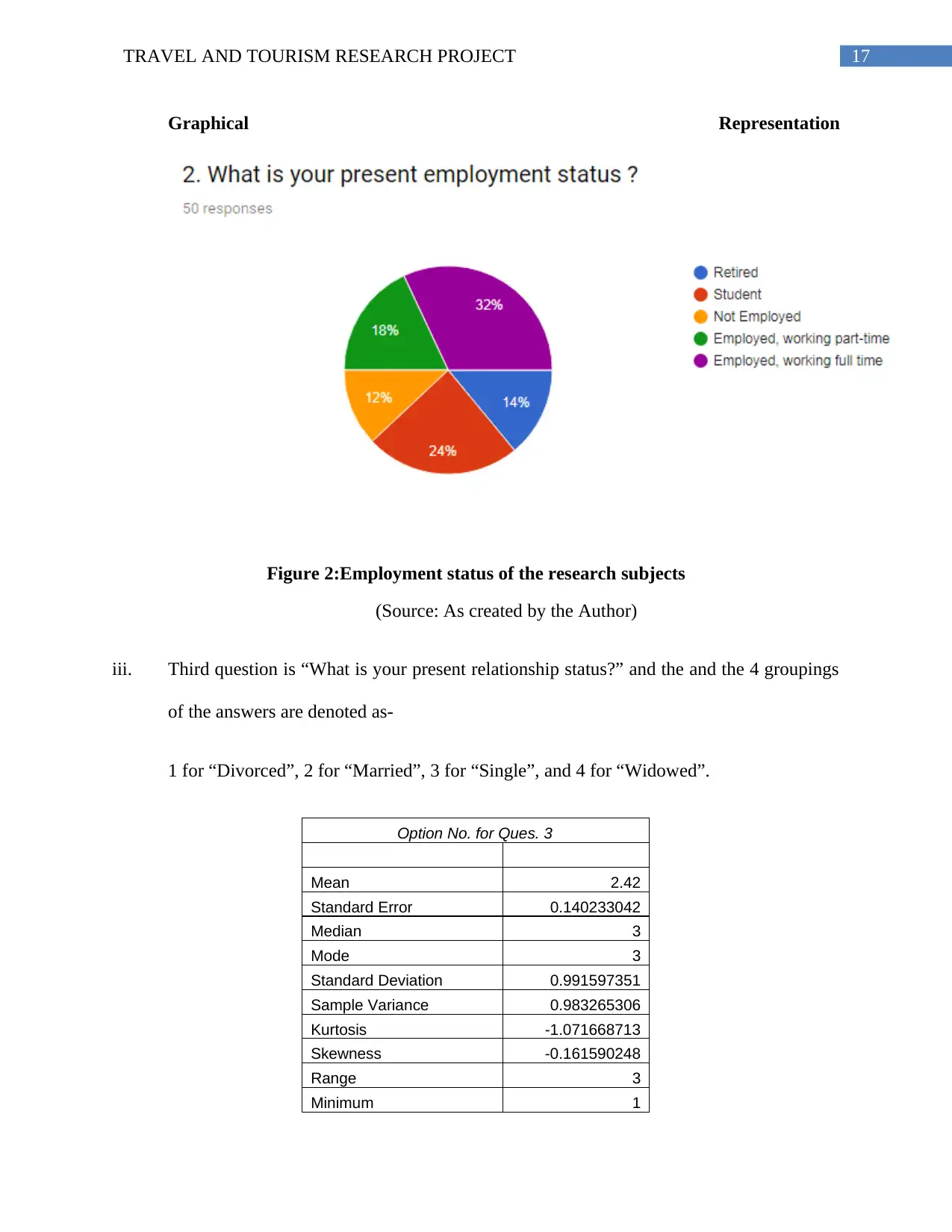
17TRAVEL AND TOURISM RESEARCH PROJECT
Graphical Representation
Figure 2:Employment status of the research subjects
(Source: As created by the Author)
iii. Third question is “What is your present relationship status?” and the and the 4 groupings
of the answers are denoted as-
1 for “Divorced”, 2 for “Married”, 3 for “Single”, and 4 for “Widowed”.
Option No. for Ques. 3
Mean 2.42
Standard Error 0.140233042
Median 3
Mode 3
Standard Deviation 0.991597351
Sample Variance 0.983265306
Kurtosis -1.071668713
Skewness -0.161590248
Range 3
Minimum 1
Graphical Representation
Figure 2:Employment status of the research subjects
(Source: As created by the Author)
iii. Third question is “What is your present relationship status?” and the and the 4 groupings
of the answers are denoted as-
1 for “Divorced”, 2 for “Married”, 3 for “Single”, and 4 for “Widowed”.
Option No. for Ques. 3
Mean 2.42
Standard Error 0.140233042
Median 3
Mode 3
Standard Deviation 0.991597351
Sample Variance 0.983265306
Kurtosis -1.071668713
Skewness -0.161590248
Range 3
Minimum 1
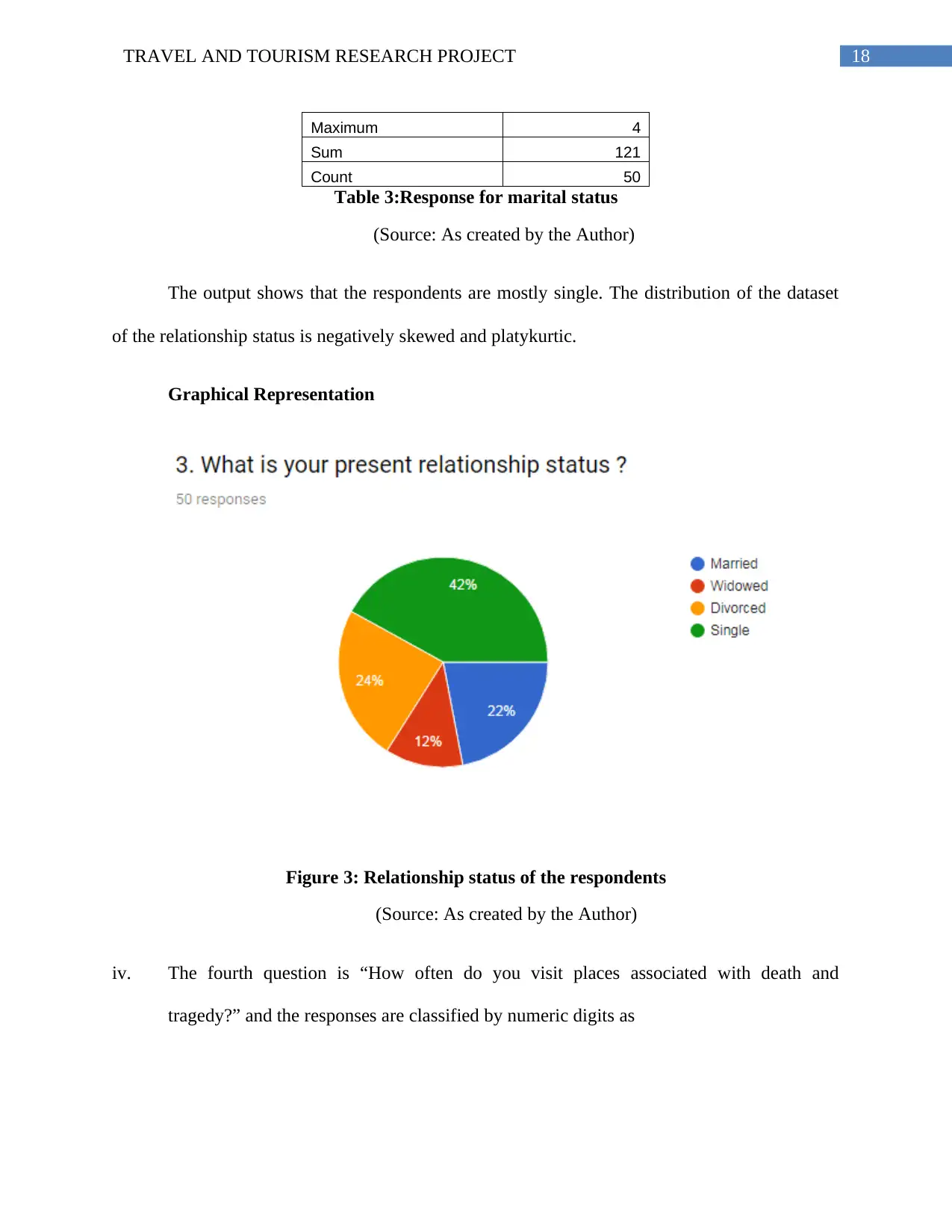
18TRAVEL AND TOURISM RESEARCH PROJECT
Maximum 4
Sum 121
Count 50
Table 3:Response for marital status
(Source: As created by the Author)
The output shows that the respondents are mostly single. The distribution of the dataset
of the relationship status is negatively skewed and platykurtic.
Graphical Representation
Figure 3: Relationship status of the respondents
(Source: As created by the Author)
iv. The fourth question is “How often do you visit places associated with death and
tragedy?” and the responses are classified by numeric digits as
Maximum 4
Sum 121
Count 50
Table 3:Response for marital status
(Source: As created by the Author)
The output shows that the respondents are mostly single. The distribution of the dataset
of the relationship status is negatively skewed and platykurtic.
Graphical Representation
Figure 3: Relationship status of the respondents
(Source: As created by the Author)
iv. The fourth question is “How often do you visit places associated with death and
tragedy?” and the responses are classified by numeric digits as
Paraphrase This Document
Need a fresh take? Get an instant paraphrase of this document with our AI Paraphraser
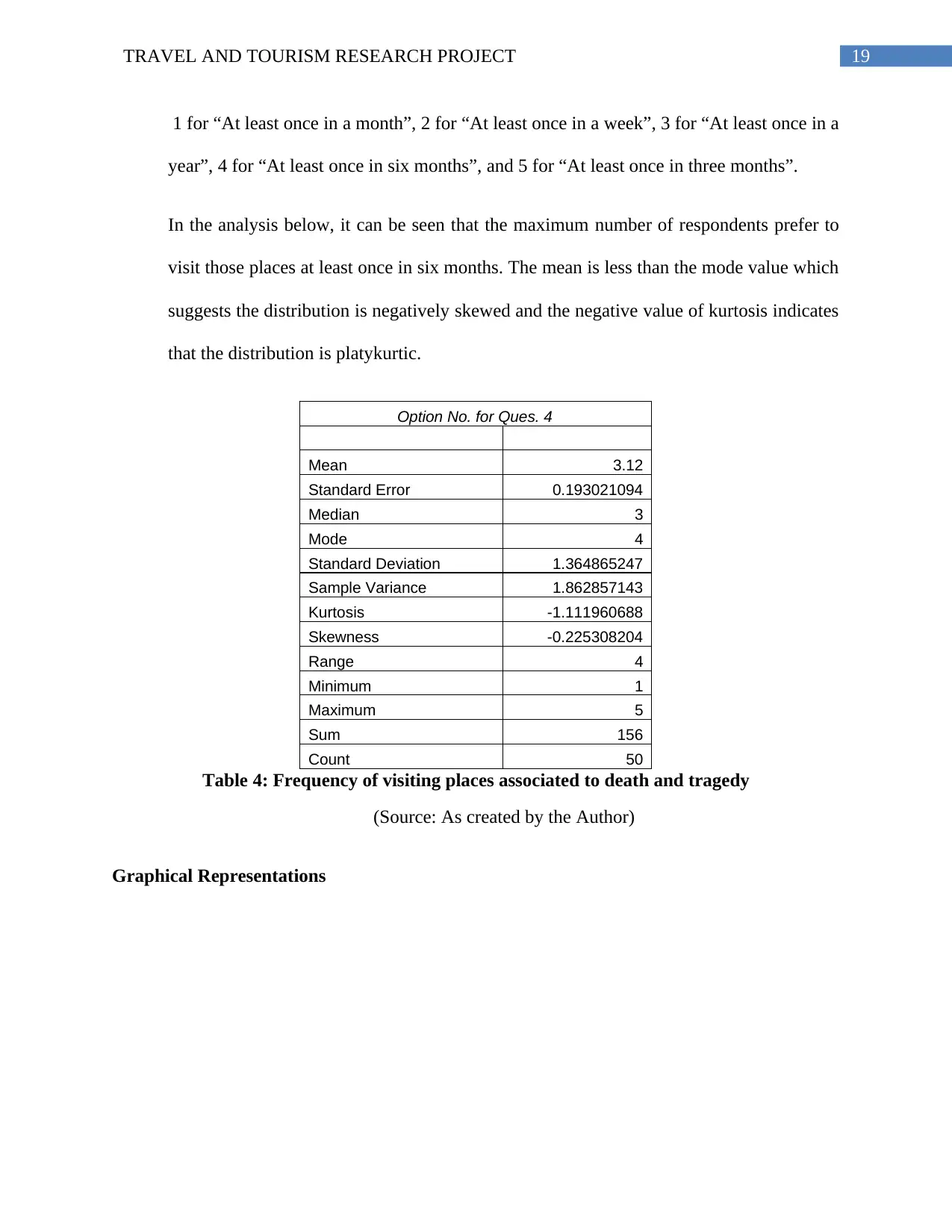
19TRAVEL AND TOURISM RESEARCH PROJECT
1 for “At least once in a month”, 2 for “At least once in a week”, 3 for “At least once in a
year”, 4 for “At least once in six months”, and 5 for “At least once in three months”.
In the analysis below, it can be seen that the maximum number of respondents prefer to
visit those places at least once in six months. The mean is less than the mode value which
suggests the distribution is negatively skewed and the negative value of kurtosis indicates
that the distribution is platykurtic.
Option No. for Ques. 4
Mean 3.12
Standard Error 0.193021094
Median 3
Mode 4
Standard Deviation 1.364865247
Sample Variance 1.862857143
Kurtosis -1.111960688
Skewness -0.225308204
Range 4
Minimum 1
Maximum 5
Sum 156
Count 50
Table 4: Frequency of visiting places associated to death and tragedy
(Source: As created by the Author)
Graphical Representations
1 for “At least once in a month”, 2 for “At least once in a week”, 3 for “At least once in a
year”, 4 for “At least once in six months”, and 5 for “At least once in three months”.
In the analysis below, it can be seen that the maximum number of respondents prefer to
visit those places at least once in six months. The mean is less than the mode value which
suggests the distribution is negatively skewed and the negative value of kurtosis indicates
that the distribution is platykurtic.
Option No. for Ques. 4
Mean 3.12
Standard Error 0.193021094
Median 3
Mode 4
Standard Deviation 1.364865247
Sample Variance 1.862857143
Kurtosis -1.111960688
Skewness -0.225308204
Range 4
Minimum 1
Maximum 5
Sum 156
Count 50
Table 4: Frequency of visiting places associated to death and tragedy
(Source: As created by the Author)
Graphical Representations
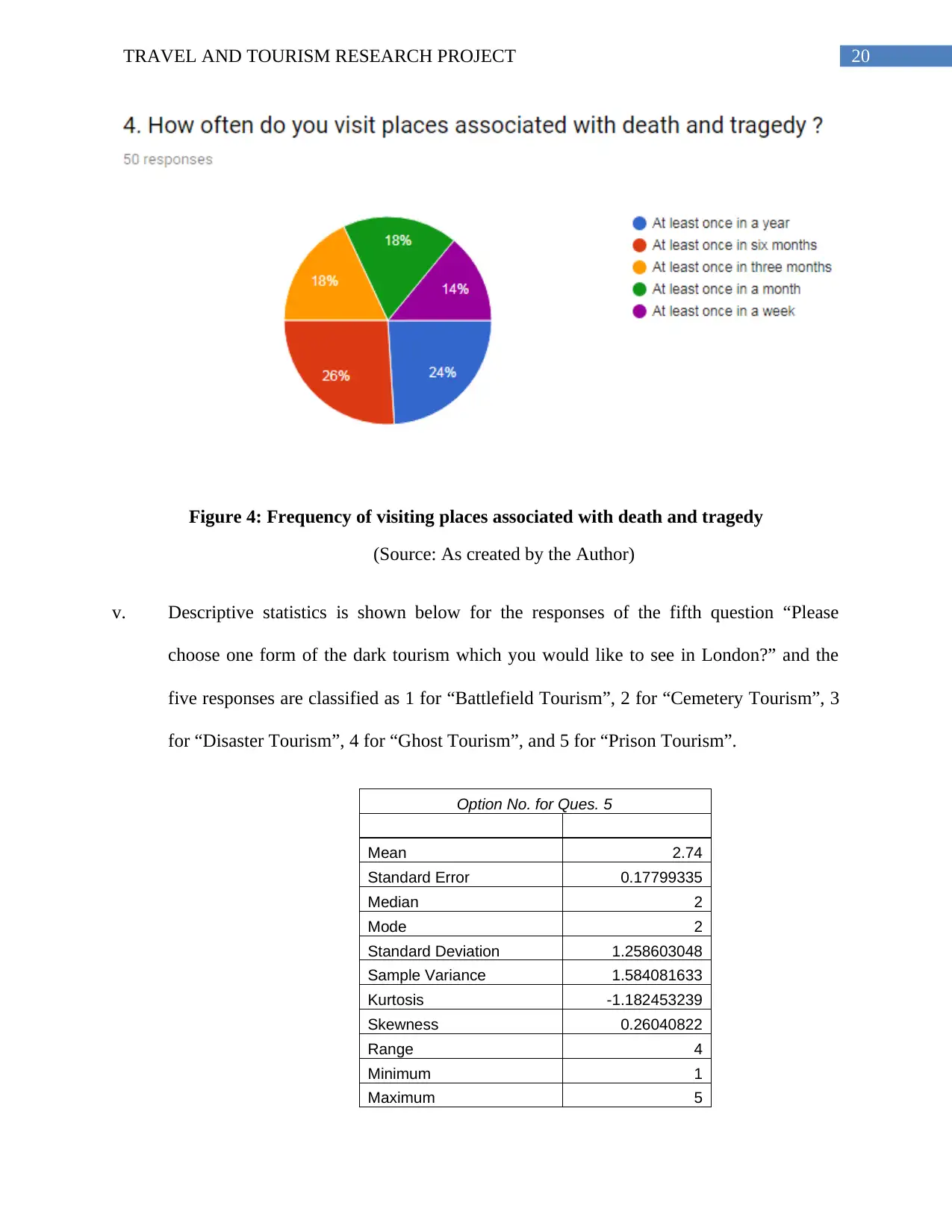
20TRAVEL AND TOURISM RESEARCH PROJECT
Figure 4: Frequency of visiting places associated with death and tragedy
(Source: As created by the Author)
v. Descriptive statistics is shown below for the responses of the fifth question “Please
choose one form of the dark tourism which you would like to see in London?” and the
five responses are classified as 1 for “Battlefield Tourism”, 2 for “Cemetery Tourism”, 3
for “Disaster Tourism”, 4 for “Ghost Tourism”, and 5 for “Prison Tourism”.
Option No. for Ques. 5
Mean 2.74
Standard Error 0.17799335
Median 2
Mode 2
Standard Deviation 1.258603048
Sample Variance 1.584081633
Kurtosis -1.182453239
Skewness 0.26040822
Range 4
Minimum 1
Maximum 5
Figure 4: Frequency of visiting places associated with death and tragedy
(Source: As created by the Author)
v. Descriptive statistics is shown below for the responses of the fifth question “Please
choose one form of the dark tourism which you would like to see in London?” and the
five responses are classified as 1 for “Battlefield Tourism”, 2 for “Cemetery Tourism”, 3
for “Disaster Tourism”, 4 for “Ghost Tourism”, and 5 for “Prison Tourism”.
Option No. for Ques. 5
Mean 2.74
Standard Error 0.17799335
Median 2
Mode 2
Standard Deviation 1.258603048
Sample Variance 1.584081633
Kurtosis -1.182453239
Skewness 0.26040822
Range 4
Minimum 1
Maximum 5
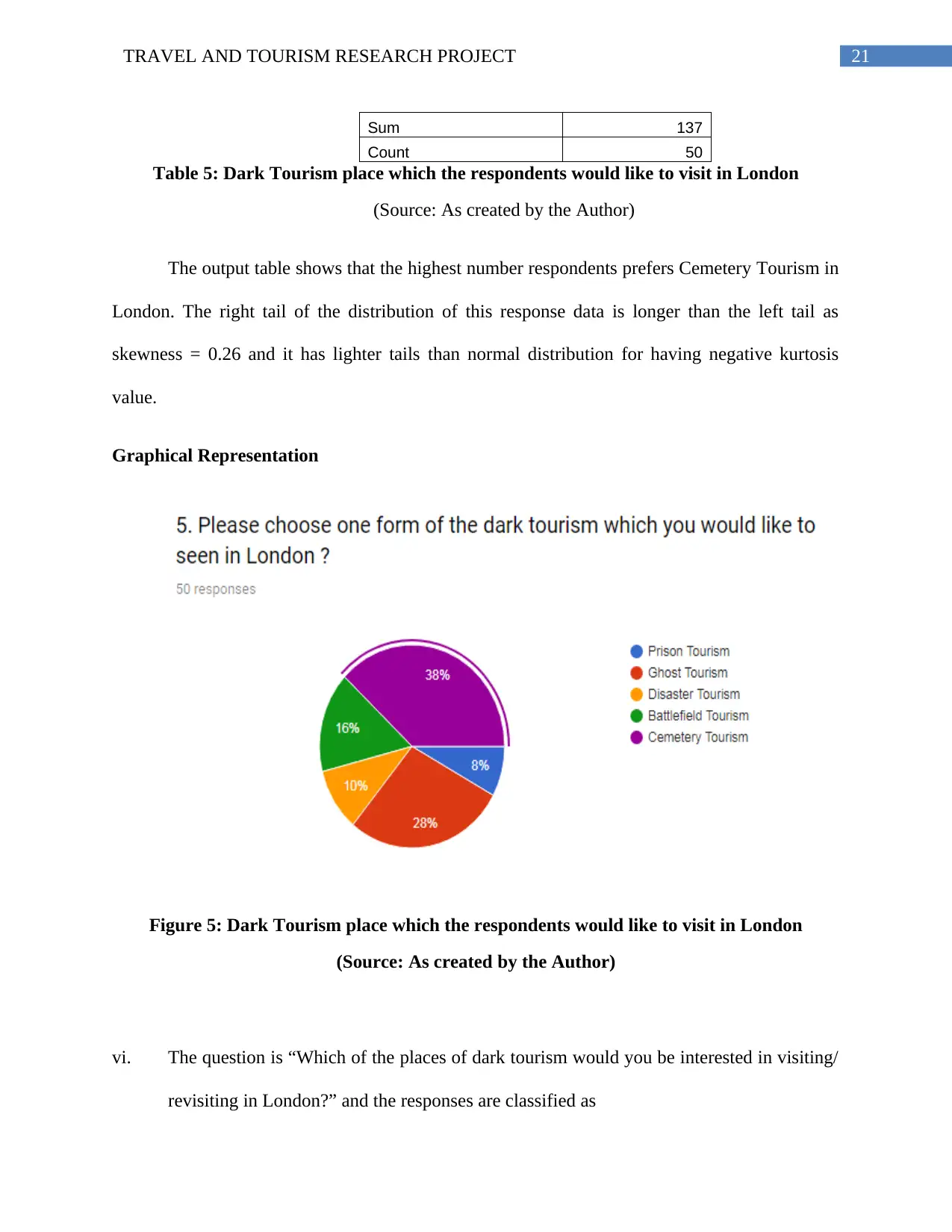
21TRAVEL AND TOURISM RESEARCH PROJECT
Sum 137
Count 50
Table 5: Dark Tourism place which the respondents would like to visit in London
(Source: As created by the Author)
The output table shows that the highest number respondents prefers Cemetery Tourism in
London. The right tail of the distribution of this response data is longer than the left tail as
skewness = 0.26 and it has lighter tails than normal distribution for having negative kurtosis
value.
Graphical Representation
Figure 5: Dark Tourism place which the respondents would like to visit in London
(Source: As created by the Author)
vi. The question is “Which of the places of dark tourism would you be interested in visiting/
revisiting in London?” and the responses are classified as
Sum 137
Count 50
Table 5: Dark Tourism place which the respondents would like to visit in London
(Source: As created by the Author)
The output table shows that the highest number respondents prefers Cemetery Tourism in
London. The right tail of the distribution of this response data is longer than the left tail as
skewness = 0.26 and it has lighter tails than normal distribution for having negative kurtosis
value.
Graphical Representation
Figure 5: Dark Tourism place which the respondents would like to visit in London
(Source: As created by the Author)
vi. The question is “Which of the places of dark tourism would you be interested in visiting/
revisiting in London?” and the responses are classified as
Secure Best Marks with AI Grader
Need help grading? Try our AI Grader for instant feedback on your assignments.
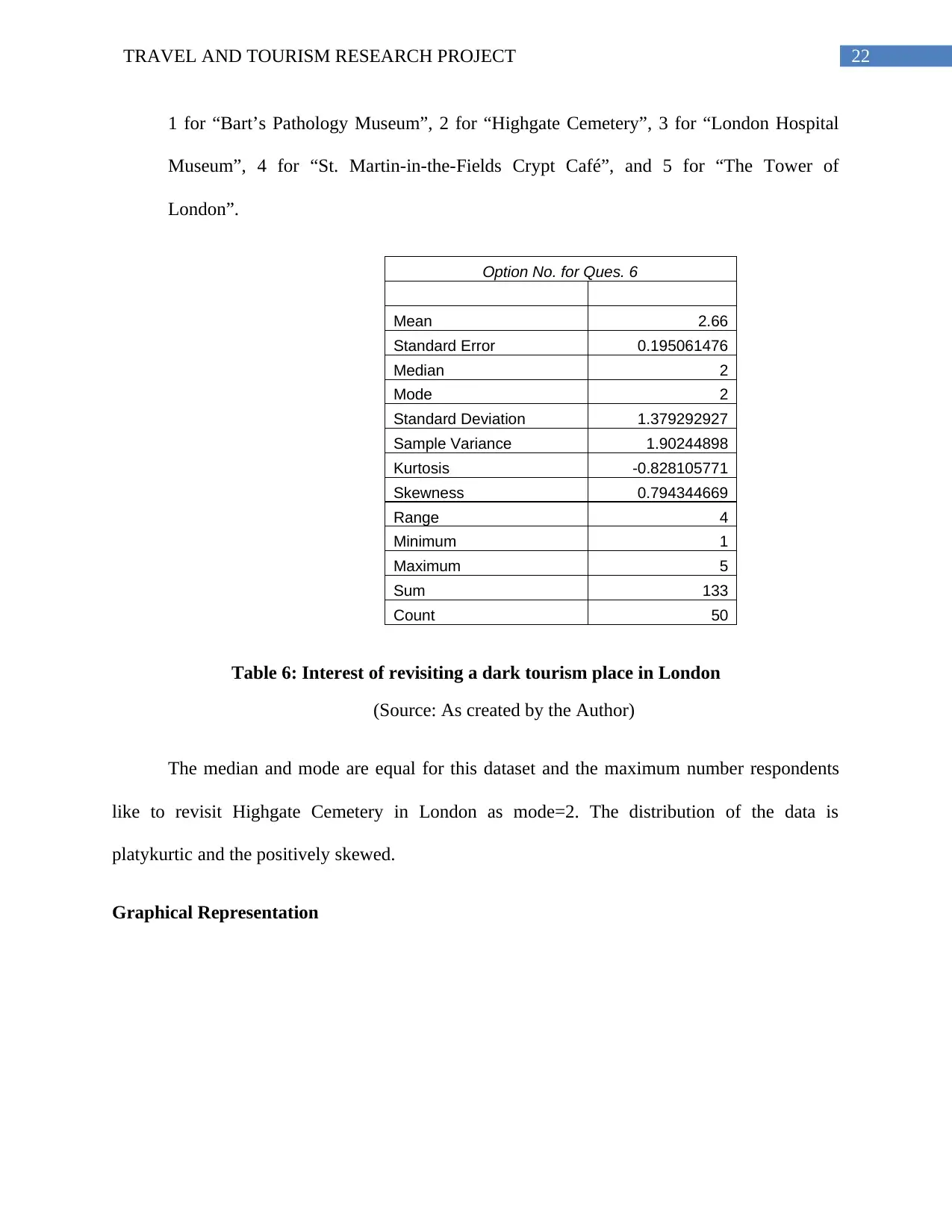
22TRAVEL AND TOURISM RESEARCH PROJECT
1 for “Bart’s Pathology Museum”, 2 for “Highgate Cemetery”, 3 for “London Hospital
Museum”, 4 for “St. Martin-in-the-Fields Crypt Café”, and 5 for “The Tower of
London”.
Option No. for Ques. 6
Mean 2.66
Standard Error 0.195061476
Median 2
Mode 2
Standard Deviation 1.379292927
Sample Variance 1.90244898
Kurtosis -0.828105771
Skewness 0.794344669
Range 4
Minimum 1
Maximum 5
Sum 133
Count 50
Table 6: Interest of revisiting a dark tourism place in London
(Source: As created by the Author)
The median and mode are equal for this dataset and the maximum number respondents
like to revisit Highgate Cemetery in London as mode=2. The distribution of the data is
platykurtic and the positively skewed.
Graphical Representation
1 for “Bart’s Pathology Museum”, 2 for “Highgate Cemetery”, 3 for “London Hospital
Museum”, 4 for “St. Martin-in-the-Fields Crypt Café”, and 5 for “The Tower of
London”.
Option No. for Ques. 6
Mean 2.66
Standard Error 0.195061476
Median 2
Mode 2
Standard Deviation 1.379292927
Sample Variance 1.90244898
Kurtosis -0.828105771
Skewness 0.794344669
Range 4
Minimum 1
Maximum 5
Sum 133
Count 50
Table 6: Interest of revisiting a dark tourism place in London
(Source: As created by the Author)
The median and mode are equal for this dataset and the maximum number respondents
like to revisit Highgate Cemetery in London as mode=2. The distribution of the data is
platykurtic and the positively skewed.
Graphical Representation
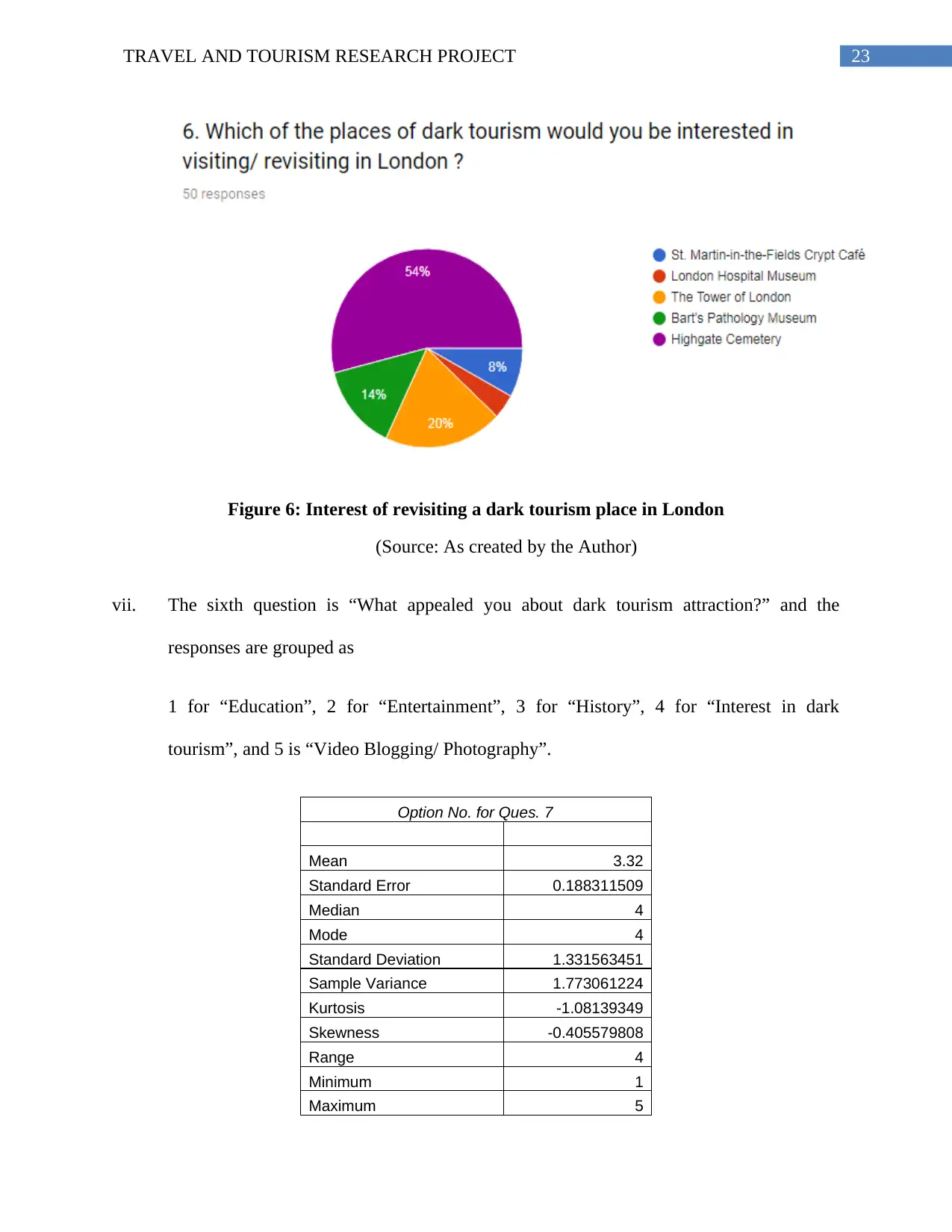
23TRAVEL AND TOURISM RESEARCH PROJECT
Figure 6: Interest of revisiting a dark tourism place in London
(Source: As created by the Author)
vii. The sixth question is “What appealed you about dark tourism attraction?” and the
responses are grouped as
1 for “Education”, 2 for “Entertainment”, 3 for “History”, 4 for “Interest in dark
tourism”, and 5 is “Video Blogging/ Photography”.
Option No. for Ques. 7
Mean 3.32
Standard Error 0.188311509
Median 4
Mode 4
Standard Deviation 1.331563451
Sample Variance 1.773061224
Kurtosis -1.08139349
Skewness -0.405579808
Range 4
Minimum 1
Maximum 5
Figure 6: Interest of revisiting a dark tourism place in London
(Source: As created by the Author)
vii. The sixth question is “What appealed you about dark tourism attraction?” and the
responses are grouped as
1 for “Education”, 2 for “Entertainment”, 3 for “History”, 4 for “Interest in dark
tourism”, and 5 is “Video Blogging/ Photography”.
Option No. for Ques. 7
Mean 3.32
Standard Error 0.188311509
Median 4
Mode 4
Standard Deviation 1.331563451
Sample Variance 1.773061224
Kurtosis -1.08139349
Skewness -0.405579808
Range 4
Minimum 1
Maximum 5
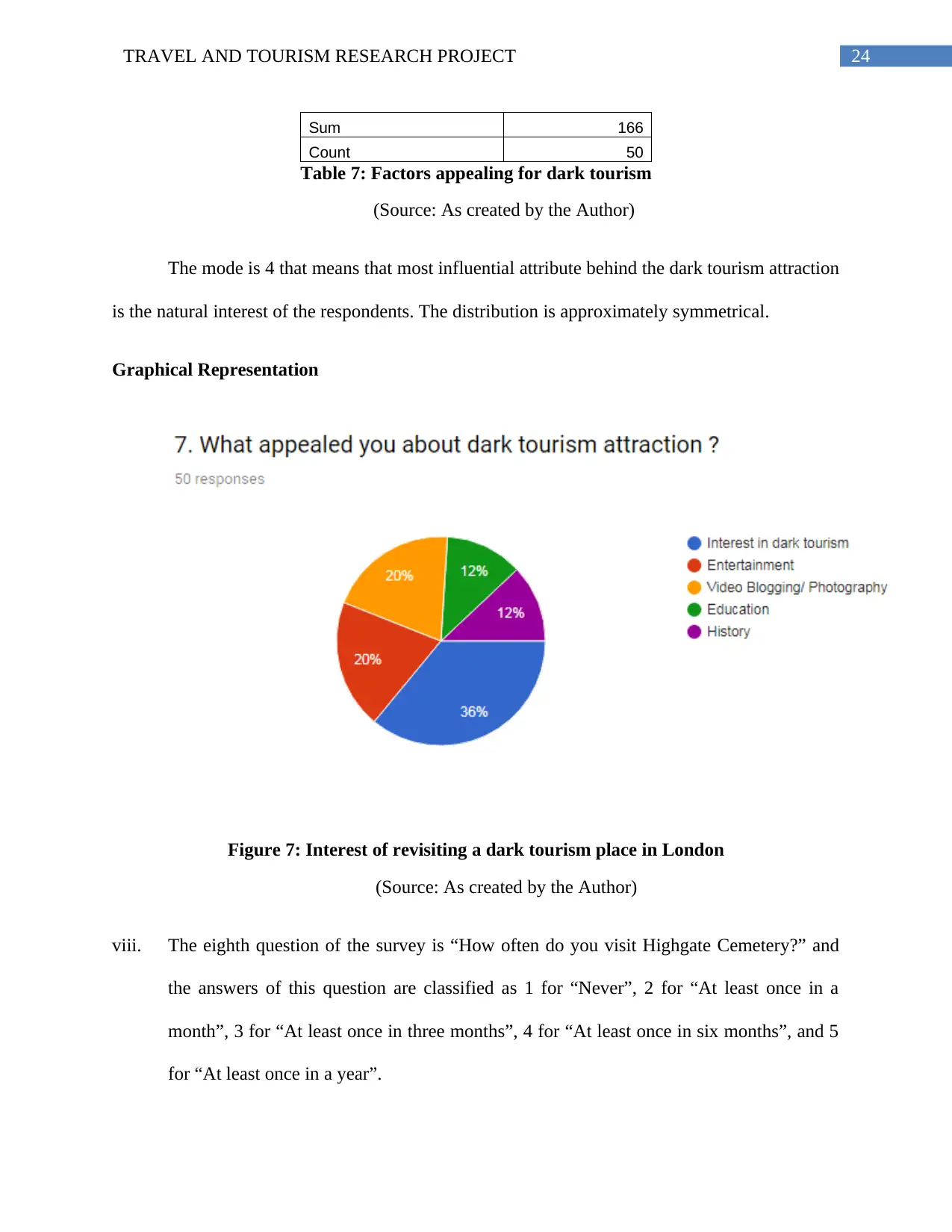
24TRAVEL AND TOURISM RESEARCH PROJECT
Sum 166
Count 50
Table 7: Factors appealing for dark tourism
(Source: As created by the Author)
The mode is 4 that means that most influential attribute behind the dark tourism attraction
is the natural interest of the respondents. The distribution is approximately symmetrical.
Graphical Representation
Figure 7: Interest of revisiting a dark tourism place in London
(Source: As created by the Author)
viii. The eighth question of the survey is “How often do you visit Highgate Cemetery?” and
the answers of this question are classified as 1 for “Never”, 2 for “At least once in a
month”, 3 for “At least once in three months”, 4 for “At least once in six months”, and 5
for “At least once in a year”.
Sum 166
Count 50
Table 7: Factors appealing for dark tourism
(Source: As created by the Author)
The mode is 4 that means that most influential attribute behind the dark tourism attraction
is the natural interest of the respondents. The distribution is approximately symmetrical.
Graphical Representation
Figure 7: Interest of revisiting a dark tourism place in London
(Source: As created by the Author)
viii. The eighth question of the survey is “How often do you visit Highgate Cemetery?” and
the answers of this question are classified as 1 for “Never”, 2 for “At least once in a
month”, 3 for “At least once in three months”, 4 for “At least once in six months”, and 5
for “At least once in a year”.
Paraphrase This Document
Need a fresh take? Get an instant paraphrase of this document with our AI Paraphraser
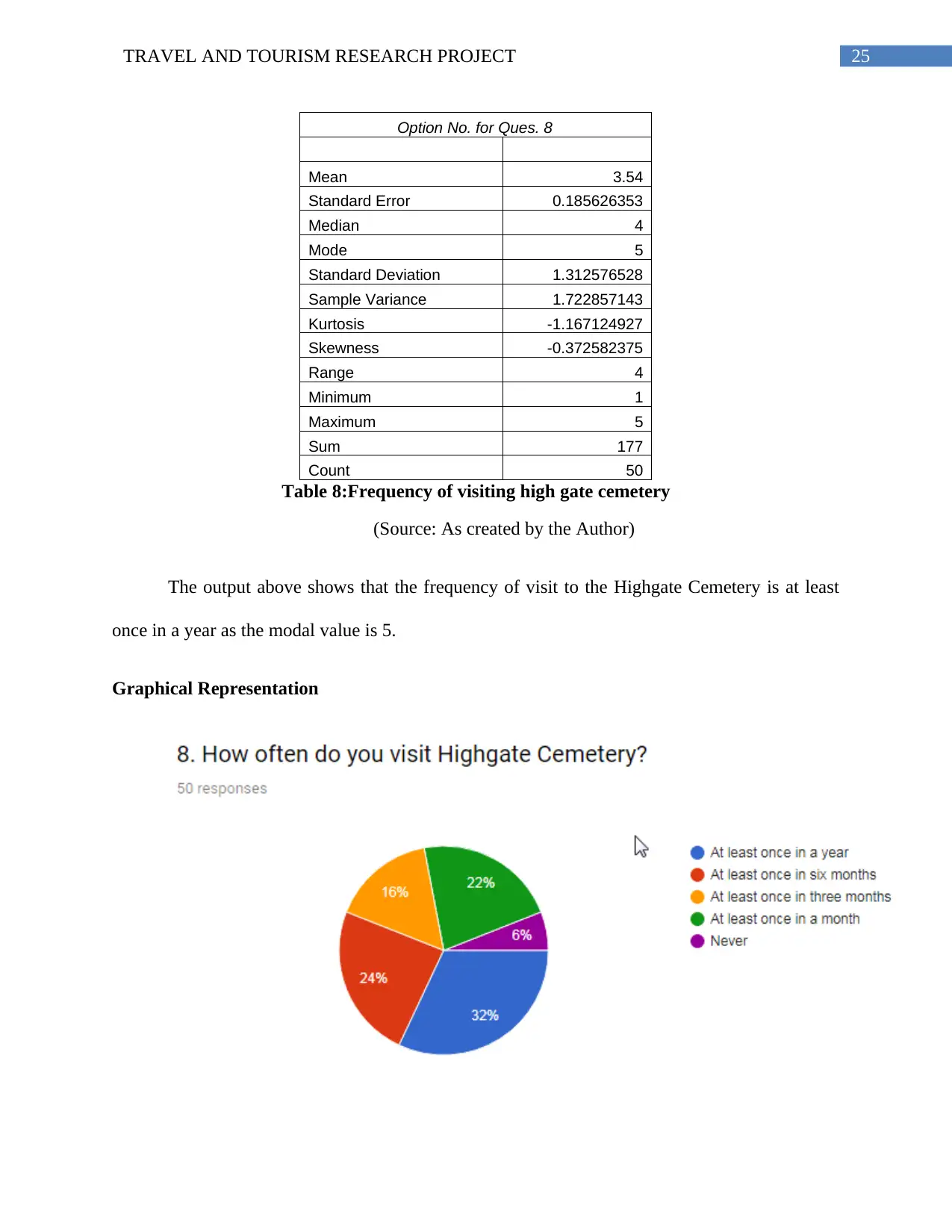
25TRAVEL AND TOURISM RESEARCH PROJECT
Option No. for Ques. 8
Mean 3.54
Standard Error 0.185626353
Median 4
Mode 5
Standard Deviation 1.312576528
Sample Variance 1.722857143
Kurtosis -1.167124927
Skewness -0.372582375
Range 4
Minimum 1
Maximum 5
Sum 177
Count 50
Table 8:Frequency of visiting high gate cemetery
(Source: As created by the Author)
The output above shows that the frequency of visit to the Highgate Cemetery is at least
once in a year as the modal value is 5.
Graphical Representation
Option No. for Ques. 8
Mean 3.54
Standard Error 0.185626353
Median 4
Mode 5
Standard Deviation 1.312576528
Sample Variance 1.722857143
Kurtosis -1.167124927
Skewness -0.372582375
Range 4
Minimum 1
Maximum 5
Sum 177
Count 50
Table 8:Frequency of visiting high gate cemetery
(Source: As created by the Author)
The output above shows that the frequency of visit to the Highgate Cemetery is at least
once in a year as the modal value is 5.
Graphical Representation
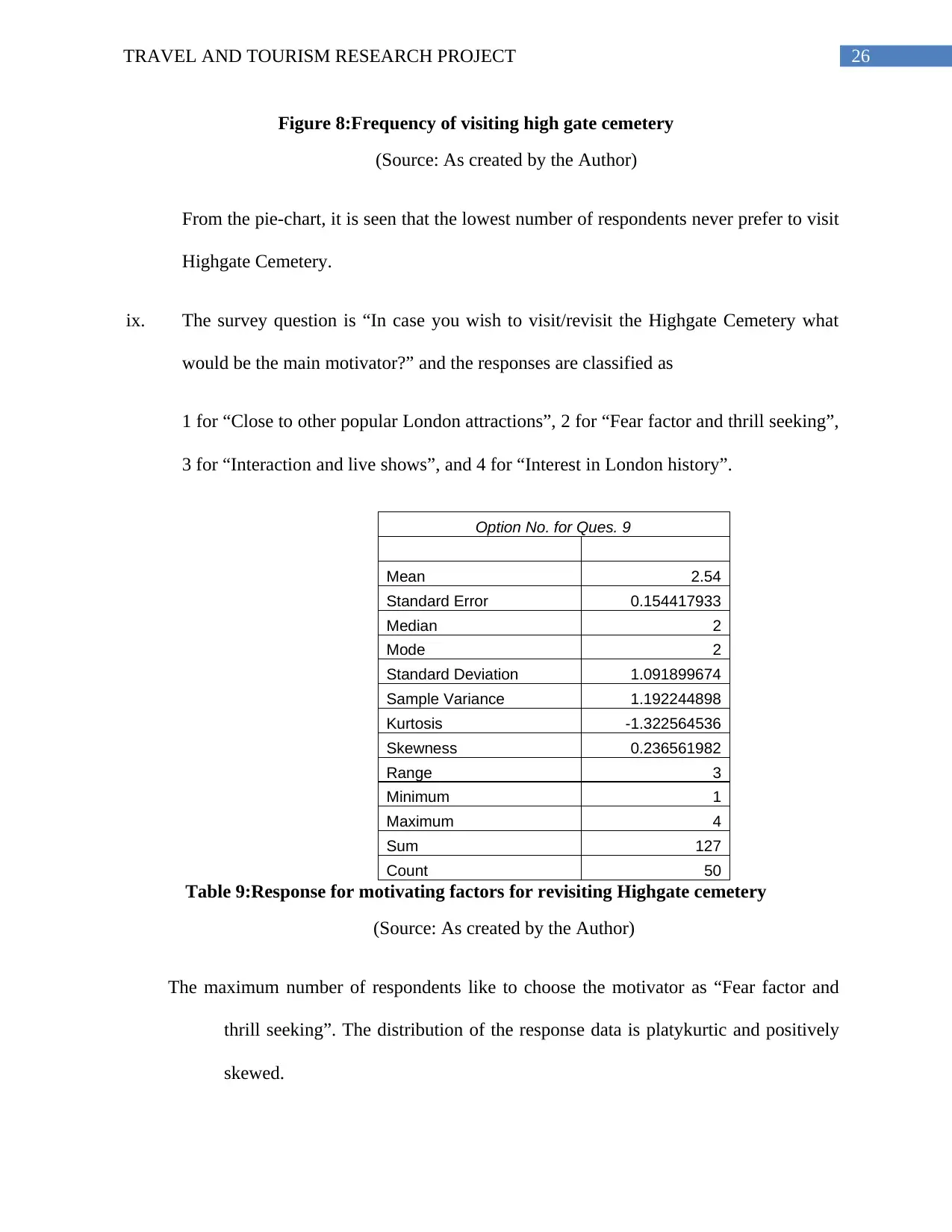
26TRAVEL AND TOURISM RESEARCH PROJECT
Figure 8:Frequency of visiting high gate cemetery
(Source: As created by the Author)
From the pie-chart, it is seen that the lowest number of respondents never prefer to visit
Highgate Cemetery.
ix. The survey question is “In case you wish to visit/revisit the Highgate Cemetery what
would be the main motivator?” and the responses are classified as
1 for “Close to other popular London attractions”, 2 for “Fear factor and thrill seeking”,
3 for “Interaction and live shows”, and 4 for “Interest in London history”.
Option No. for Ques. 9
Mean 2.54
Standard Error 0.154417933
Median 2
Mode 2
Standard Deviation 1.091899674
Sample Variance 1.192244898
Kurtosis -1.322564536
Skewness 0.236561982
Range 3
Minimum 1
Maximum 4
Sum 127
Count 50
Table 9:Response for motivating factors for revisiting Highgate cemetery
(Source: As created by the Author)
The maximum number of respondents like to choose the motivator as “Fear factor and
thrill seeking”. The distribution of the response data is platykurtic and positively
skewed.
Figure 8:Frequency of visiting high gate cemetery
(Source: As created by the Author)
From the pie-chart, it is seen that the lowest number of respondents never prefer to visit
Highgate Cemetery.
ix. The survey question is “In case you wish to visit/revisit the Highgate Cemetery what
would be the main motivator?” and the responses are classified as
1 for “Close to other popular London attractions”, 2 for “Fear factor and thrill seeking”,
3 for “Interaction and live shows”, and 4 for “Interest in London history”.
Option No. for Ques. 9
Mean 2.54
Standard Error 0.154417933
Median 2
Mode 2
Standard Deviation 1.091899674
Sample Variance 1.192244898
Kurtosis -1.322564536
Skewness 0.236561982
Range 3
Minimum 1
Maximum 4
Sum 127
Count 50
Table 9:Response for motivating factors for revisiting Highgate cemetery
(Source: As created by the Author)
The maximum number of respondents like to choose the motivator as “Fear factor and
thrill seeking”. The distribution of the response data is platykurtic and positively
skewed.
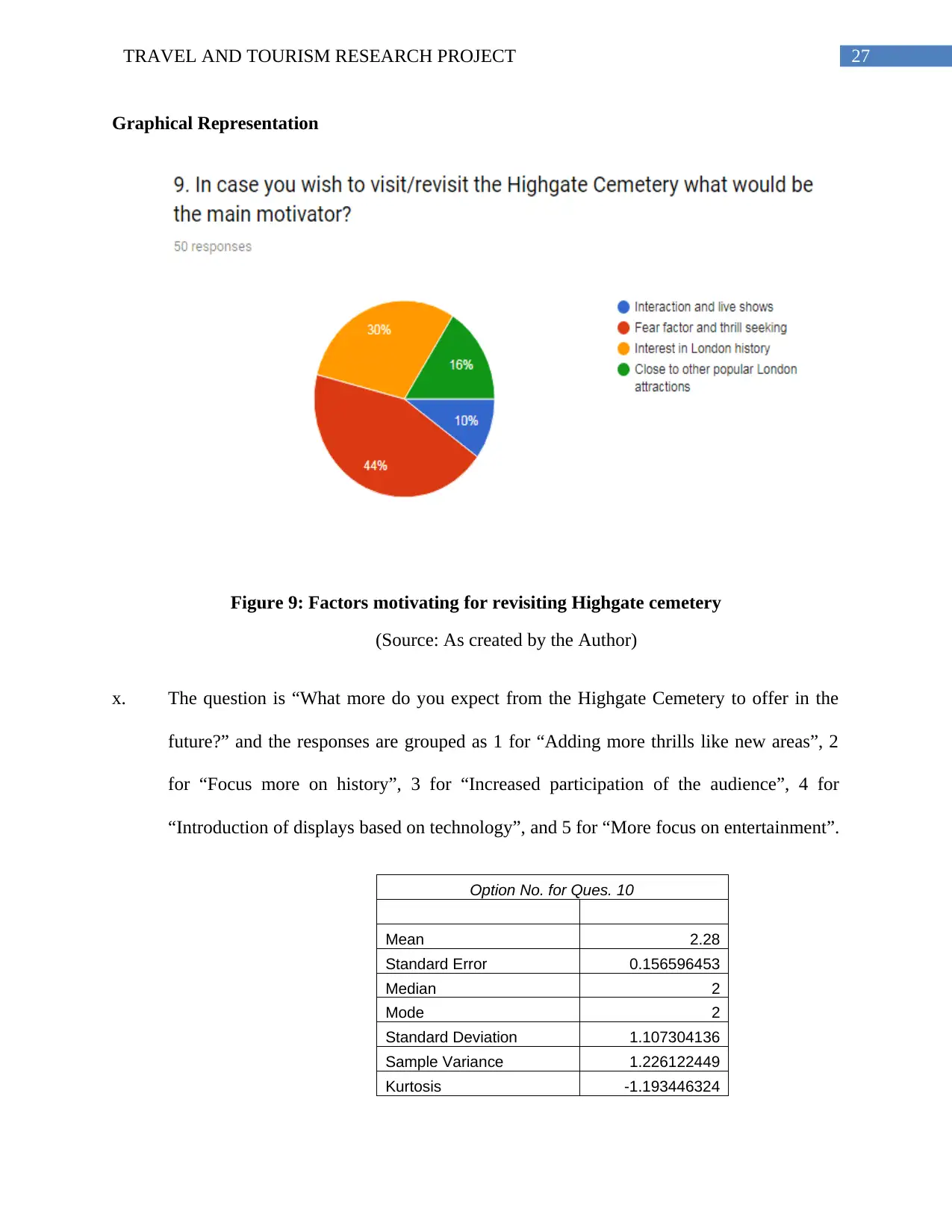
27TRAVEL AND TOURISM RESEARCH PROJECT
Graphical Representation
Figure 9: Factors motivating for revisiting Highgate cemetery
(Source: As created by the Author)
x. The question is “What more do you expect from the Highgate Cemetery to offer in the
future?” and the responses are grouped as 1 for “Adding more thrills like new areas”, 2
for “Focus more on history”, 3 for “Increased participation of the audience”, 4 for
“Introduction of displays based on technology”, and 5 for “More focus on entertainment”.
Option No. for Ques. 10
Mean 2.28
Standard Error 0.156596453
Median 2
Mode 2
Standard Deviation 1.107304136
Sample Variance 1.226122449
Kurtosis -1.193446324
Graphical Representation
Figure 9: Factors motivating for revisiting Highgate cemetery
(Source: As created by the Author)
x. The question is “What more do you expect from the Highgate Cemetery to offer in the
future?” and the responses are grouped as 1 for “Adding more thrills like new areas”, 2
for “Focus more on history”, 3 for “Increased participation of the audience”, 4 for
“Introduction of displays based on technology”, and 5 for “More focus on entertainment”.
Option No. for Ques. 10
Mean 2.28
Standard Error 0.156596453
Median 2
Mode 2
Standard Deviation 1.107304136
Sample Variance 1.226122449
Kurtosis -1.193446324
Secure Best Marks with AI Grader
Need help grading? Try our AI Grader for instant feedback on your assignments.
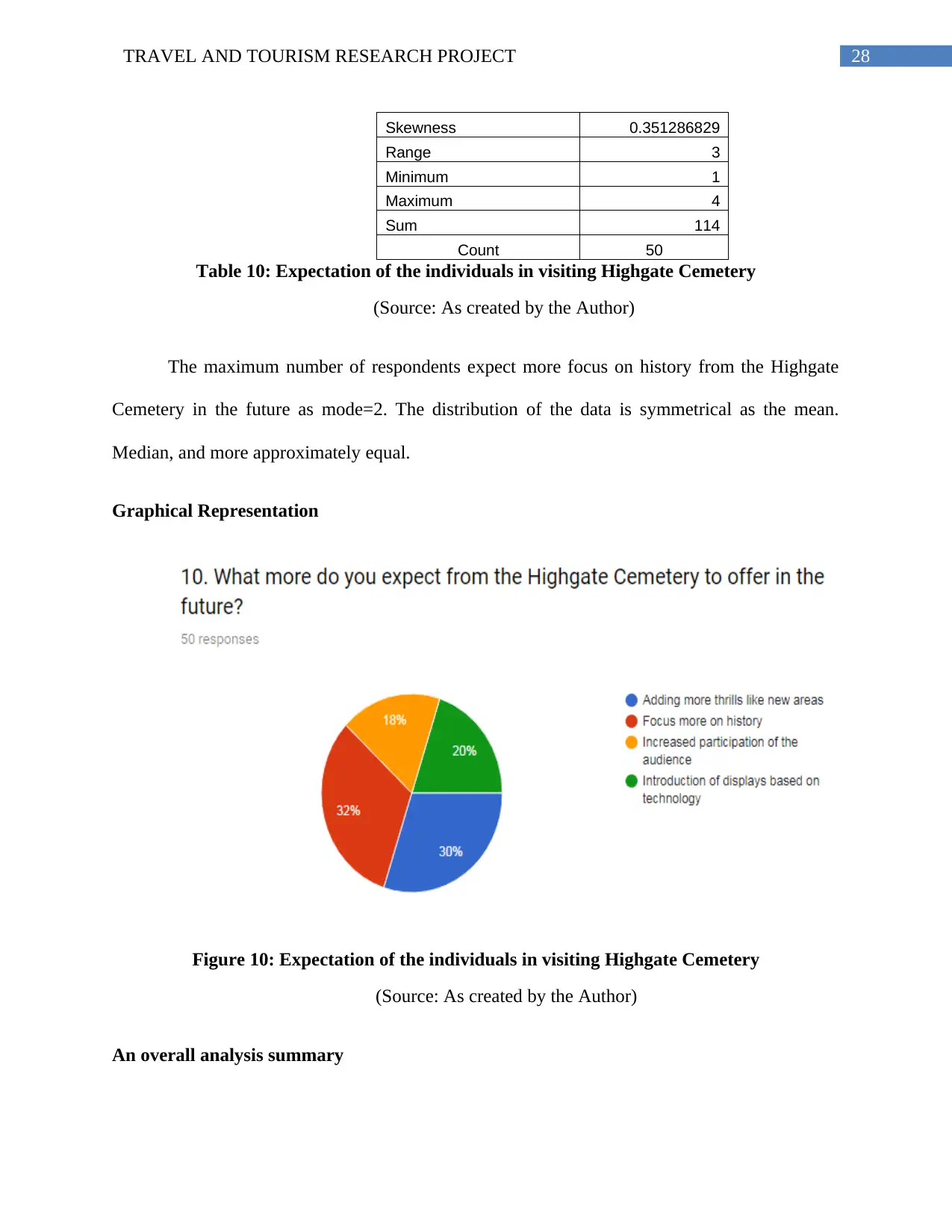
28TRAVEL AND TOURISM RESEARCH PROJECT
Skewness 0.351286829
Range 3
Minimum 1
Maximum 4
Sum 114
Count 50
Table 10: Expectation of the individuals in visiting Highgate Cemetery
(Source: As created by the Author)
The maximum number of respondents expect more focus on history from the Highgate
Cemetery in the future as mode=2. The distribution of the data is symmetrical as the mean.
Median, and more approximately equal.
Graphical Representation
Figure 10: Expectation of the individuals in visiting Highgate Cemetery
(Source: As created by the Author)
An overall analysis summary
Skewness 0.351286829
Range 3
Minimum 1
Maximum 4
Sum 114
Count 50
Table 10: Expectation of the individuals in visiting Highgate Cemetery
(Source: As created by the Author)
The maximum number of respondents expect more focus on history from the Highgate
Cemetery in the future as mode=2. The distribution of the data is symmetrical as the mean.
Median, and more approximately equal.
Graphical Representation
Figure 10: Expectation of the individuals in visiting Highgate Cemetery
(Source: As created by the Author)
An overall analysis summary
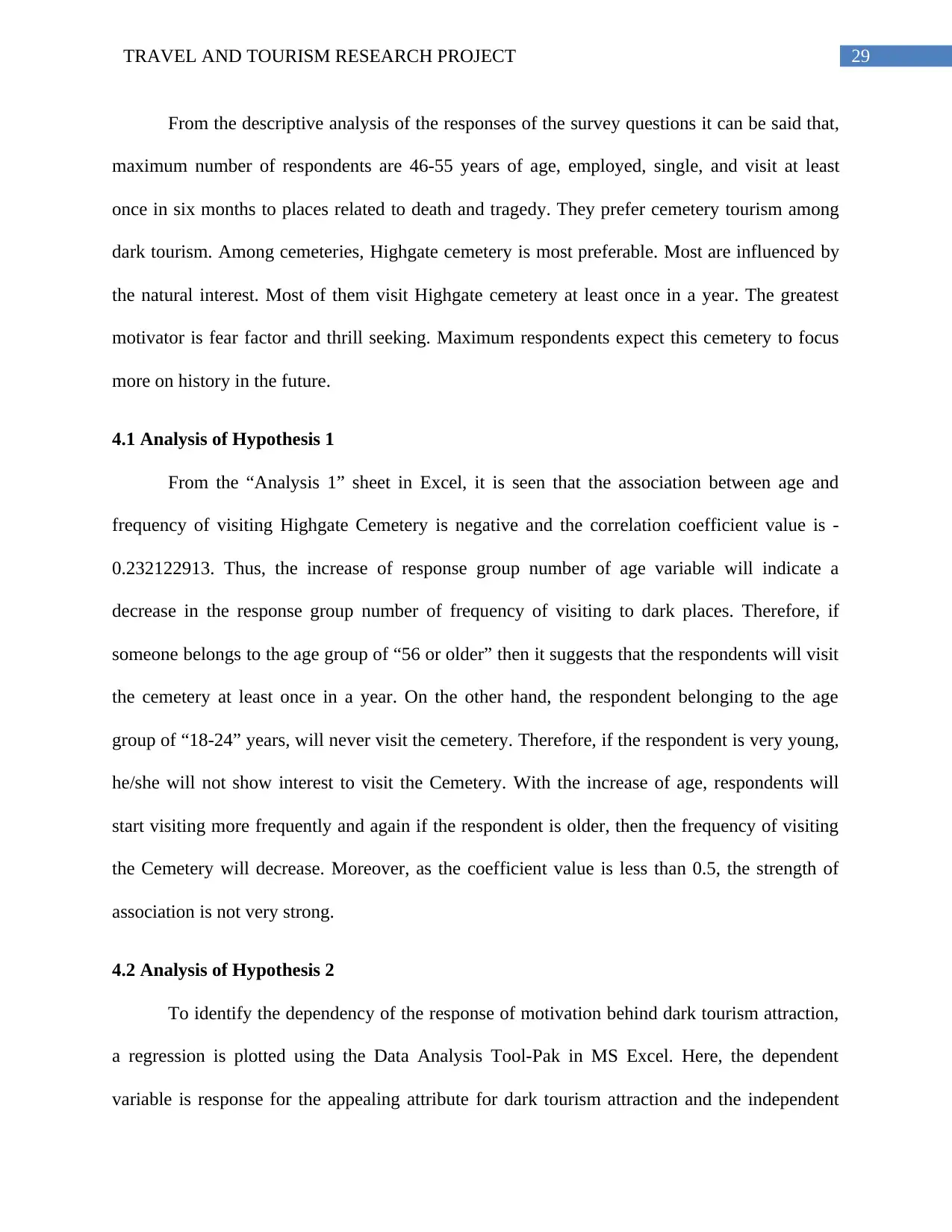
29TRAVEL AND TOURISM RESEARCH PROJECT
From the descriptive analysis of the responses of the survey questions it can be said that,
maximum number of respondents are 46-55 years of age, employed, single, and visit at least
once in six months to places related to death and tragedy. They prefer cemetery tourism among
dark tourism. Among cemeteries, Highgate cemetery is most preferable. Most are influenced by
the natural interest. Most of them visit Highgate cemetery at least once in a year. The greatest
motivator is fear factor and thrill seeking. Maximum respondents expect this cemetery to focus
more on history in the future.
4.1 Analysis of Hypothesis 1
From the “Analysis 1” sheet in Excel, it is seen that the association between age and
frequency of visiting Highgate Cemetery is negative and the correlation coefficient value is -
0.232122913. Thus, the increase of response group number of age variable will indicate a
decrease in the response group number of frequency of visiting to dark places. Therefore, if
someone belongs to the age group of “56 or older” then it suggests that the respondents will visit
the cemetery at least once in a year. On the other hand, the respondent belonging to the age
group of “18-24” years, will never visit the cemetery. Therefore, if the respondent is very young,
he/she will not show interest to visit the Cemetery. With the increase of age, respondents will
start visiting more frequently and again if the respondent is older, then the frequency of visiting
the Cemetery will decrease. Moreover, as the coefficient value is less than 0.5, the strength of
association is not very strong.
4.2 Analysis of Hypothesis 2
To identify the dependency of the response of motivation behind dark tourism attraction,
a regression is plotted using the Data Analysis Tool-Pak in MS Excel. Here, the dependent
variable is response for the appealing attribute for dark tourism attraction and the independent
From the descriptive analysis of the responses of the survey questions it can be said that,
maximum number of respondents are 46-55 years of age, employed, single, and visit at least
once in six months to places related to death and tragedy. They prefer cemetery tourism among
dark tourism. Among cemeteries, Highgate cemetery is most preferable. Most are influenced by
the natural interest. Most of them visit Highgate cemetery at least once in a year. The greatest
motivator is fear factor and thrill seeking. Maximum respondents expect this cemetery to focus
more on history in the future.
4.1 Analysis of Hypothesis 1
From the “Analysis 1” sheet in Excel, it is seen that the association between age and
frequency of visiting Highgate Cemetery is negative and the correlation coefficient value is -
0.232122913. Thus, the increase of response group number of age variable will indicate a
decrease in the response group number of frequency of visiting to dark places. Therefore, if
someone belongs to the age group of “56 or older” then it suggests that the respondents will visit
the cemetery at least once in a year. On the other hand, the respondent belonging to the age
group of “18-24” years, will never visit the cemetery. Therefore, if the respondent is very young,
he/she will not show interest to visit the Cemetery. With the increase of age, respondents will
start visiting more frequently and again if the respondent is older, then the frequency of visiting
the Cemetery will decrease. Moreover, as the coefficient value is less than 0.5, the strength of
association is not very strong.
4.2 Analysis of Hypothesis 2
To identify the dependency of the response of motivation behind dark tourism attraction,
a regression is plotted using the Data Analysis Tool-Pak in MS Excel. Here, the dependent
variable is response for the appealing attribute for dark tourism attraction and the independent
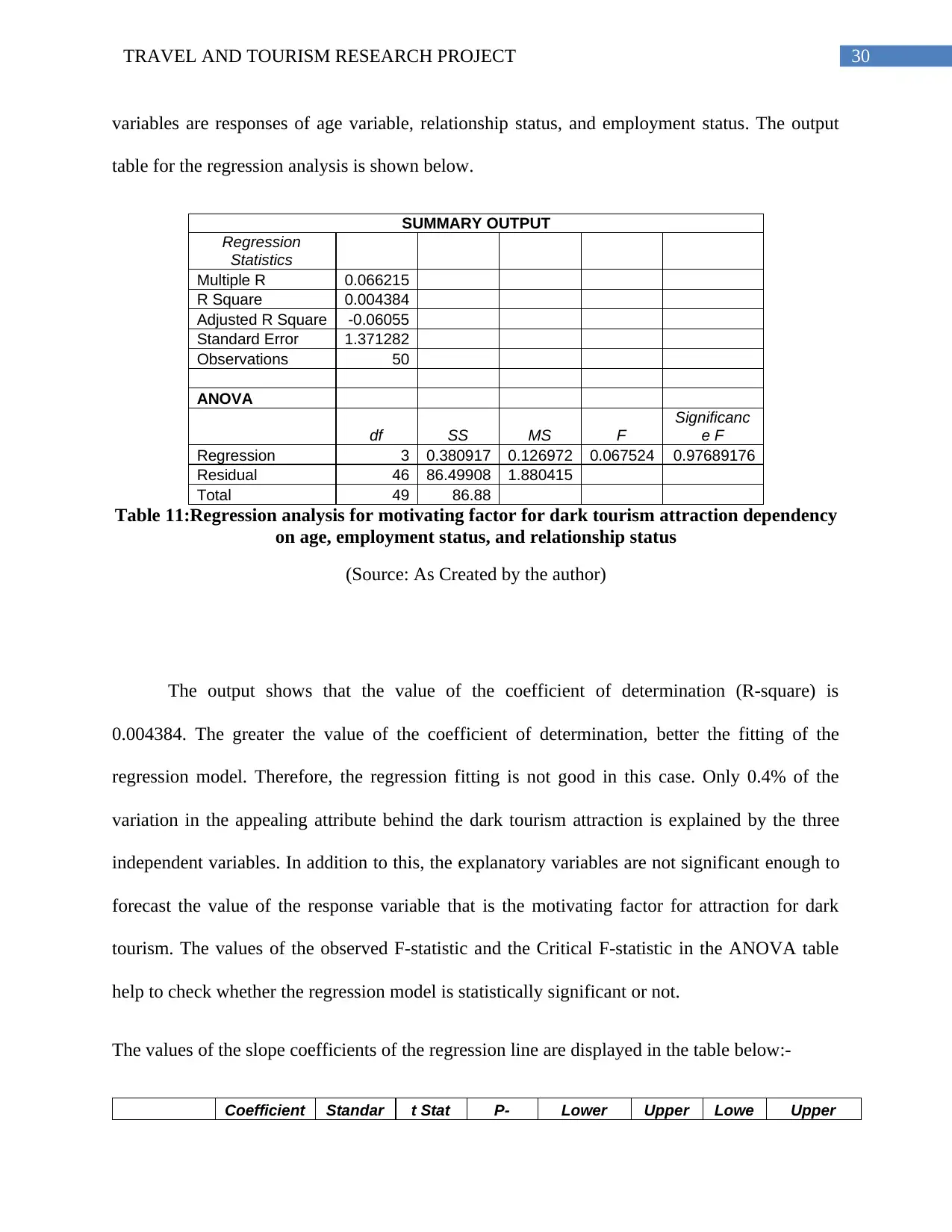
30TRAVEL AND TOURISM RESEARCH PROJECT
variables are responses of age variable, relationship status, and employment status. The output
table for the regression analysis is shown below.
SUMMARY OUTPUT
Regression
Statistics
Multiple R 0.066215
R Square 0.004384
Adjusted R Square -0.06055
Standard Error 1.371282
Observations 50
ANOVA
df SS MS F
Significanc
e F
Regression 3 0.380917 0.126972 0.067524 0.97689176
Residual 46 86.49908 1.880415
Total 49 86.88
Table 11:Regression analysis for motivating factor for dark tourism attraction dependency
on age, employment status, and relationship status
(Source: As Created by the author)
The output shows that the value of the coefficient of determination (R-square) is
0.004384. The greater the value of the coefficient of determination, better the fitting of the
regression model. Therefore, the regression fitting is not good in this case. Only 0.4% of the
variation in the appealing attribute behind the dark tourism attraction is explained by the three
independent variables. In addition to this, the explanatory variables are not significant enough to
forecast the value of the response variable that is the motivating factor for attraction for dark
tourism. The values of the observed F-statistic and the Critical F-statistic in the ANOVA table
help to check whether the regression model is statistically significant or not.
The values of the slope coefficients of the regression line are displayed in the table below:-
Coefficient Standar t Stat P- Lower Upper Lowe Upper
variables are responses of age variable, relationship status, and employment status. The output
table for the regression analysis is shown below.
SUMMARY OUTPUT
Regression
Statistics
Multiple R 0.066215
R Square 0.004384
Adjusted R Square -0.06055
Standard Error 1.371282
Observations 50
ANOVA
df SS MS F
Significanc
e F
Regression 3 0.380917 0.126972 0.067524 0.97689176
Residual 46 86.49908 1.880415
Total 49 86.88
Table 11:Regression analysis for motivating factor for dark tourism attraction dependency
on age, employment status, and relationship status
(Source: As Created by the author)
The output shows that the value of the coefficient of determination (R-square) is
0.004384. The greater the value of the coefficient of determination, better the fitting of the
regression model. Therefore, the regression fitting is not good in this case. Only 0.4% of the
variation in the appealing attribute behind the dark tourism attraction is explained by the three
independent variables. In addition to this, the explanatory variables are not significant enough to
forecast the value of the response variable that is the motivating factor for attraction for dark
tourism. The values of the observed F-statistic and the Critical F-statistic in the ANOVA table
help to check whether the regression model is statistically significant or not.
The values of the slope coefficients of the regression line are displayed in the table below:-
Coefficient Standar t Stat P- Lower Upper Lowe Upper
Paraphrase This Document
Need a fresh take? Get an instant paraphrase of this document with our AI Paraphraser
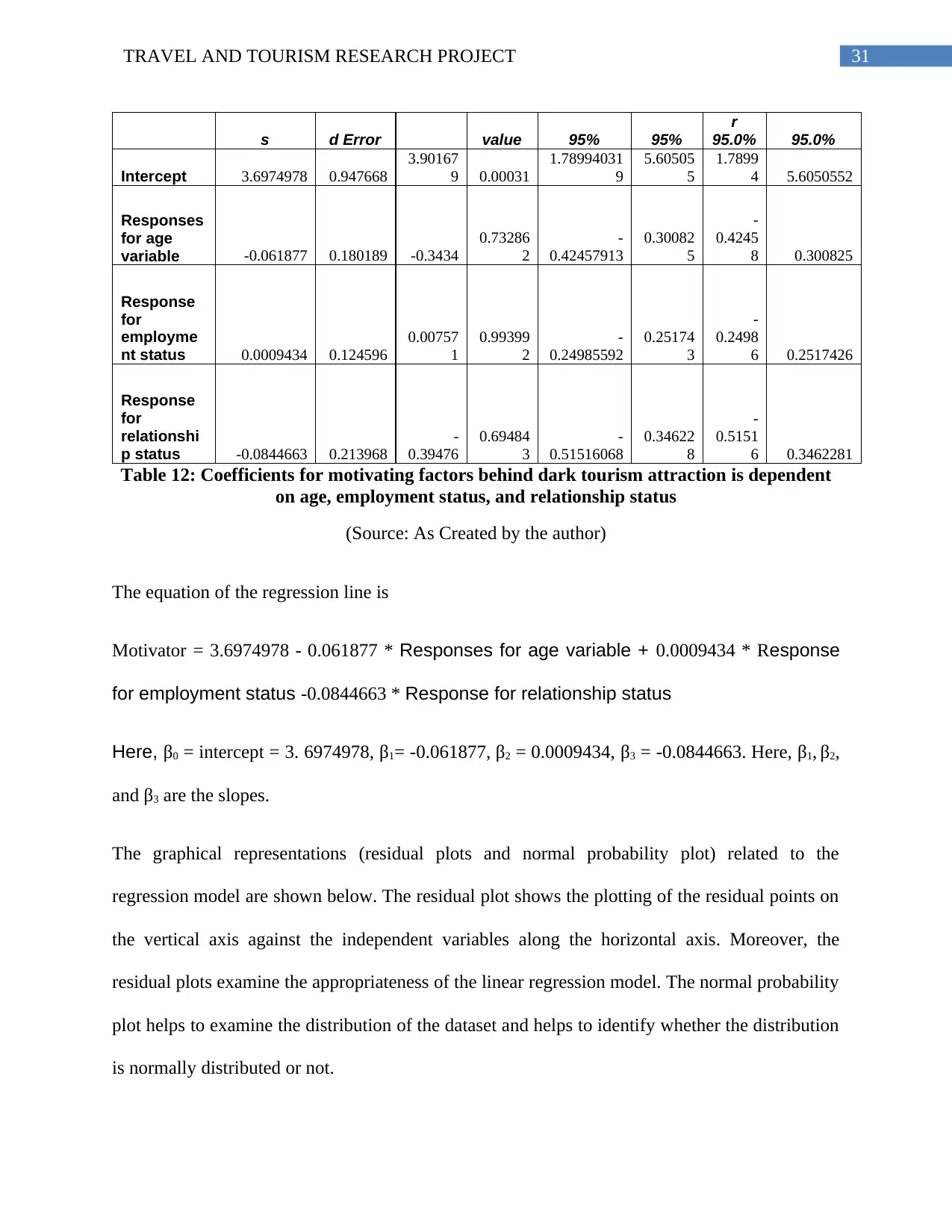
31TRAVEL AND TOURISM RESEARCH PROJECT
s d Error value 95% 95%
r
95.0% 95.0%
Intercept 3.6974978 0.947668
3.90167
9 0.00031
1.78994031
9
5.60505
5
1.7899
4 5.6050552
Responses
for age
variable -0.061877 0.180189 -0.3434
0.73286
2
-
0.42457913
0.30082
5
-
0.4245
8 0.300825
Response
for
employme
nt status 0.0009434 0.124596
0.00757
1
0.99399
2
-
0.24985592
0.25174
3
-
0.2498
6 0.2517426
Response
for
relationshi
p status -0.0844663 0.213968
-
0.39476
0.69484
3
-
0.51516068
0.34622
8
-
0.5151
6 0.3462281
Table 12: Coefficients for motivating factors behind dark tourism attraction is dependent
on age, employment status, and relationship status
(Source: As Created by the author)
The equation of the regression line is
Motivator = 3.6974978 - 0.061877 * Responses for age variable + 0.0009434 * Response
for employment status -0.0844663 * Response for relationship status
Here, β0 = intercept = 3. 6974978, β1= -0.061877, β2 = 0.0009434, β3 = -0.0844663. Here, β1, β2,
and β3 are the slopes.
The graphical representations (residual plots and normal probability plot) related to the
regression model are shown below. The residual plot shows the plotting of the residual points on
the vertical axis against the independent variables along the horizontal axis. Moreover, the
residual plots examine the appropriateness of the linear regression model. The normal probability
plot helps to examine the distribution of the dataset and helps to identify whether the distribution
is normally distributed or not.
s d Error value 95% 95%
r
95.0% 95.0%
Intercept 3.6974978 0.947668
3.90167
9 0.00031
1.78994031
9
5.60505
5
1.7899
4 5.6050552
Responses
for age
variable -0.061877 0.180189 -0.3434
0.73286
2
-
0.42457913
0.30082
5
-
0.4245
8 0.300825
Response
for
employme
nt status 0.0009434 0.124596
0.00757
1
0.99399
2
-
0.24985592
0.25174
3
-
0.2498
6 0.2517426
Response
for
relationshi
p status -0.0844663 0.213968
-
0.39476
0.69484
3
-
0.51516068
0.34622
8
-
0.5151
6 0.3462281
Table 12: Coefficients for motivating factors behind dark tourism attraction is dependent
on age, employment status, and relationship status
(Source: As Created by the author)
The equation of the regression line is
Motivator = 3.6974978 - 0.061877 * Responses for age variable + 0.0009434 * Response
for employment status -0.0844663 * Response for relationship status
Here, β0 = intercept = 3. 6974978, β1= -0.061877, β2 = 0.0009434, β3 = -0.0844663. Here, β1, β2,
and β3 are the slopes.
The graphical representations (residual plots and normal probability plot) related to the
regression model are shown below. The residual plot shows the plotting of the residual points on
the vertical axis against the independent variables along the horizontal axis. Moreover, the
residual plots examine the appropriateness of the linear regression model. The normal probability
plot helps to examine the distribution of the dataset and helps to identify whether the distribution
is normally distributed or not.
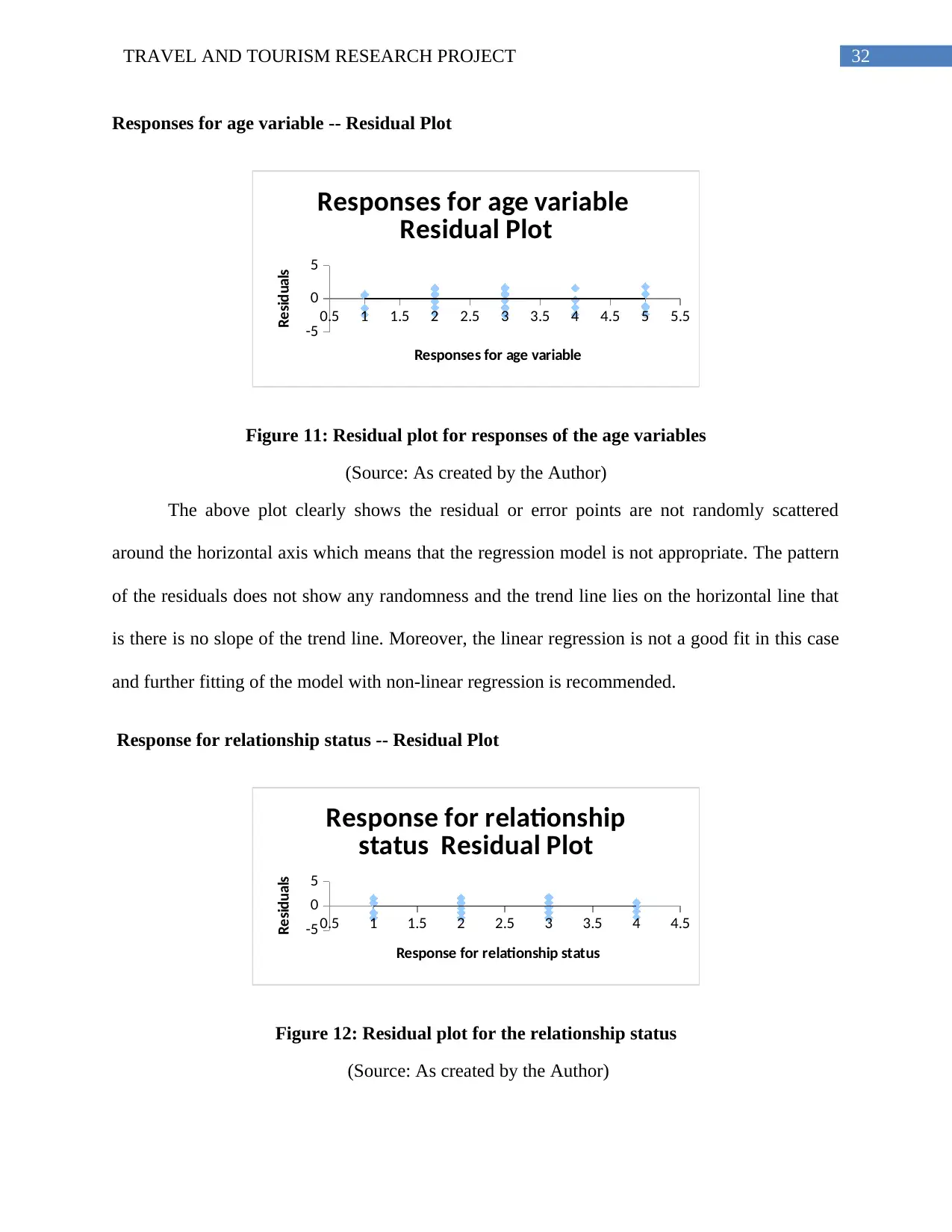
32TRAVEL AND TOURISM RESEARCH PROJECT
Responses for age variable -- Residual Plot
0.5 1 1.5 2 2.5 3 3.5 4 4.5 5 5.5
-5
0
5
Responses for age variable
Residual Plot
Responses for age variable
Residuals
Figure 11: Residual plot for responses of the age variables
(Source: As created by the Author)
The above plot clearly shows the residual or error points are not randomly scattered
around the horizontal axis which means that the regression model is not appropriate. The pattern
of the residuals does not show any randomness and the trend line lies on the horizontal line that
is there is no slope of the trend line. Moreover, the linear regression is not a good fit in this case
and further fitting of the model with non-linear regression is recommended.
Response for relationship status -- Residual Plot
0.5 1 1.5 2 2.5 3 3.5 4 4.5-5
0
5
Response for relationship
status Residual Plot
Response for relationship status
Residuals
Figure 12: Residual plot for the relationship status
(Source: As created by the Author)
Responses for age variable -- Residual Plot
0.5 1 1.5 2 2.5 3 3.5 4 4.5 5 5.5
-5
0
5
Responses for age variable
Residual Plot
Responses for age variable
Residuals
Figure 11: Residual plot for responses of the age variables
(Source: As created by the Author)
The above plot clearly shows the residual or error points are not randomly scattered
around the horizontal axis which means that the regression model is not appropriate. The pattern
of the residuals does not show any randomness and the trend line lies on the horizontal line that
is there is no slope of the trend line. Moreover, the linear regression is not a good fit in this case
and further fitting of the model with non-linear regression is recommended.
Response for relationship status -- Residual Plot
0.5 1 1.5 2 2.5 3 3.5 4 4.5-5
0
5
Response for relationship
status Residual Plot
Response for relationship status
Residuals
Figure 12: Residual plot for the relationship status
(Source: As created by the Author)
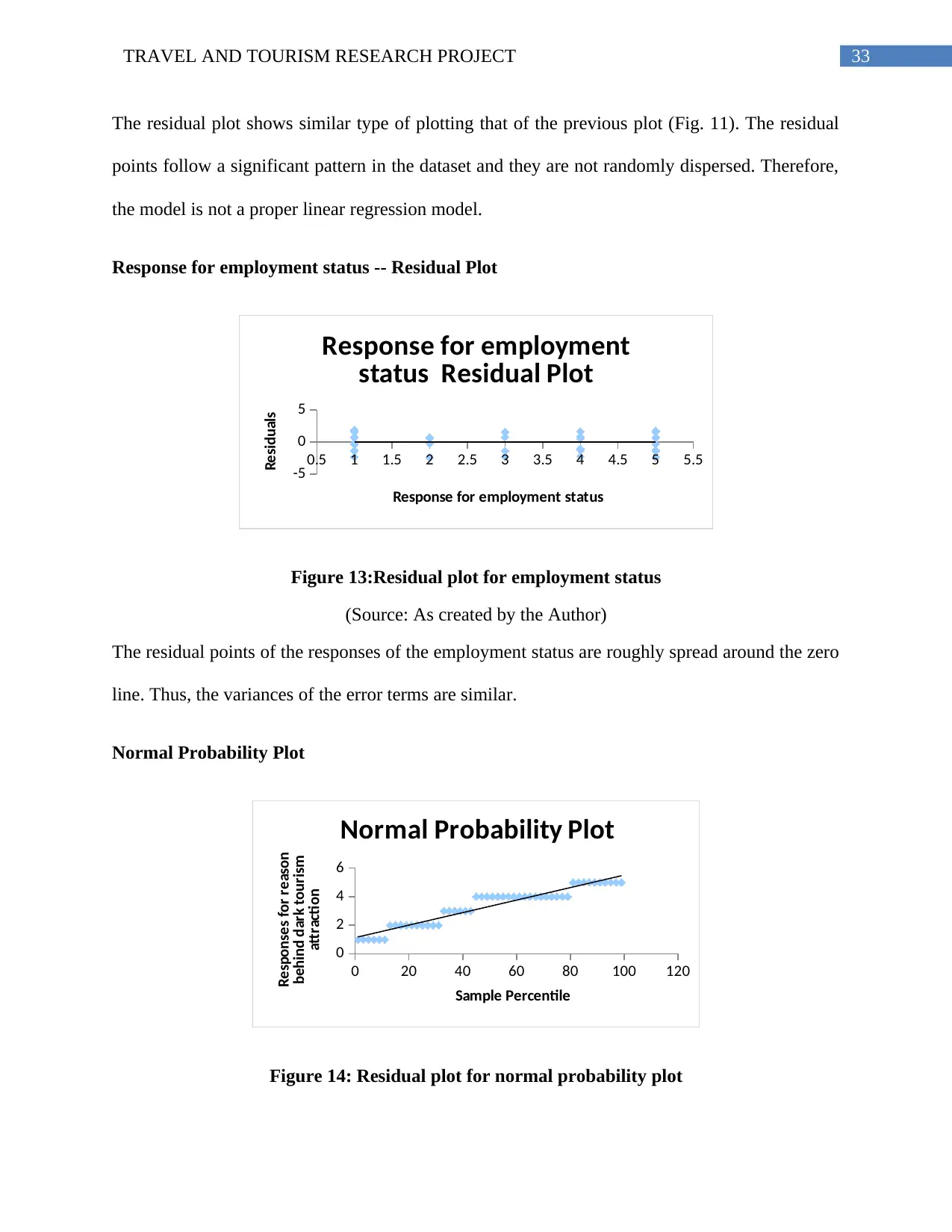
33TRAVEL AND TOURISM RESEARCH PROJECT
The residual plot shows similar type of plotting that of the previous plot (Fig. 11). The residual
points follow a significant pattern in the dataset and they are not randomly dispersed. Therefore,
the model is not a proper linear regression model.
Response for employment status -- Residual Plot
0.5 1 1.5 2 2.5 3 3.5 4 4.5 5 5.5
-5
0
5
Response for employment
status Residual Plot
Response for employment status
Residuals
Figure 13:Residual plot for employment status
(Source: As created by the Author)
The residual points of the responses of the employment status are roughly spread around the zero
line. Thus, the variances of the error terms are similar.
Normal Probability Plot
0 20 40 60 80 100 120
0
2
4
6
Normal Probability Plot
Sample Percentile
Responses for reason
behind dark tourism
attraction
Figure 14: Residual plot for normal probability plot
The residual plot shows similar type of plotting that of the previous plot (Fig. 11). The residual
points follow a significant pattern in the dataset and they are not randomly dispersed. Therefore,
the model is not a proper linear regression model.
Response for employment status -- Residual Plot
0.5 1 1.5 2 2.5 3 3.5 4 4.5 5 5.5
-5
0
5
Response for employment
status Residual Plot
Response for employment status
Residuals
Figure 13:Residual plot for employment status
(Source: As created by the Author)
The residual points of the responses of the employment status are roughly spread around the zero
line. Thus, the variances of the error terms are similar.
Normal Probability Plot
0 20 40 60 80 100 120
0
2
4
6
Normal Probability Plot
Sample Percentile
Responses for reason
behind dark tourism
attraction
Figure 14: Residual plot for normal probability plot
Secure Best Marks with AI Grader
Need help grading? Try our AI Grader for instant feedback on your assignments.
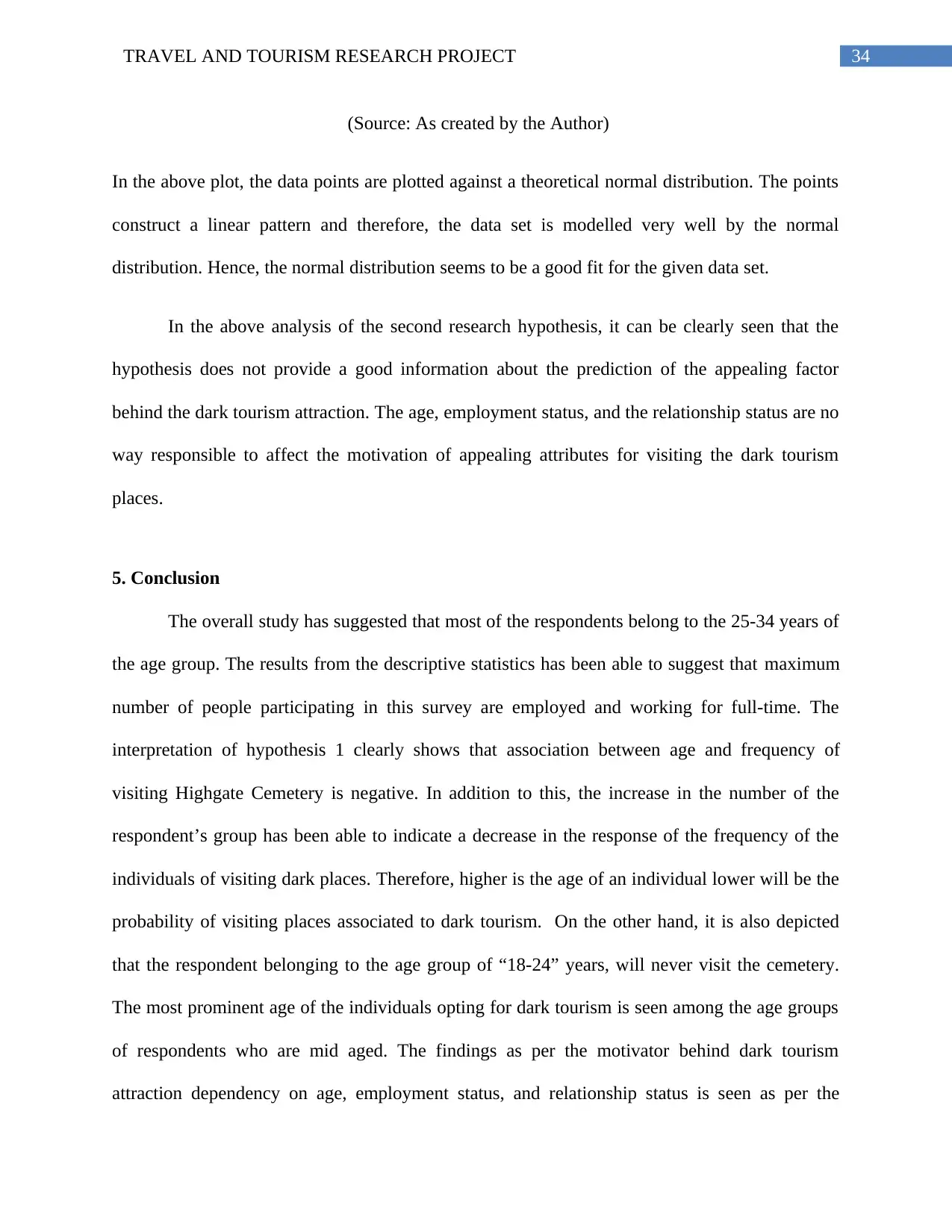
34TRAVEL AND TOURISM RESEARCH PROJECT
(Source: As created by the Author)
In the above plot, the data points are plotted against a theoretical normal distribution. The points
construct a linear pattern and therefore, the data set is modelled very well by the normal
distribution. Hence, the normal distribution seems to be a good fit for the given data set.
In the above analysis of the second research hypothesis, it can be clearly seen that the
hypothesis does not provide a good information about the prediction of the appealing factor
behind the dark tourism attraction. The age, employment status, and the relationship status are no
way responsible to affect the motivation of appealing attributes for visiting the dark tourism
places.
5. Conclusion
The overall study has suggested that most of the respondents belong to the 25-34 years of
the age group. The results from the descriptive statistics has been able to suggest that maximum
number of people participating in this survey are employed and working for full-time. The
interpretation of hypothesis 1 clearly shows that association between age and frequency of
visiting Highgate Cemetery is negative. In addition to this, the increase in the number of the
respondent’s group has been able to indicate a decrease in the response of the frequency of the
individuals of visiting dark places. Therefore, higher is the age of an individual lower will be the
probability of visiting places associated to dark tourism. On the other hand, it is also depicted
that the respondent belonging to the age group of “18-24” years, will never visit the cemetery.
The most prominent age of the individuals opting for dark tourism is seen among the age groups
of respondents who are mid aged. The findings as per the motivator behind dark tourism
attraction dependency on age, employment status, and relationship status is seen as per the
(Source: As created by the Author)
In the above plot, the data points are plotted against a theoretical normal distribution. The points
construct a linear pattern and therefore, the data set is modelled very well by the normal
distribution. Hence, the normal distribution seems to be a good fit for the given data set.
In the above analysis of the second research hypothesis, it can be clearly seen that the
hypothesis does not provide a good information about the prediction of the appealing factor
behind the dark tourism attraction. The age, employment status, and the relationship status are no
way responsible to affect the motivation of appealing attributes for visiting the dark tourism
places.
5. Conclusion
The overall study has suggested that most of the respondents belong to the 25-34 years of
the age group. The results from the descriptive statistics has been able to suggest that maximum
number of people participating in this survey are employed and working for full-time. The
interpretation of hypothesis 1 clearly shows that association between age and frequency of
visiting Highgate Cemetery is negative. In addition to this, the increase in the number of the
respondent’s group has been able to indicate a decrease in the response of the frequency of the
individuals of visiting dark places. Therefore, higher is the age of an individual lower will be the
probability of visiting places associated to dark tourism. On the other hand, it is also depicted
that the respondent belonging to the age group of “18-24” years, will never visit the cemetery.
The most prominent age of the individuals opting for dark tourism is seen among the age groups
of respondents who are mid aged. The findings as per the motivator behind dark tourism
attraction dependency on age, employment status, and relationship status is seen as per the
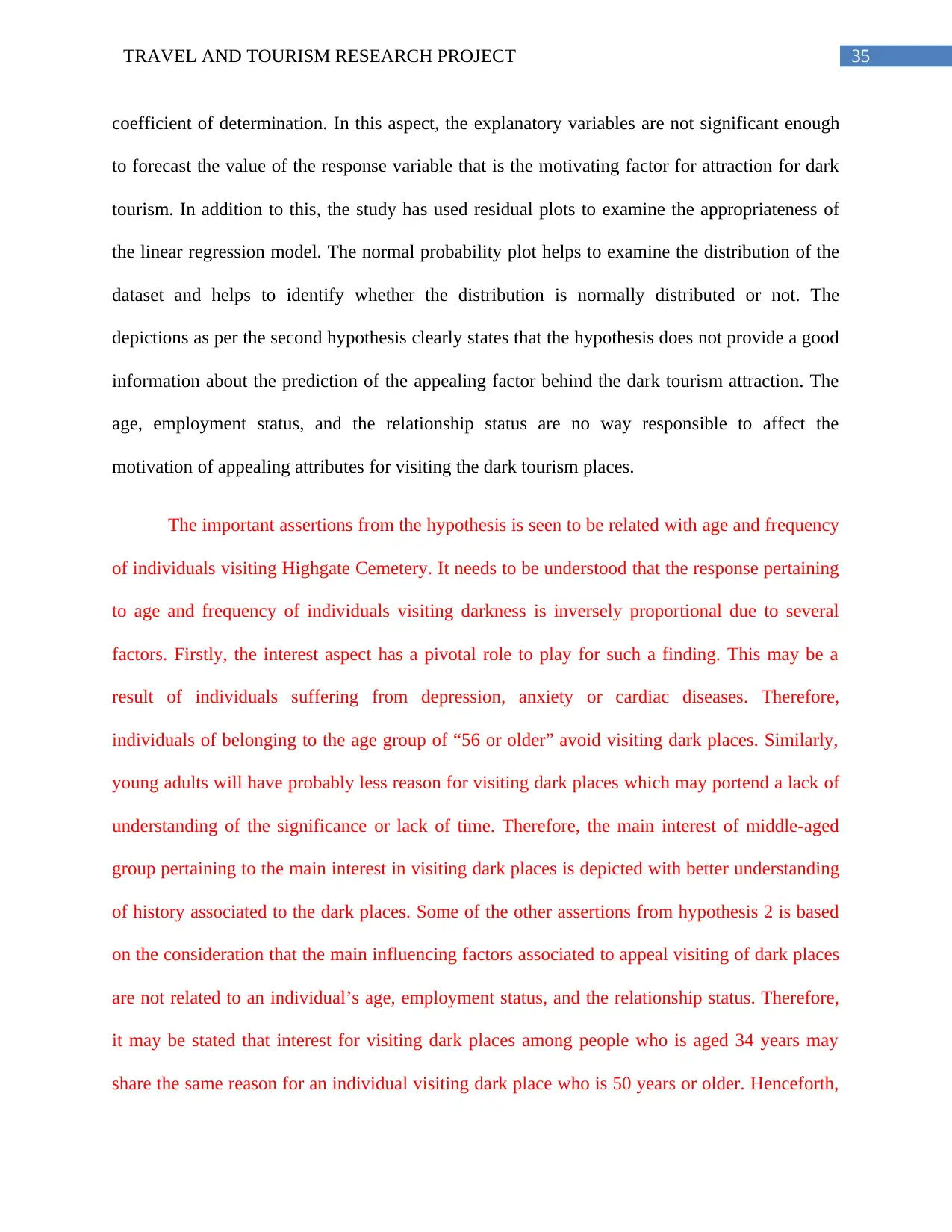
35TRAVEL AND TOURISM RESEARCH PROJECT
coefficient of determination. In this aspect, the explanatory variables are not significant enough
to forecast the value of the response variable that is the motivating factor for attraction for dark
tourism. In addition to this, the study has used residual plots to examine the appropriateness of
the linear regression model. The normal probability plot helps to examine the distribution of the
dataset and helps to identify whether the distribution is normally distributed or not. The
depictions as per the second hypothesis clearly states that the hypothesis does not provide a good
information about the prediction of the appealing factor behind the dark tourism attraction. The
age, employment status, and the relationship status are no way responsible to affect the
motivation of appealing attributes for visiting the dark tourism places.
The important assertions from the hypothesis is seen to be related with age and frequency
of individuals visiting Highgate Cemetery. It needs to be understood that the response pertaining
to age and frequency of individuals visiting darkness is inversely proportional due to several
factors. Firstly, the interest aspect has a pivotal role to play for such a finding. This may be a
result of individuals suffering from depression, anxiety or cardiac diseases. Therefore,
individuals of belonging to the age group of “56 or older” avoid visiting dark places. Similarly,
young adults will have probably less reason for visiting dark places which may portend a lack of
understanding of the significance or lack of time. Therefore, the main interest of middle-aged
group pertaining to the main interest in visiting dark places is depicted with better understanding
of history associated to the dark places. Some of the other assertions from hypothesis 2 is based
on the consideration that the main influencing factors associated to appeal visiting of dark places
are not related to an individual’s age, employment status, and the relationship status. Therefore,
it may be stated that interest for visiting dark places among people who is aged 34 years may
share the same reason for an individual visiting dark place who is 50 years or older. Henceforth,
coefficient of determination. In this aspect, the explanatory variables are not significant enough
to forecast the value of the response variable that is the motivating factor for attraction for dark
tourism. In addition to this, the study has used residual plots to examine the appropriateness of
the linear regression model. The normal probability plot helps to examine the distribution of the
dataset and helps to identify whether the distribution is normally distributed or not. The
depictions as per the second hypothesis clearly states that the hypothesis does not provide a good
information about the prediction of the appealing factor behind the dark tourism attraction. The
age, employment status, and the relationship status are no way responsible to affect the
motivation of appealing attributes for visiting the dark tourism places.
The important assertions from the hypothesis is seen to be related with age and frequency
of individuals visiting Highgate Cemetery. It needs to be understood that the response pertaining
to age and frequency of individuals visiting darkness is inversely proportional due to several
factors. Firstly, the interest aspect has a pivotal role to play for such a finding. This may be a
result of individuals suffering from depression, anxiety or cardiac diseases. Therefore,
individuals of belonging to the age group of “56 or older” avoid visiting dark places. Similarly,
young adults will have probably less reason for visiting dark places which may portend a lack of
understanding of the significance or lack of time. Therefore, the main interest of middle-aged
group pertaining to the main interest in visiting dark places is depicted with better understanding
of history associated to the dark places. Some of the other assertions from hypothesis 2 is based
on the consideration that the main influencing factors associated to appeal visiting of dark places
are not related to an individual’s age, employment status, and the relationship status. Therefore,
it may be stated that interest for visiting dark places among people who is aged 34 years may
share the same reason for an individual visiting dark place who is 50 years or older. Henceforth,
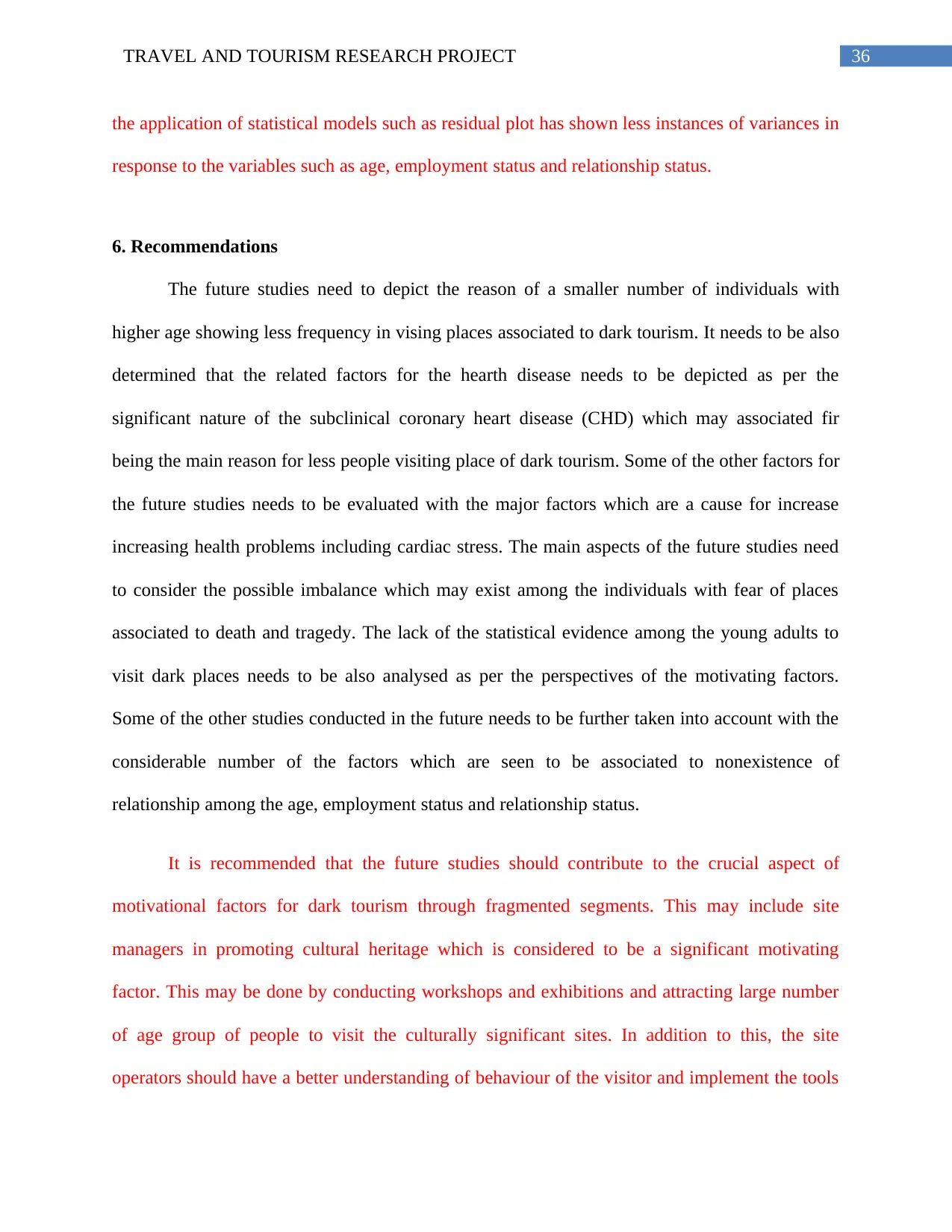
36TRAVEL AND TOURISM RESEARCH PROJECT
the application of statistical models such as residual plot has shown less instances of variances in
response to the variables such as age, employment status and relationship status.
6. Recommendations
The future studies need to depict the reason of a smaller number of individuals with
higher age showing less frequency in vising places associated to dark tourism. It needs to be also
determined that the related factors for the hearth disease needs to be depicted as per the
significant nature of the subclinical coronary heart disease (CHD) which may associated fir
being the main reason for less people visiting place of dark tourism. Some of the other factors for
the future studies needs to be evaluated with the major factors which are a cause for increase
increasing health problems including cardiac stress. The main aspects of the future studies need
to consider the possible imbalance which may exist among the individuals with fear of places
associated to death and tragedy. The lack of the statistical evidence among the young adults to
visit dark places needs to be also analysed as per the perspectives of the motivating factors.
Some of the other studies conducted in the future needs to be further taken into account with the
considerable number of the factors which are seen to be associated to nonexistence of
relationship among the age, employment status and relationship status.
It is recommended that the future studies should contribute to the crucial aspect of
motivational factors for dark tourism through fragmented segments. This may include site
managers in promoting cultural heritage which is considered to be a significant motivating
factor. This may be done by conducting workshops and exhibitions and attracting large number
of age group of people to visit the culturally significant sites. In addition to this, the site
operators should have a better understanding of behaviour of the visitor and implement the tools
the application of statistical models such as residual plot has shown less instances of variances in
response to the variables such as age, employment status and relationship status.
6. Recommendations
The future studies need to depict the reason of a smaller number of individuals with
higher age showing less frequency in vising places associated to dark tourism. It needs to be also
determined that the related factors for the hearth disease needs to be depicted as per the
significant nature of the subclinical coronary heart disease (CHD) which may associated fir
being the main reason for less people visiting place of dark tourism. Some of the other factors for
the future studies needs to be evaluated with the major factors which are a cause for increase
increasing health problems including cardiac stress. The main aspects of the future studies need
to consider the possible imbalance which may exist among the individuals with fear of places
associated to death and tragedy. The lack of the statistical evidence among the young adults to
visit dark places needs to be also analysed as per the perspectives of the motivating factors.
Some of the other studies conducted in the future needs to be further taken into account with the
considerable number of the factors which are seen to be associated to nonexistence of
relationship among the age, employment status and relationship status.
It is recommended that the future studies should contribute to the crucial aspect of
motivational factors for dark tourism through fragmented segments. This may include site
managers in promoting cultural heritage which is considered to be a significant motivating
factor. This may be done by conducting workshops and exhibitions and attracting large number
of age group of people to visit the culturally significant sites. In addition to this, the site
operators should have a better understanding of behaviour of the visitor and implement the tools
Paraphrase This Document
Need a fresh take? Get an instant paraphrase of this document with our AI Paraphraser
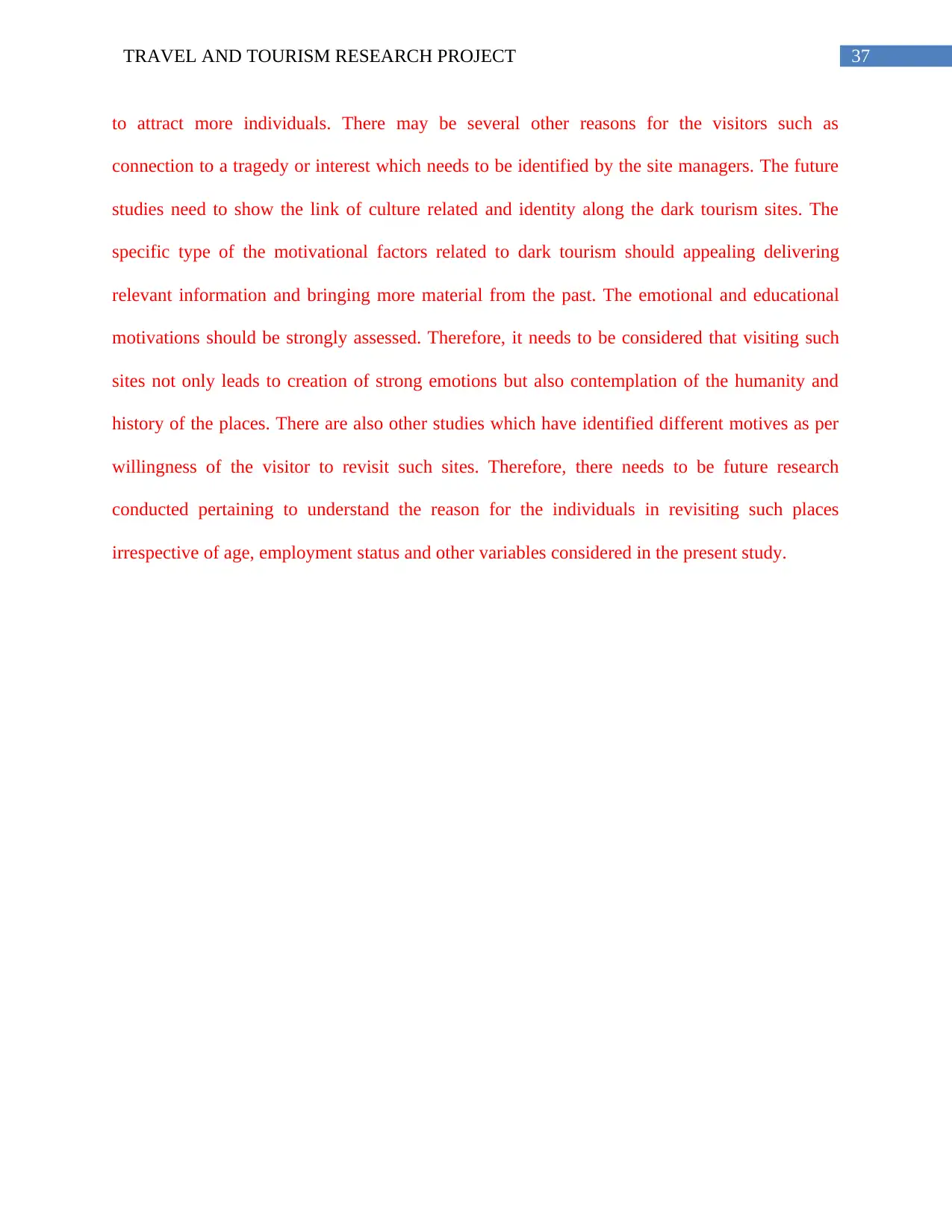
37TRAVEL AND TOURISM RESEARCH PROJECT
to attract more individuals. There may be several other reasons for the visitors such as
connection to a tragedy or interest which needs to be identified by the site managers. The future
studies need to show the link of culture related and identity along the dark tourism sites. The
specific type of the motivational factors related to dark tourism should appealing delivering
relevant information and bringing more material from the past. The emotional and educational
motivations should be strongly assessed. Therefore, it needs to be considered that visiting such
sites not only leads to creation of strong emotions but also contemplation of the humanity and
history of the places. There are also other studies which have identified different motives as per
willingness of the visitor to revisit such sites. Therefore, there needs to be future research
conducted pertaining to understand the reason for the individuals in revisiting such places
irrespective of age, employment status and other variables considered in the present study.
to attract more individuals. There may be several other reasons for the visitors such as
connection to a tragedy or interest which needs to be identified by the site managers. The future
studies need to show the link of culture related and identity along the dark tourism sites. The
specific type of the motivational factors related to dark tourism should appealing delivering
relevant information and bringing more material from the past. The emotional and educational
motivations should be strongly assessed. Therefore, it needs to be considered that visiting such
sites not only leads to creation of strong emotions but also contemplation of the humanity and
history of the places. There are also other studies which have identified different motives as per
willingness of the visitor to revisit such sites. Therefore, there needs to be future research
conducted pertaining to understand the reason for the individuals in revisiting such places
irrespective of age, employment status and other variables considered in the present study.
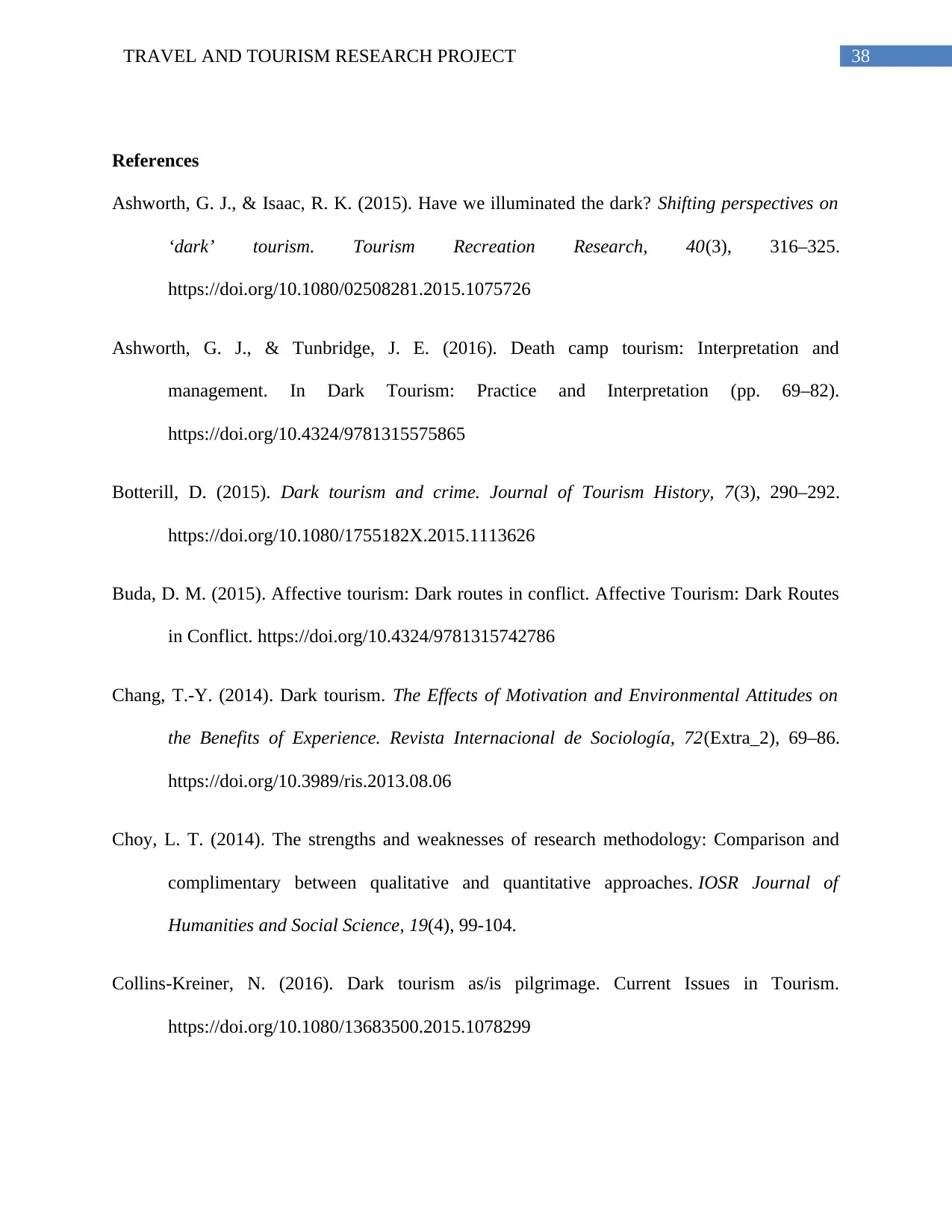
38TRAVEL AND TOURISM RESEARCH PROJECT
References
Ashworth, G. J., & Isaac, R. K. (2015). Have we illuminated the dark? Shifting perspectives on
‘dark’ tourism. Tourism Recreation Research, 40(3), 316–325.
https://doi.org/10.1080/02508281.2015.1075726
Ashworth, G. J., & Tunbridge, J. E. (2016). Death camp tourism: Interpretation and
management. In Dark Tourism: Practice and Interpretation (pp. 69–82).
https://doi.org/10.4324/9781315575865
Botterill, D. (2015). Dark tourism and crime. Journal of Tourism History, 7(3), 290–292.
https://doi.org/10.1080/1755182X.2015.1113626
Buda, D. M. (2015). Affective tourism: Dark routes in conflict. Affective Tourism: Dark Routes
in Conflict. https://doi.org/10.4324/9781315742786
Chang, T.-Y. (2014). Dark tourism. The Effects of Motivation and Environmental Attitudes on
the Benefits of Experience. Revista Internacional de Sociología, 72(Extra_2), 69–86.
https://doi.org/10.3989/ris.2013.08.06
Choy, L. T. (2014). The strengths and weaknesses of research methodology: Comparison and
complimentary between qualitative and quantitative approaches. IOSR Journal of
Humanities and Social Science, 19(4), 99-104.
Collins-Kreiner, N. (2016). Dark tourism as/is pilgrimage. Current Issues in Tourism.
https://doi.org/10.1080/13683500.2015.1078299
References
Ashworth, G. J., & Isaac, R. K. (2015). Have we illuminated the dark? Shifting perspectives on
‘dark’ tourism. Tourism Recreation Research, 40(3), 316–325.
https://doi.org/10.1080/02508281.2015.1075726
Ashworth, G. J., & Tunbridge, J. E. (2016). Death camp tourism: Interpretation and
management. In Dark Tourism: Practice and Interpretation (pp. 69–82).
https://doi.org/10.4324/9781315575865
Botterill, D. (2015). Dark tourism and crime. Journal of Tourism History, 7(3), 290–292.
https://doi.org/10.1080/1755182X.2015.1113626
Buda, D. M. (2015). Affective tourism: Dark routes in conflict. Affective Tourism: Dark Routes
in Conflict. https://doi.org/10.4324/9781315742786
Chang, T.-Y. (2014). Dark tourism. The Effects of Motivation and Environmental Attitudes on
the Benefits of Experience. Revista Internacional de Sociología, 72(Extra_2), 69–86.
https://doi.org/10.3989/ris.2013.08.06
Choy, L. T. (2014). The strengths and weaknesses of research methodology: Comparison and
complimentary between qualitative and quantitative approaches. IOSR Journal of
Humanities and Social Science, 19(4), 99-104.
Collins-Kreiner, N. (2016). Dark tourism as/is pilgrimage. Current Issues in Tourism.
https://doi.org/10.1080/13683500.2015.1078299
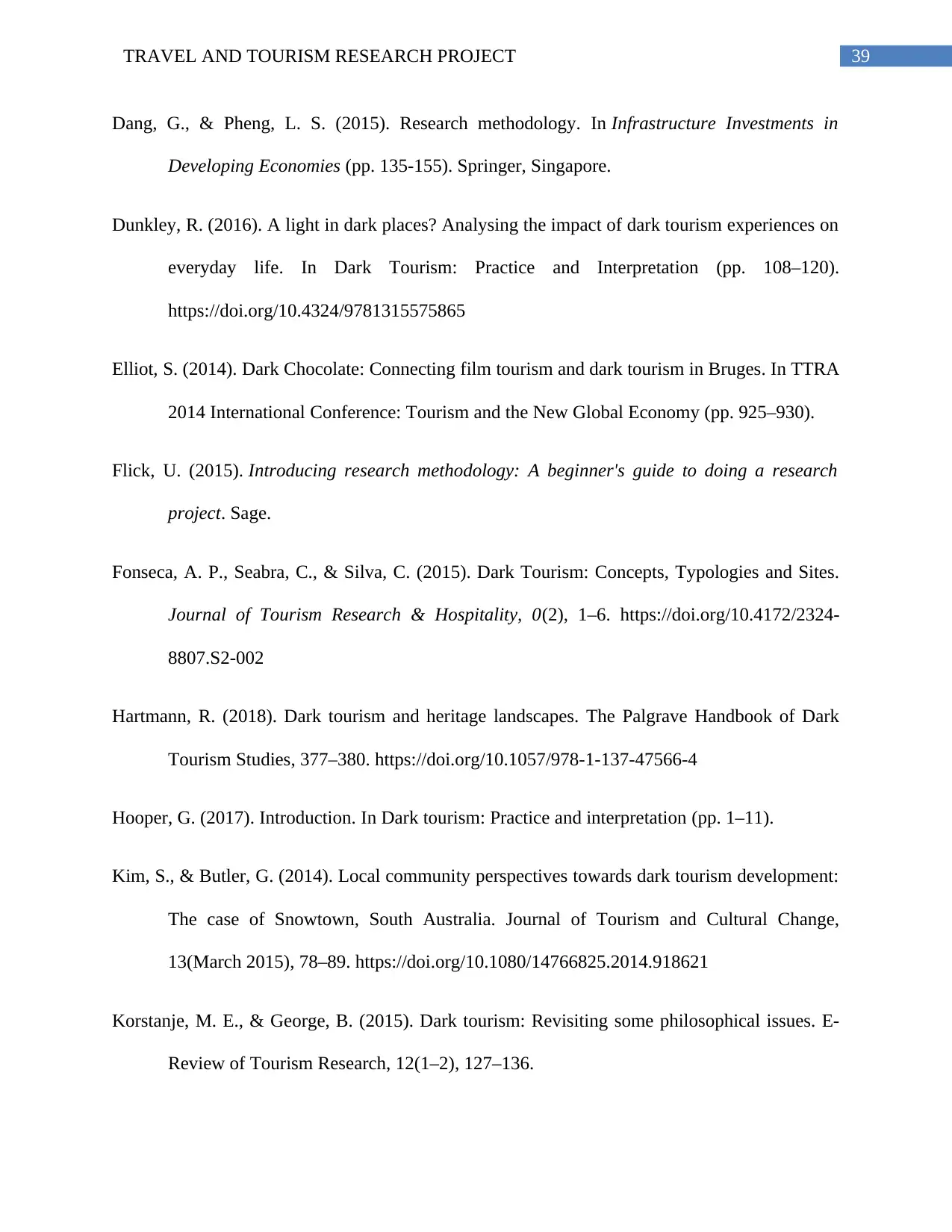
39TRAVEL AND TOURISM RESEARCH PROJECT
Dang, G., & Pheng, L. S. (2015). Research methodology. In Infrastructure Investments in
Developing Economies (pp. 135-155). Springer, Singapore.
Dunkley, R. (2016). A light in dark places? Analysing the impact of dark tourism experiences on
everyday life. In Dark Tourism: Practice and Interpretation (pp. 108–120).
https://doi.org/10.4324/9781315575865
Elliot, S. (2014). Dark Chocolate: Connecting film tourism and dark tourism in Bruges. In TTRA
2014 International Conference: Tourism and the New Global Economy (pp. 925–930).
Flick, U. (2015). Introducing research methodology: A beginner's guide to doing a research
project. Sage.
Fonseca, A. P., Seabra, C., & Silva, C. (2015). Dark Tourism: Concepts, Typologies and Sites.
Journal of Tourism Research & Hospitality, 0(2), 1–6. https://doi.org/10.4172/2324-
8807.S2-002
Hartmann, R. (2018). Dark tourism and heritage landscapes. The Palgrave Handbook of Dark
Tourism Studies, 377–380. https://doi.org/10.1057/978-1-137-47566-4
Hooper, G. (2017). Introduction. In Dark tourism: Practice and interpretation (pp. 1–11).
Kim, S., & Butler, G. (2014). Local community perspectives towards dark tourism development:
The case of Snowtown, South Australia. Journal of Tourism and Cultural Change,
13(March 2015), 78–89. https://doi.org/10.1080/14766825.2014.918621
Korstanje, M. E., & George, B. (2015). Dark tourism: Revisiting some philosophical issues. E-
Review of Tourism Research, 12(1–2), 127–136.
Dang, G., & Pheng, L. S. (2015). Research methodology. In Infrastructure Investments in
Developing Economies (pp. 135-155). Springer, Singapore.
Dunkley, R. (2016). A light in dark places? Analysing the impact of dark tourism experiences on
everyday life. In Dark Tourism: Practice and Interpretation (pp. 108–120).
https://doi.org/10.4324/9781315575865
Elliot, S. (2014). Dark Chocolate: Connecting film tourism and dark tourism in Bruges. In TTRA
2014 International Conference: Tourism and the New Global Economy (pp. 925–930).
Flick, U. (2015). Introducing research methodology: A beginner's guide to doing a research
project. Sage.
Fonseca, A. P., Seabra, C., & Silva, C. (2015). Dark Tourism: Concepts, Typologies and Sites.
Journal of Tourism Research & Hospitality, 0(2), 1–6. https://doi.org/10.4172/2324-
8807.S2-002
Hartmann, R. (2018). Dark tourism and heritage landscapes. The Palgrave Handbook of Dark
Tourism Studies, 377–380. https://doi.org/10.1057/978-1-137-47566-4
Hooper, G. (2017). Introduction. In Dark tourism: Practice and interpretation (pp. 1–11).
Kim, S., & Butler, G. (2014). Local community perspectives towards dark tourism development:
The case of Snowtown, South Australia. Journal of Tourism and Cultural Change,
13(March 2015), 78–89. https://doi.org/10.1080/14766825.2014.918621
Korstanje, M. E., & George, B. (2015). Dark tourism: Revisiting some philosophical issues. E-
Review of Tourism Research, 12(1–2), 127–136.
Secure Best Marks with AI Grader
Need help grading? Try our AI Grader for instant feedback on your assignments.
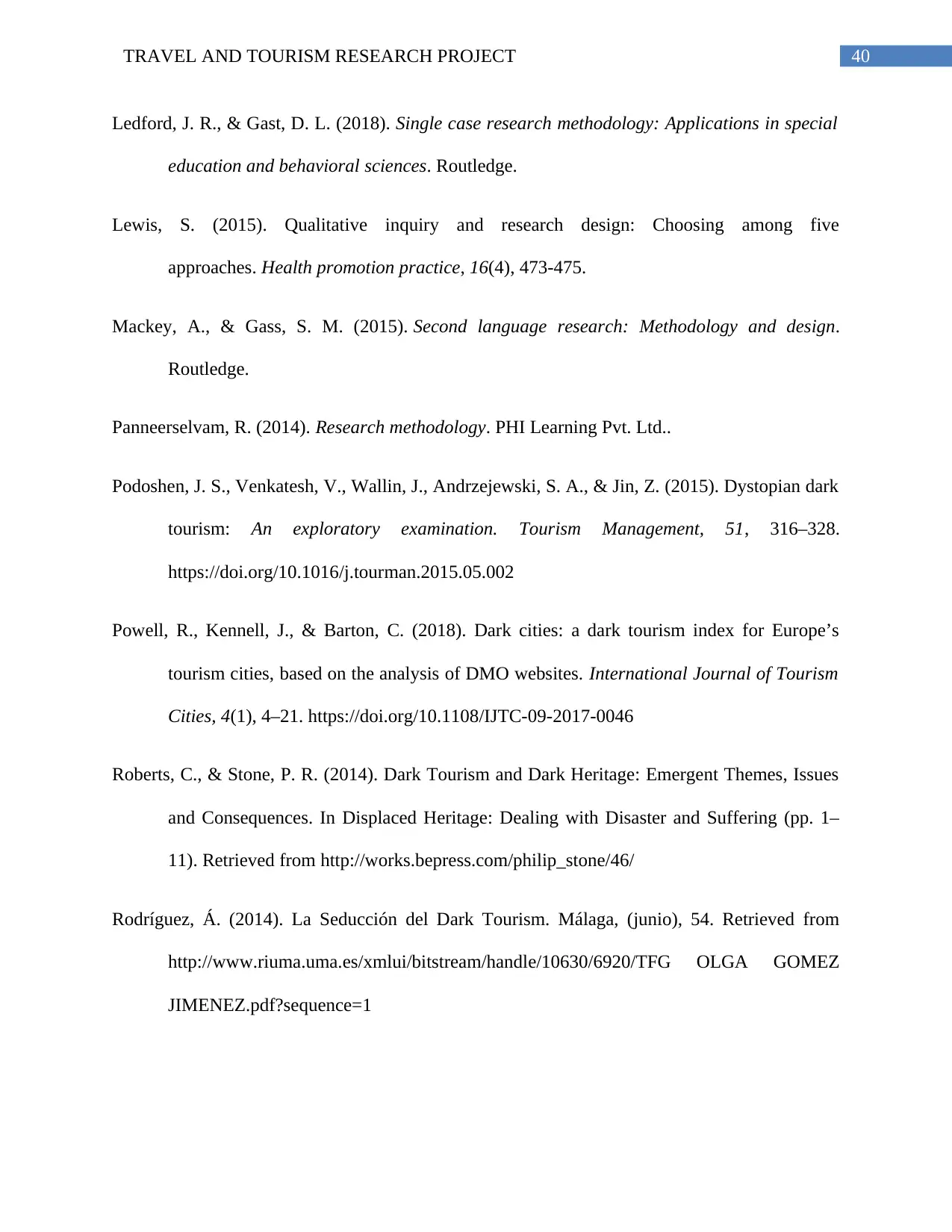
40TRAVEL AND TOURISM RESEARCH PROJECT
Ledford, J. R., & Gast, D. L. (2018). Single case research methodology: Applications in special
education and behavioral sciences. Routledge.
Lewis, S. (2015). Qualitative inquiry and research design: Choosing among five
approaches. Health promotion practice, 16(4), 473-475.
Mackey, A., & Gass, S. M. (2015). Second language research: Methodology and design.
Routledge.
Panneerselvam, R. (2014). Research methodology. PHI Learning Pvt. Ltd..
Podoshen, J. S., Venkatesh, V., Wallin, J., Andrzejewski, S. A., & Jin, Z. (2015). Dystopian dark
tourism: An exploratory examination. Tourism Management, 51, 316–328.
https://doi.org/10.1016/j.tourman.2015.05.002
Powell, R., Kennell, J., & Barton, C. (2018). Dark cities: a dark tourism index for Europe’s
tourism cities, based on the analysis of DMO websites. International Journal of Tourism
Cities, 4(1), 4–21. https://doi.org/10.1108/IJTC-09-2017-0046
Roberts, C., & Stone, P. R. (2014). Dark Tourism and Dark Heritage: Emergent Themes, Issues
and Consequences. In Displaced Heritage: Dealing with Disaster and Suffering (pp. 1–
11). Retrieved from http://works.bepress.com/philip_stone/46/
Rodríguez, Á. (2014). La Seducción del Dark Tourism. Málaga, (junio), 54. Retrieved from
http://www.riuma.uma.es/xmlui/bitstream/handle/10630/6920/TFG OLGA GOMEZ
JIMENEZ.pdf?sequence=1
Ledford, J. R., & Gast, D. L. (2018). Single case research methodology: Applications in special
education and behavioral sciences. Routledge.
Lewis, S. (2015). Qualitative inquiry and research design: Choosing among five
approaches. Health promotion practice, 16(4), 473-475.
Mackey, A., & Gass, S. M. (2015). Second language research: Methodology and design.
Routledge.
Panneerselvam, R. (2014). Research methodology. PHI Learning Pvt. Ltd..
Podoshen, J. S., Venkatesh, V., Wallin, J., Andrzejewski, S. A., & Jin, Z. (2015). Dystopian dark
tourism: An exploratory examination. Tourism Management, 51, 316–328.
https://doi.org/10.1016/j.tourman.2015.05.002
Powell, R., Kennell, J., & Barton, C. (2018). Dark cities: a dark tourism index for Europe’s
tourism cities, based on the analysis of DMO websites. International Journal of Tourism
Cities, 4(1), 4–21. https://doi.org/10.1108/IJTC-09-2017-0046
Roberts, C., & Stone, P. R. (2014). Dark Tourism and Dark Heritage: Emergent Themes, Issues
and Consequences. In Displaced Heritage: Dealing with Disaster and Suffering (pp. 1–
11). Retrieved from http://works.bepress.com/philip_stone/46/
Rodríguez, Á. (2014). La Seducción del Dark Tourism. Málaga, (junio), 54. Retrieved from
http://www.riuma.uma.es/xmlui/bitstream/handle/10630/6920/TFG OLGA GOMEZ
JIMENEZ.pdf?sequence=1
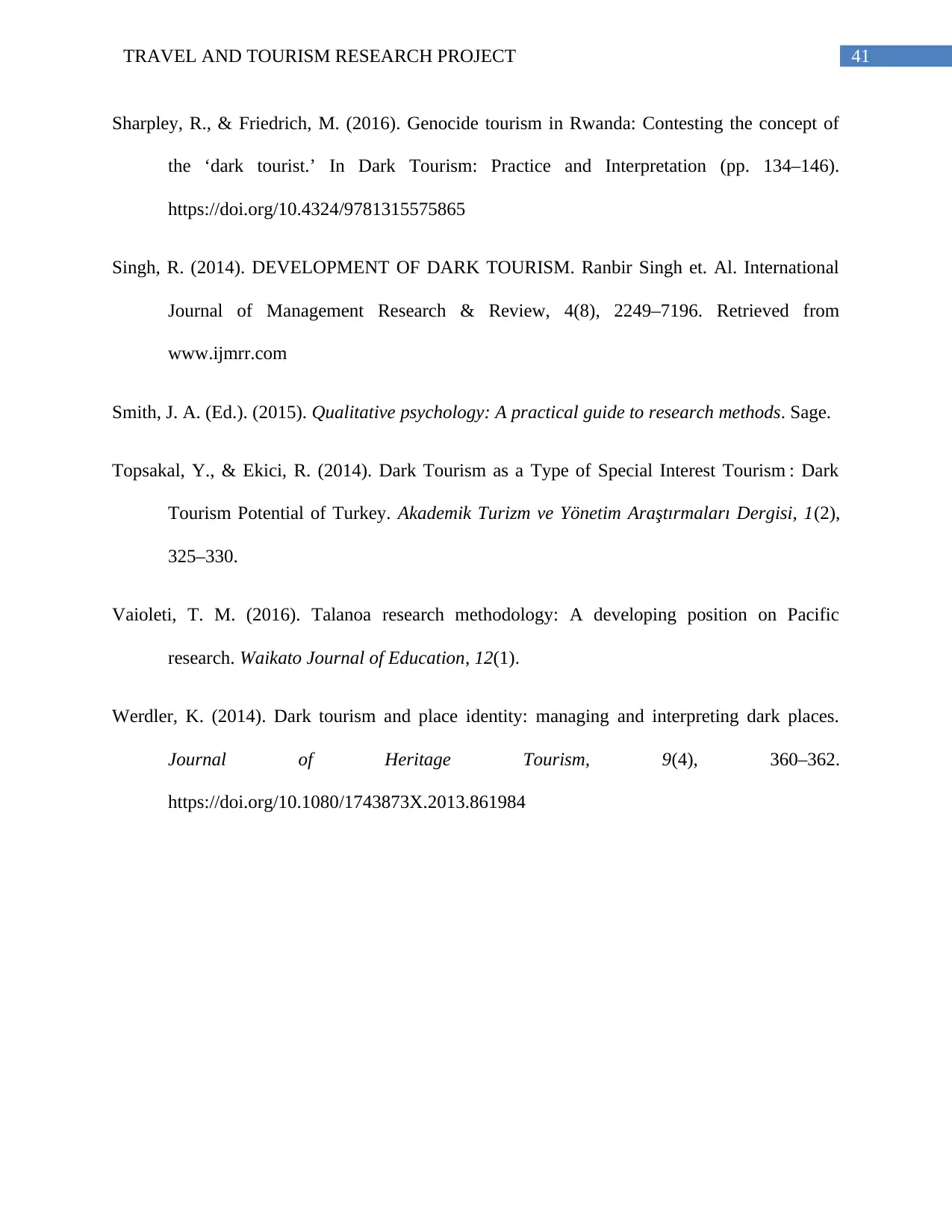
41TRAVEL AND TOURISM RESEARCH PROJECT
Sharpley, R., & Friedrich, M. (2016). Genocide tourism in Rwanda: Contesting the concept of
the ‘dark tourist.’ In Dark Tourism: Practice and Interpretation (pp. 134–146).
https://doi.org/10.4324/9781315575865
Singh, R. (2014). DEVELOPMENT OF DARK TOURISM. Ranbir Singh et. Al. International
Journal of Management Research & Review, 4(8), 2249–7196. Retrieved from
www.ijmrr.com
Smith, J. A. (Ed.). (2015). Qualitative psychology: A practical guide to research methods. Sage.
Topsakal, Y., & Ekici, R. (2014). Dark Tourism as a Type of Special Interest Tourism : Dark
Tourism Potential of Turkey. Akademik Turizm ve Yönetim Araştırmaları Dergisi, 1(2),
325–330.
Vaioleti, T. M. (2016). Talanoa research methodology: A developing position on Pacific
research. Waikato Journal of Education, 12(1).
Werdler, K. (2014). Dark tourism and place identity: managing and interpreting dark places.
Journal of Heritage Tourism, 9(4), 360–362.
https://doi.org/10.1080/1743873X.2013.861984
Sharpley, R., & Friedrich, M. (2016). Genocide tourism in Rwanda: Contesting the concept of
the ‘dark tourist.’ In Dark Tourism: Practice and Interpretation (pp. 134–146).
https://doi.org/10.4324/9781315575865
Singh, R. (2014). DEVELOPMENT OF DARK TOURISM. Ranbir Singh et. Al. International
Journal of Management Research & Review, 4(8), 2249–7196. Retrieved from
www.ijmrr.com
Smith, J. A. (Ed.). (2015). Qualitative psychology: A practical guide to research methods. Sage.
Topsakal, Y., & Ekici, R. (2014). Dark Tourism as a Type of Special Interest Tourism : Dark
Tourism Potential of Turkey. Akademik Turizm ve Yönetim Araştırmaları Dergisi, 1(2),
325–330.
Vaioleti, T. M. (2016). Talanoa research methodology: A developing position on Pacific
research. Waikato Journal of Education, 12(1).
Werdler, K. (2014). Dark tourism and place identity: managing and interpreting dark places.
Journal of Heritage Tourism, 9(4), 360–362.
https://doi.org/10.1080/1743873X.2013.861984
1 out of 42
Related Documents
Your All-in-One AI-Powered Toolkit for Academic Success.
+13062052269
info@desklib.com
Available 24*7 on WhatsApp / Email
![[object Object]](/_next/static/media/star-bottom.7253800d.svg)
Unlock your academic potential
© 2024 | Zucol Services PVT LTD | All rights reserved.





